HISTORY OF ARTS IN MEDIEVAL AND RENAISSANCE ITALY
1/195
There's no tags or description
Looks like no tags are added yet.
Name | Mastery | Learn | Test | Matching | Spaced |
|---|
No study sessions yet.
196 Terms
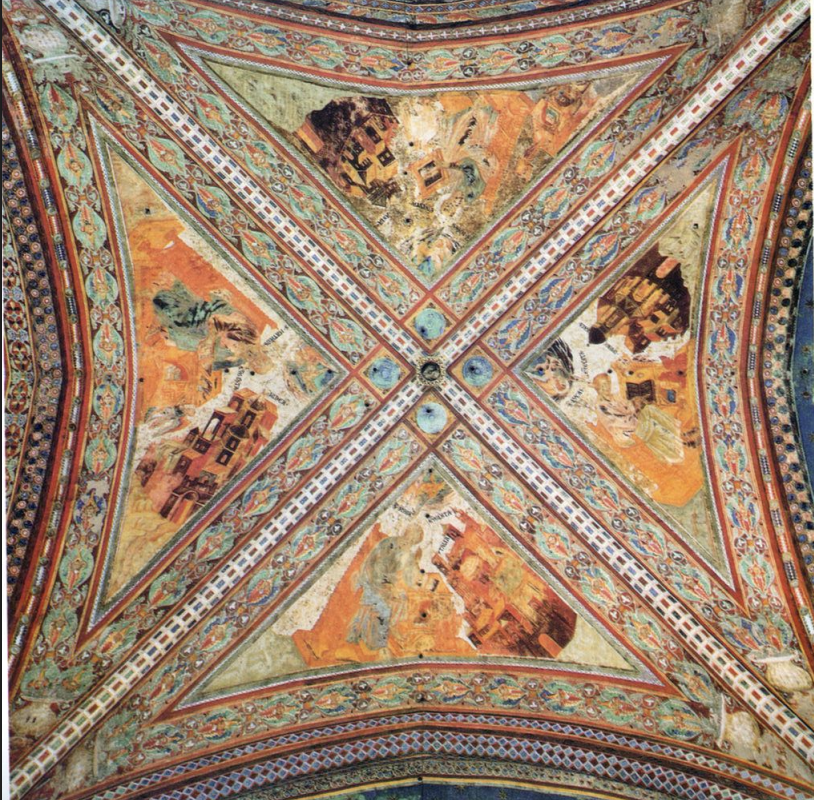
Cimabue
Vault of the Four Evangelists
Fresco, 1277-1283
Assisi, San Francesco’s Basilica
Summarized symbolic image/idea of Italy, represented by roman monuments, Pantheon, St Peter’s Basilica,
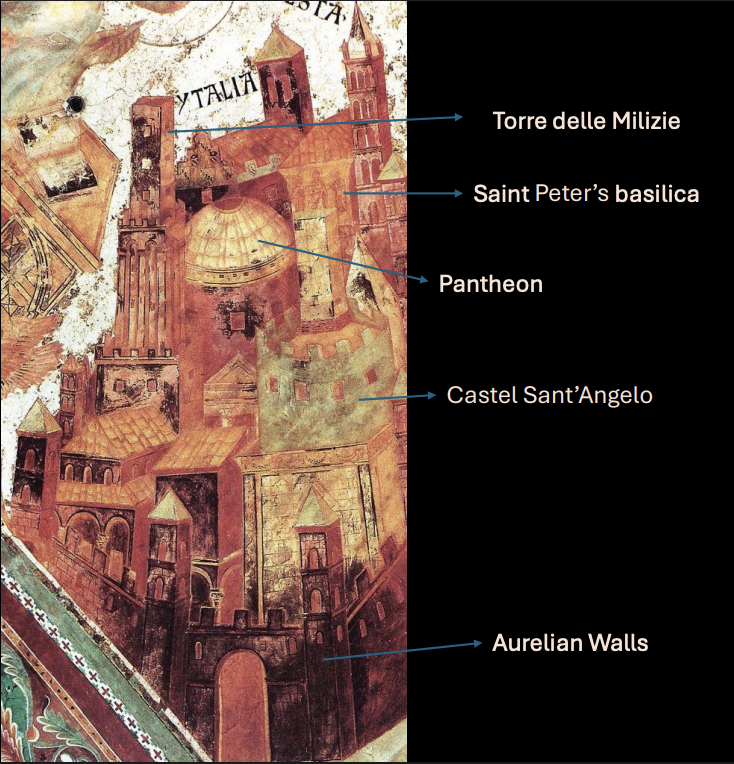
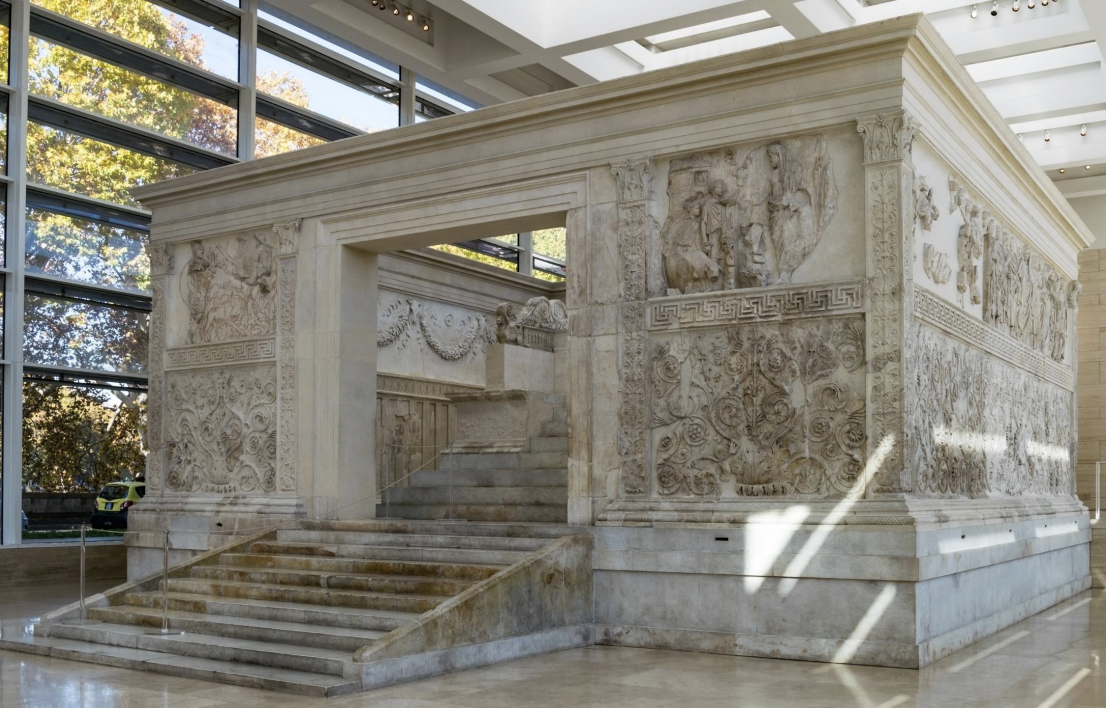
Ara Pacis Augustae (Altar of Peace of Augustus)
9 BCE, Rome
Devoted to Emperor Augustus
Was a way to celebrate peace, after Augustus killed all possible enemies
Created good propaganda around himself and his government
Classic Roman style
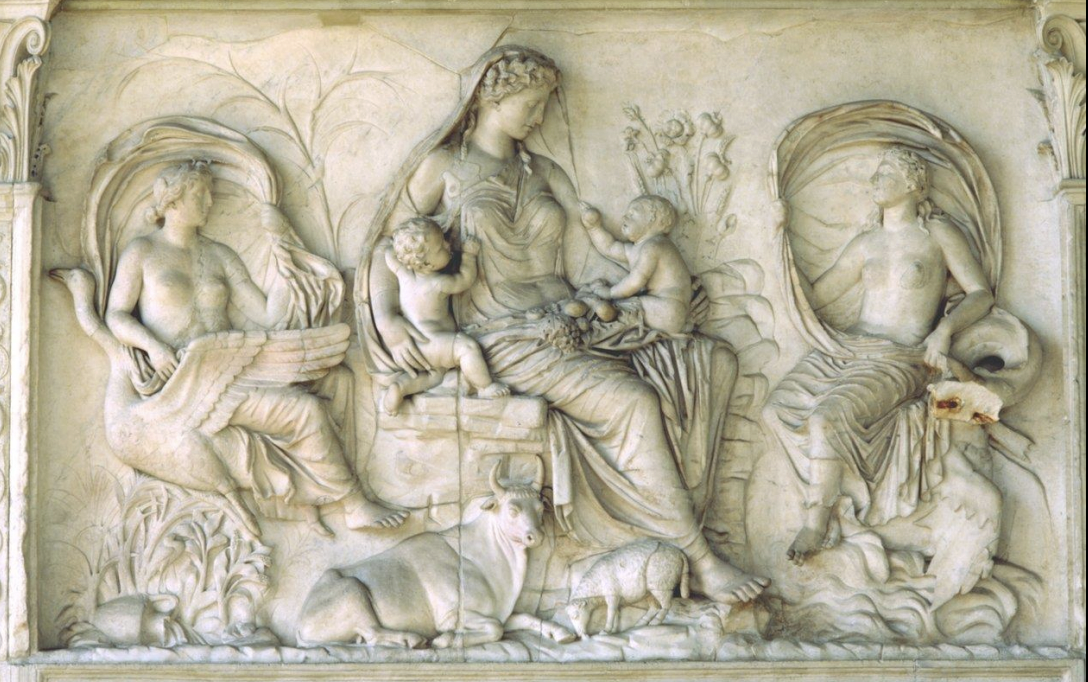
From the Ara pacis Augustae
Allegory of the Golden Age
Goddess Earth, surrounded by air on the left and water on the right
Naturalistic elements including animals, children, women
All incredibly idealized
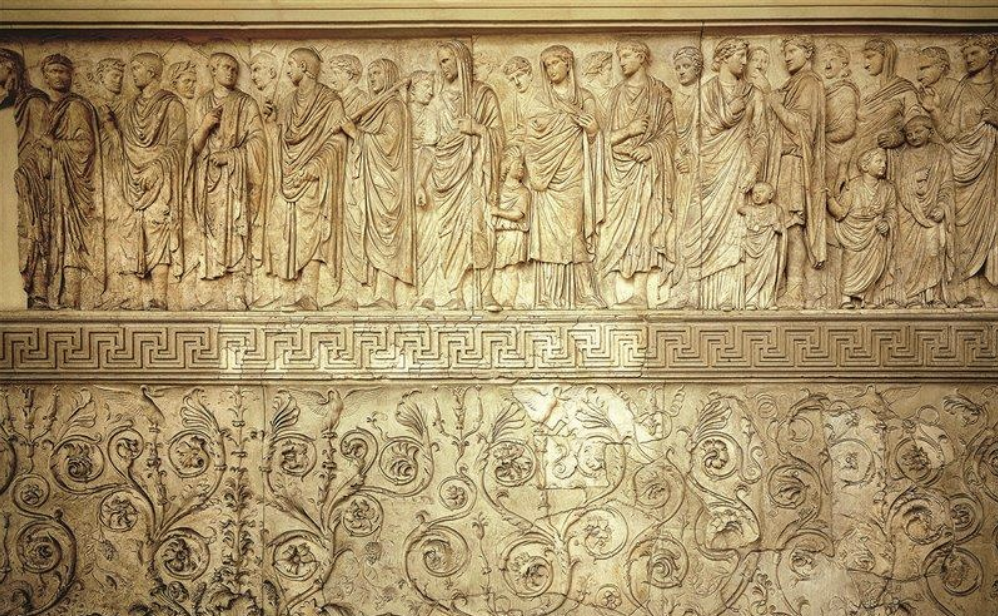
Ritual procession of Augustus and his family
The procession portrayed many recognizable people including Augustus the emperor who was political and religious authority, performing sacrifice thanking gods for peace
Following is his family
Love for art portraying individual people
Below are the decorative panels that show garlands and vegetables
Italian and European arts use decorative patterns coming from Roman times
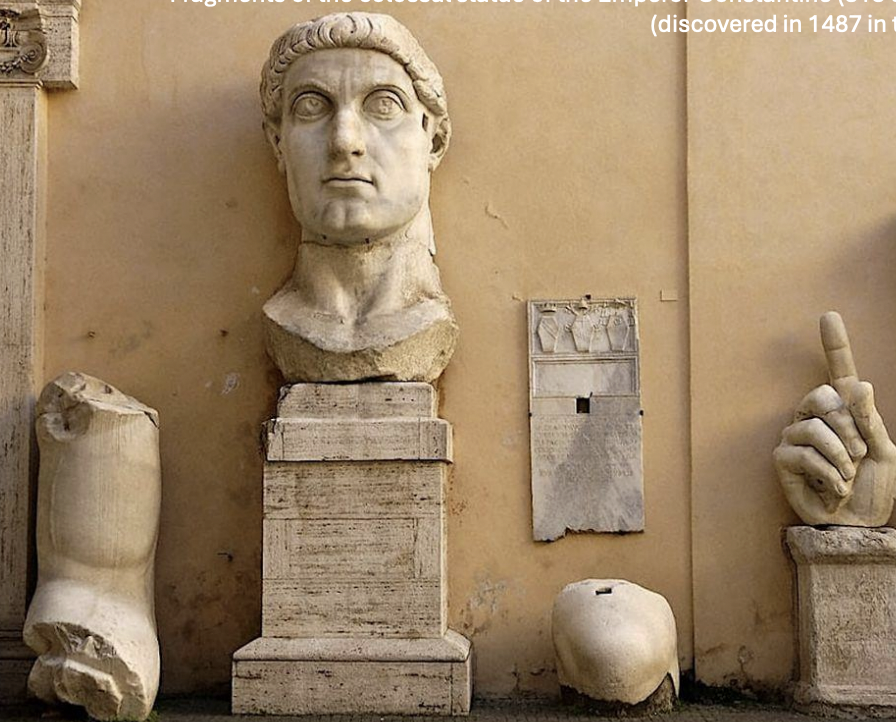
Fragments of the colossal statue of the Emperor Constantine
Rome
Discovered in 1487 in the Roman Forum
Constantine: deciding in 3013 to proclaim giving christians the opportunity to have recognition, later became christian, from then on christians were not prosecuted and instead became a christian place
Constantine emperor played with compromise, did not want to abandon pagen traditions but also understood christian mentality and relgions was the future of his empire
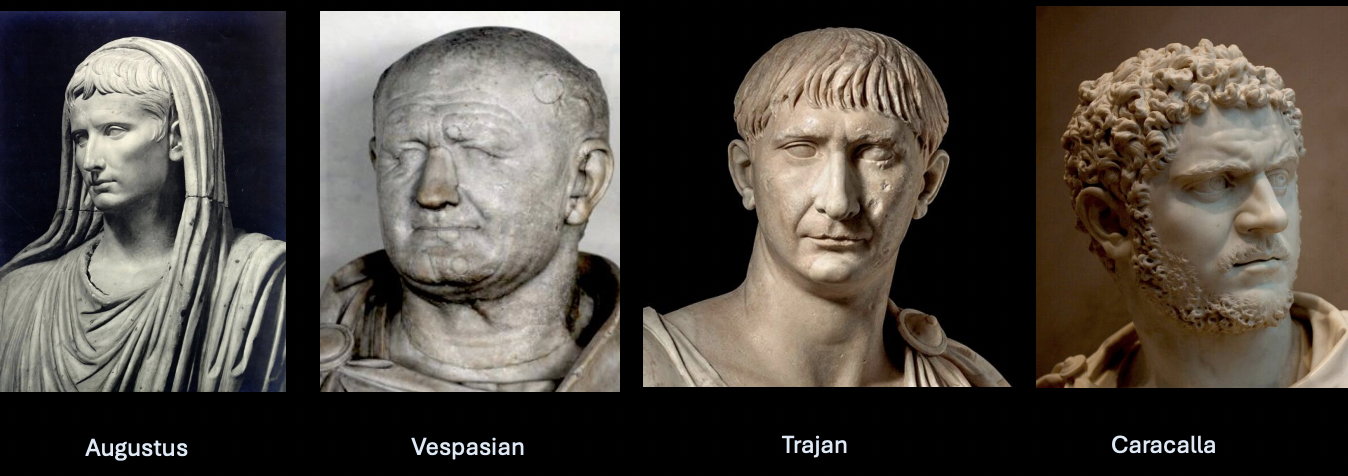
Emperors who ruled from the 1st to 3rd century
Faces include Augustus, Vespisian, trajan, Caracalla
Second slide, changed Constantine’s face, making peoples faces recognizable is no more
Two peculiar faces have big eyes but other features are changed
Why did they change his face? Because christian art is a mirror of christian mentality and that in the beginning is being different from paganism
Pagan art had fought so much on realism and recognizable faces
Christians said earth is world of imperfection, has to transcend earth to reach spiritual level, don't count as individuals but count the soul
Can see in christian art is trying to transcend reality

Hagia Sophia
Originally church, then a mosque (from 1453), a museum (from 1935), now a mosque
Built by constantine, damaged by earthquakes and destroyed during revolt, rebuilt by Hustinian
Focus is how this is different than other european basilicas
Interesting is the concept of space, many windows so that it feels like the dome is floating, also full of light, becomes spiritual emotion
Buttresses – preserve the structure of the dome
Emperor's door – precious marbles and materials
Gold
Surviving mosaics: Mary with Child the the emperors Constantine and Justinian offering the city of Constantinople and Hagia Sophia
Another mosaic: Christ enthrones with emperors offering money on one side and a scrawl, the rights to the church, unique opportunities and keeping status
Third mosaic: virgin Mary and child with emperors John II Comnen and Irene. Even though faces are recognizable but image is flat, much less idealized.
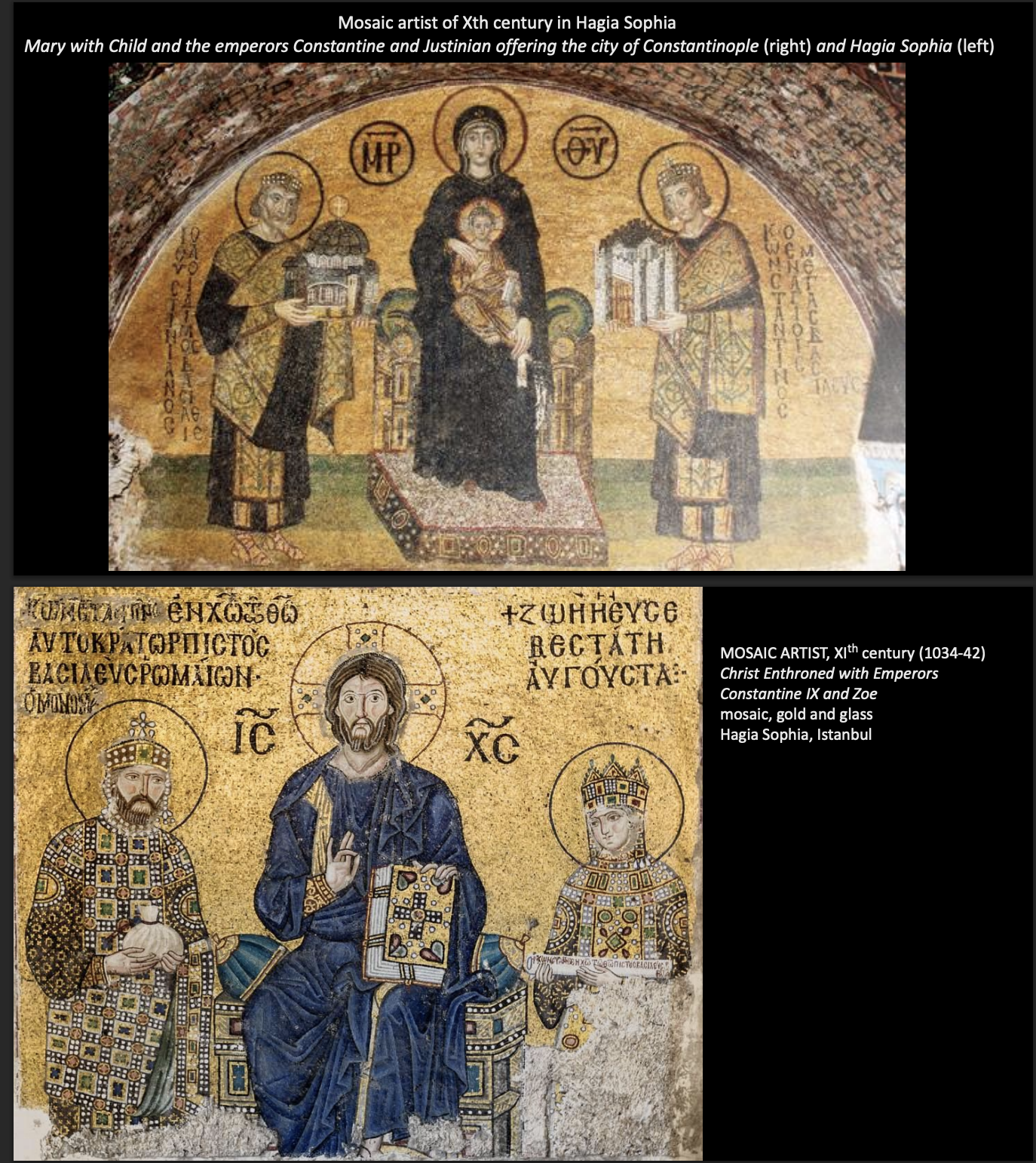
Ravenna
Surrounded by a lagoon
Important port that allowed perfect navigation to Constantinople
One of the most visited cities in this area because many areas that remind of 5th and 6th century
San Vitale – view of the presbytery and the apse
To be appropriate to give experience of what eternity could be
The reason why mosaics are used and how its linked to religion
Mosaics are expensive, such a labor heavy technique and also a result that only stained glass is able to replicate with the same feeling that people receive
San Vitale
Central plan for the building, like Hagia Sophia
Central plan does not give as much authority
Italian church style:
Have more authority when someone walks in
People gathered and in front people celebrate mass, more easy and comfortable to see mass, has practicality
In central plan, people have to turn their heads more and view may be obstructed
Perfection related to God which connects to the building
Diagonal line on the bottom to the right is the side entrance which was typical of bisontine culture
Circle for christian culture and beyond means perfection
Octogon has to do with 7 days of creation, 1 day of rest, symbol of creation and what god did to create
Giving faithful or viewer experience of being overwhelmed by space aims to change visual perspective
Mosaics give different atmosphere full of life, without measurable dimenstions
Gold background:
expensive and full of light material
also they put the ties at the slight angle in order to reflect light, shimmer effect, trick they used in that period
Gold = paradise, eternal light
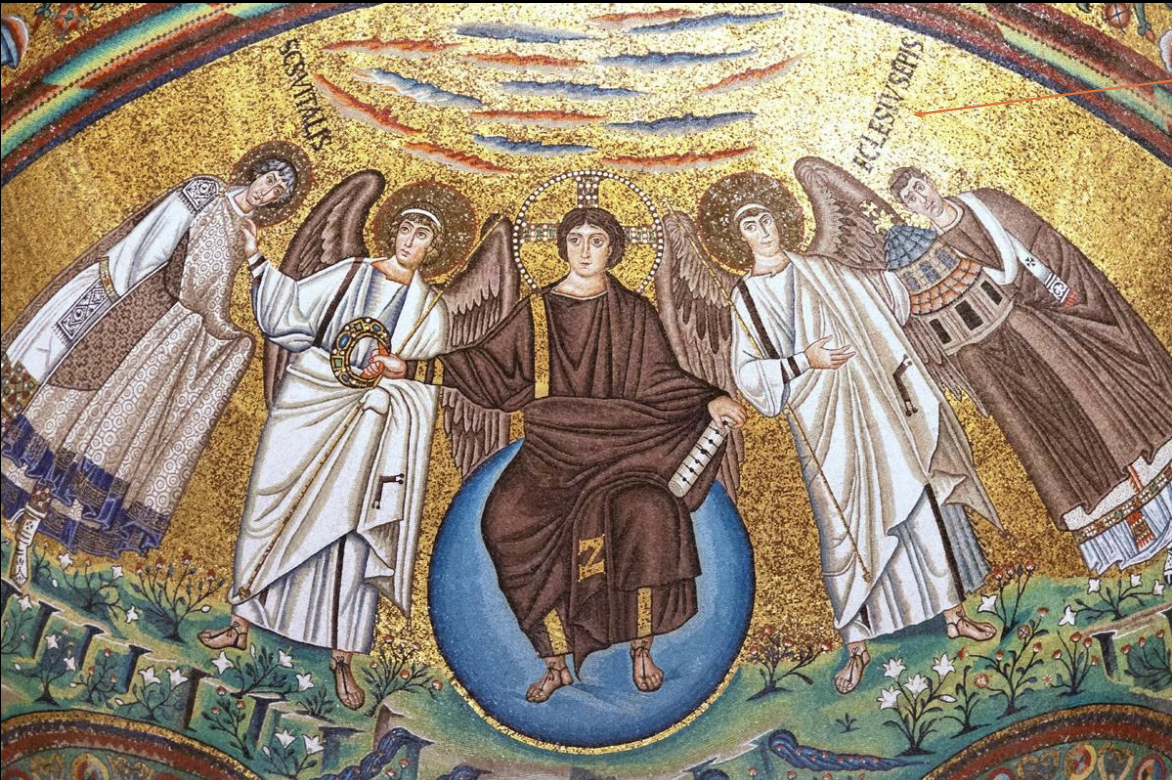
San Vitale, Christ (the true king) on the globe surrounded by archangels mosaic on the apse
Jesus flanked by archangels, on the left is San Vitale and on the right is another Bishop
Bishop wanted to offer great gift to god, emperor and himself, offering symbol of San Vitale to Jesus, in the bishop’s hand is the church
The garden is symbolic, invokes the idea paradise
Bisontine culture uses limited number of colors, no more than 40 shades, even though they had an unlimited amount, because it was the symbolic meaning that was important
Mosaics give different atmosphere full of life, without measurable dimenstions
Gold background:
expensive and full of light material
also they put the ties at the slight angle in order to reflect light, shimmer effect, trick they used in that period
Gold = paradise, eternal light
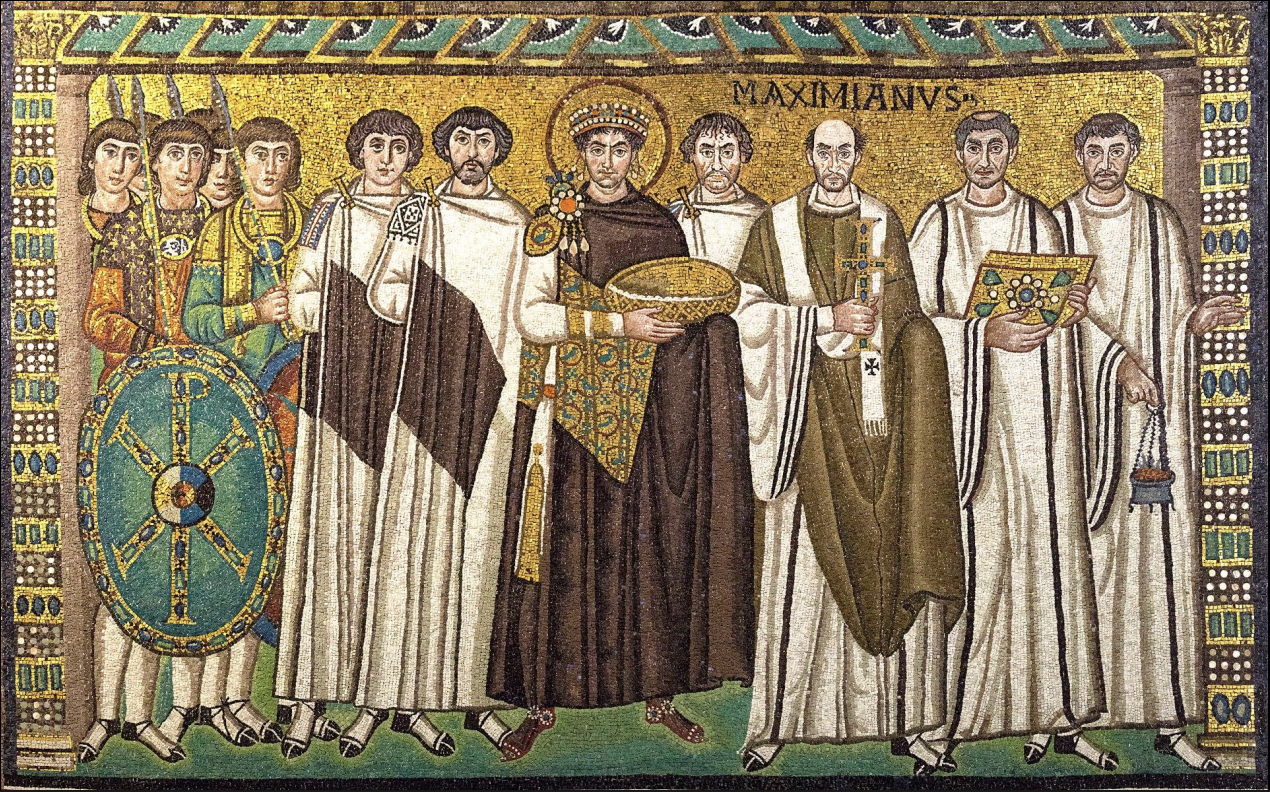
Justinian offers the bread for the Eucharist
San Vitale
Gold background tells us it’s a sacred space
Halo present
Even political figures had halos sometimes, emperor is a sacred figure because they have God’s support
Surrounded by parts of clergy and the army
Maximians, much more important so his name is labelled
Justinian is bringing something having to do with literature
Eucharist is eternal and enduring moment caught in this piece
Mosaics give different atmosphere full of life, without measurable dimenstions
Gold background:
expensive and full of light material
also they put the ties at the slight angle in order to reflect light, shimmer effect, trick they used in that period
Gold = paradise, eternal light

Theodora offers the chalice of wine for the eucharist
She is very dressed up, wearing a robe that has the pattern of the 3 wise men, people coming from the east or asia, looking at stars that guided them to Jesus, they were the first to bring gifts to Jesus
So Theodora is a new wise gift, she is bringing a gift to Jesus through the chalice
All the women and men are portrayed from the front
These mosaics are part of ritual portrait of emperor bringing gifts to god
column shown in the front to show pouring water and perspective
Feet of characters are walking on each other because some are more important and therefore cover the feet of others
More spiritual space where true images of human bodies don’t appear as often
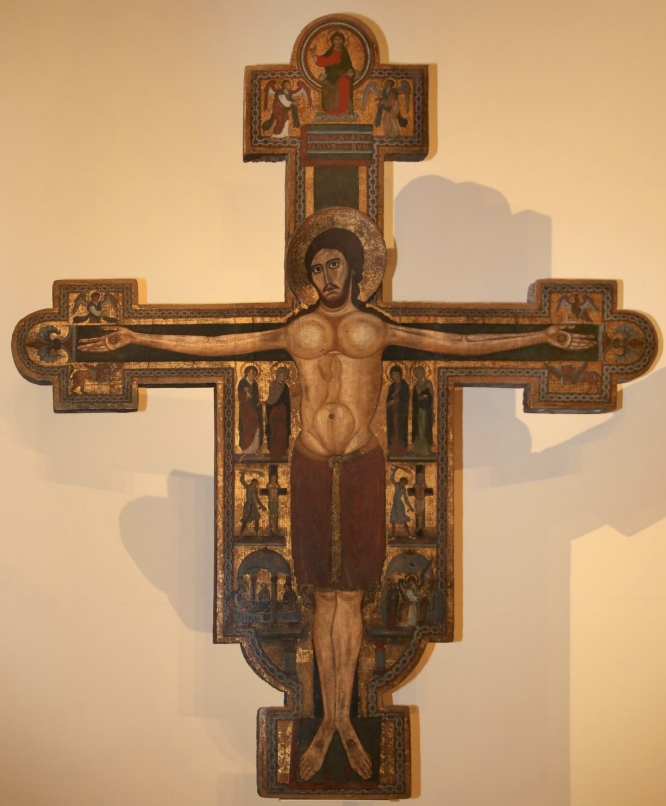
Crucifix, 12th century, tempera on wood, Lucca, Museo di Palazzo Guinigi
Peculiar cross and another strange image of Hesus suffering crucifixion
All come from Byzantine artists or artists raised in Tuscany that know of Byzantine art
Does not show any suffering
From the anatomical pov, must consider what the Byzantine art considered what he looked like
All muscles represented in regular way, all artists must respond in a way that must be respected
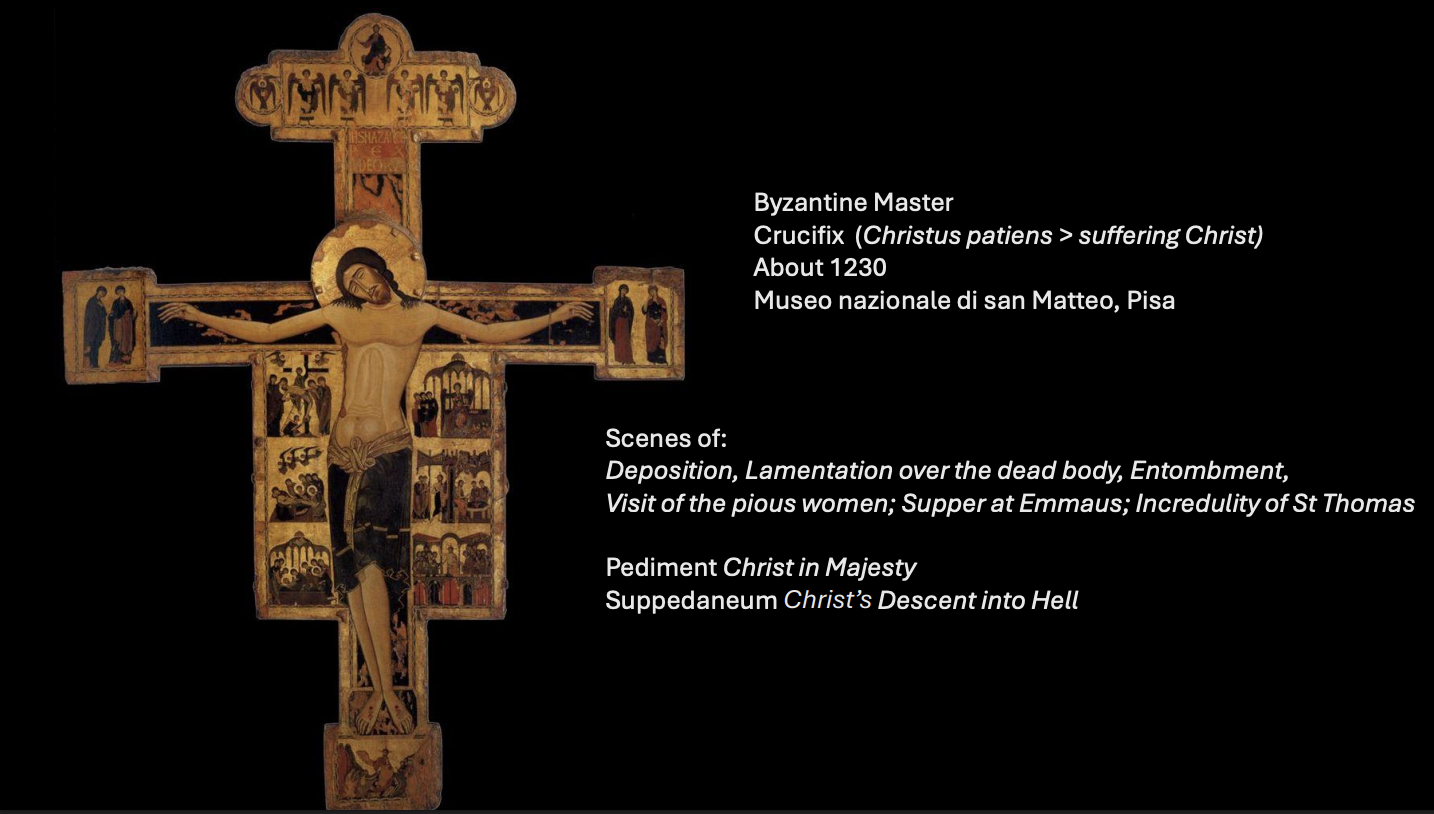
Byzantine master
Crucifix (christus patiens, suffering Christ)
About 1230
Scenes of: deposition, lamentation over the dead body, entombment, visit of the pious women, supper at Emmaus, incredulity of St Thomas
Pediment christ in Majesty
Suppedaneum Christ’s Descent into Hell
Image of someone who is dead and has suffered
Small scenes in the squares gives us certainty that it is a Byzantine artist coming from Constantinople
What was the function of this type of image?
Looking at the different crosses, the structure is the same,
Function: gate that separates faith part and clergy stays
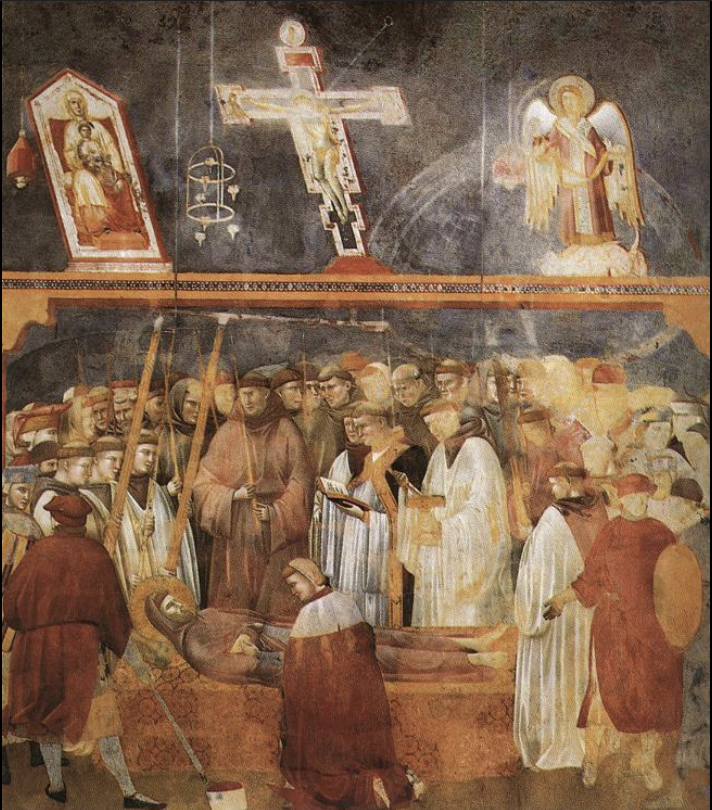
Giotto 1267-1337
Verification of the Stigmata
This particular fresco is a detailed representation of a pivotal moment in Saint Francis' life, where he receives the stigmata, symbolizing his deep devotion and connection with Christ.
The scene is filled with figures gathered around the saint, their faces expressing a mix of awe and reverence.
From the legend of St Francis
Fresco, 1290-1295
Assisi, Basilica Superiore
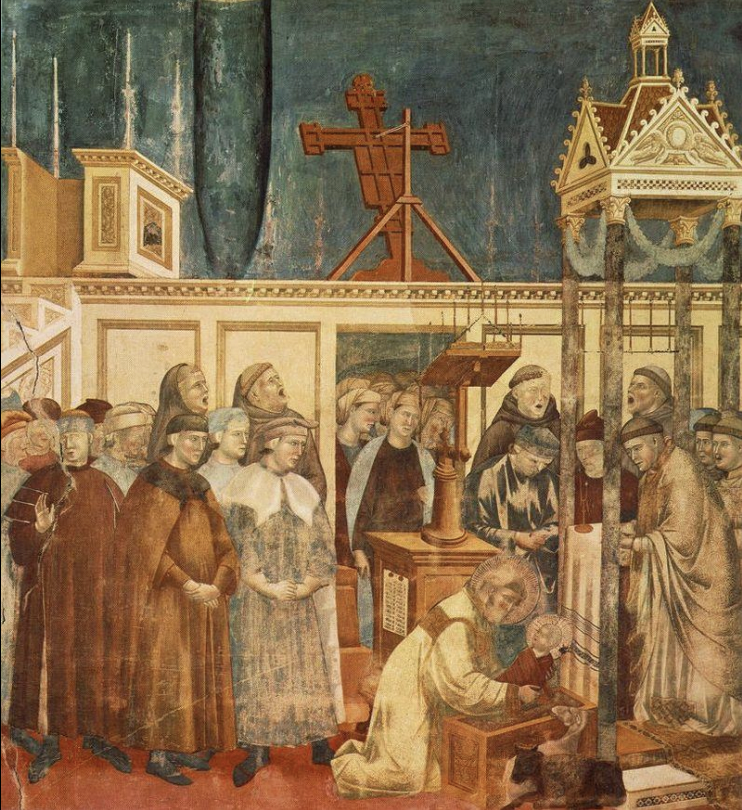
Giotto
The Nativity Scene at Greccio
From the Legend of St Francis
Fresco 1290-1295
Assisi, Basilica Superiore
First nativity scene that St Francis set up
Cross is from behind

Guinta Pisano
Crucifix
Is asked to paint a suffering Jesus, he paints it differently
Figure is more strongly arched, and has a more muscular body
Jesus face seems suffering a little more, Guinta changed this too
Guinta carved wood to stress line of the eyes to add impression of suffering and mouth is more downturned and bitter
The artist did not simply decide but had a commission, so we must consider who accepted Guinta’s change
The choice to be more devoted to suffering cries than triumphant cries, was more successful
Very much to do with race of two religious orders that were the Franciscans and Dominicans
Why is it important? Founded by two people who were St Francis (canonized 2 years after death) and St Dominic (canonized 13 years after death)
Important because they changed perspective of people in front of the church
Canonized immediately, usually takes decades
Development is singular and crucial
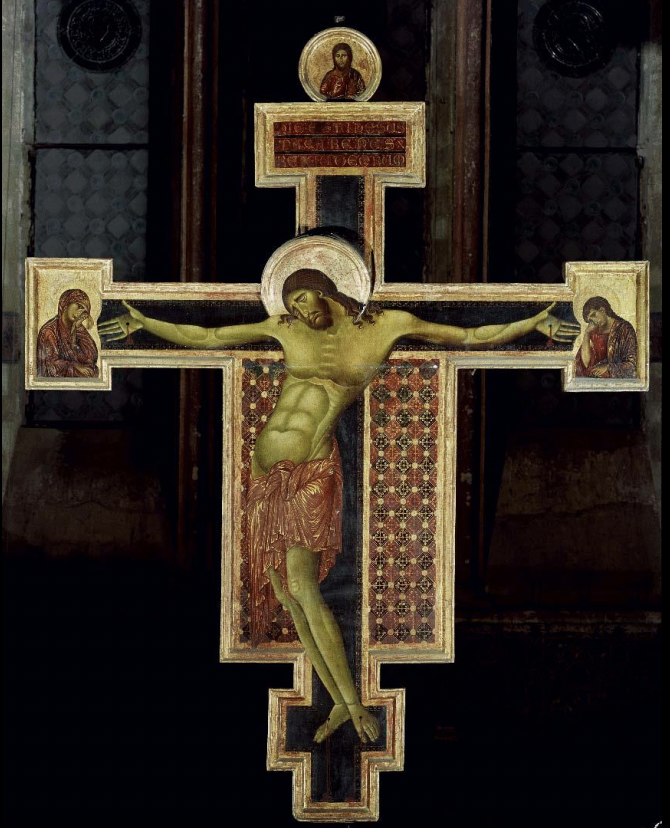
Cimabue
Crucifix
Tempura and gold on wood
1275-1285
Firenze, Santa Croce (before 1966 flood)
Can see the present state post flood as well
Dominco and francesco created new way to devote to religion
Mandicon saints and they found the mandicon orders
Poverty was the key for conquering people
Fryers were close to people because they were poor
That's why image of Jesus was created for Dominicans and Franciscans
Different loincloths
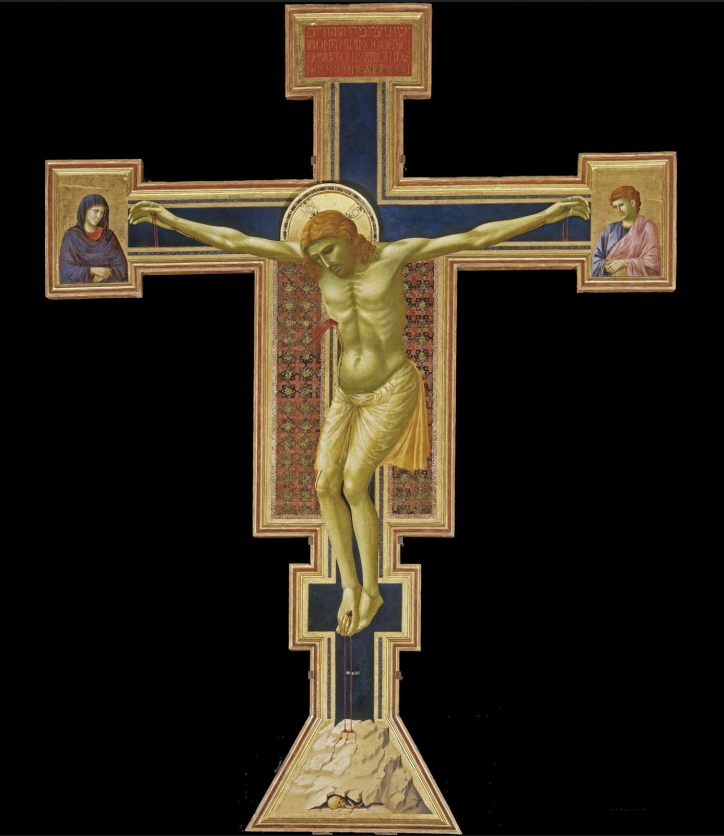
Giotto 1267-1337
Crucifix
1295 ca
Tempera and gold on wood
Firenze, Santa Maria Novella
Body has no arch or idealization
Considering what we saw before, much more realistic
True suffering face, convincing anatomy
Image of blood that follows his arm and dropping on the cross
The body being very pale
Preparatory drawing, revealed through infrared analysis
Giotto translated the art of painting from Greek into Latin and Brought it into the modern style and he had the most complete command of the art that anyone ever had

Latin Cross Plan
It has one longer arm (the nave), forming an asymmetrical cross, similar to the traditional Christian cross
Santiago de Compostela Cathedral
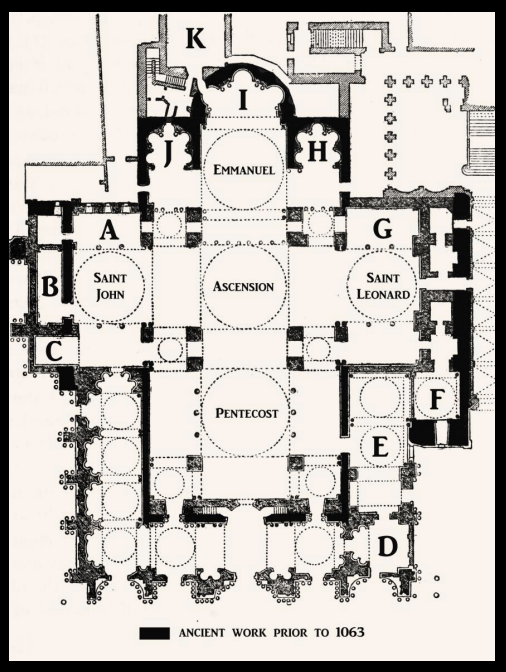
Greek Cross Plan
It has four arms of equal length, forming a symmetrical cross
Venice, St. Mark’s basilica
Certain sense like a central plan, people supposed to sit and listen to mass, participate in mass both in front of the main alter or also less or right but this is uncomfortable because it is hard to see
In the end the central plan or greek cross plan lost in a way
Giotto Greek —> Latin style
“Giotto translated the art of painting from Greek into Latin and brought it into the modern style, and he had the most complete command of the art that anyone ever had.“
Greek meant Byzantine
He is saying that he left the Byzantine tradition and translated it into Latin
Latin is classic tradition, what Giotto would’ve seen in ancient Roman art
Vernacular language, moment in which people still understood ancient Latin, but all over Europe, vernacular languages were developing and were starting to overtake Latin
Giotto was painting in a new way
In this area of Europe, innovation becomes a positive element, in contrast in Byzantine time artists had to follow tradition
And now an artist is being praised for being new
In a certain sense, someone who repeats too much will lose a positive connotation
One of the first times Giotto is known and famous and unique, first time in which visual art is praised, having to do with inspiration and culture
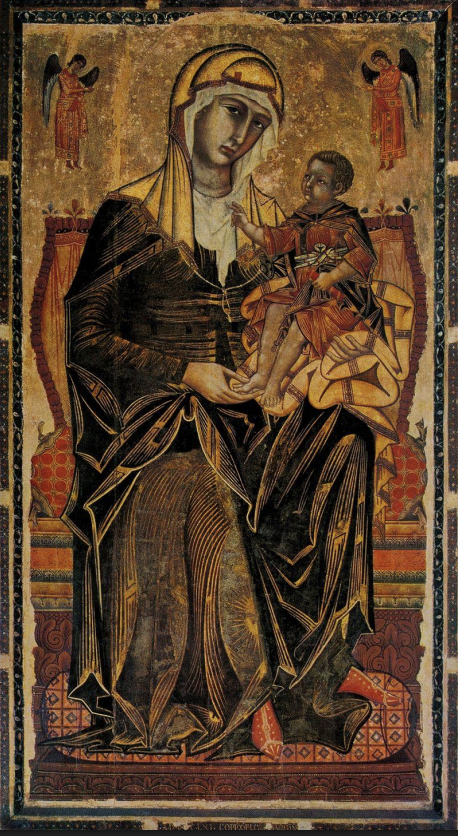
Coppo di Marcovaldo
Madonna del Bordone
Tempera and gold on wood, 1261
Siena, chiesa di santa Maria dei Servi
Mary with her child
Marcovaldo was following Byzantine formulas, that is to say recognizable pose
The hair garment is created through gold highlight
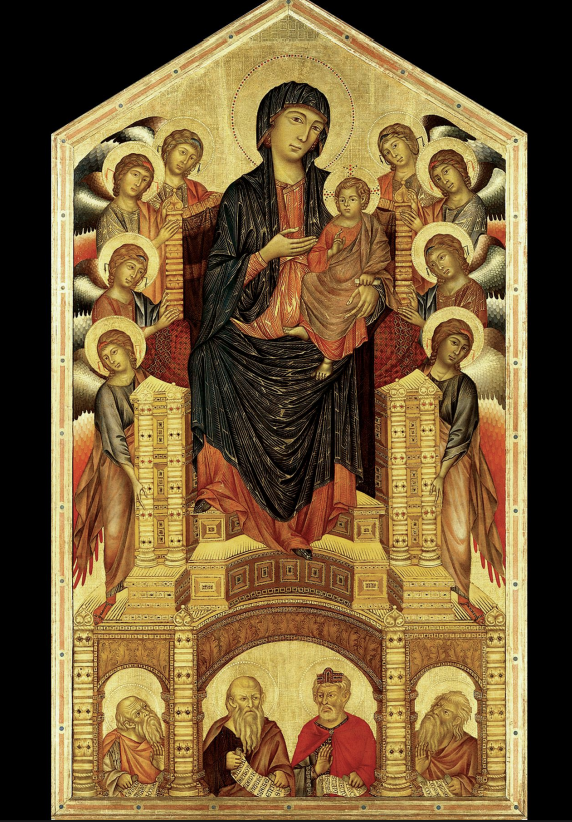
Cimabue
The Madonna in Majesty
Tempura on wood, gold background
Galleria degli Uffizi, Florence
Image of Mary is mary, she is just pointing to her child telling the viewer that he is the road to eternal life, etc
Typical Byzantine formula
She is highlighted by gold, typical of the time
The angels surrounding her are painted in non traditional colors
Below the prophets are holding scrolls which reference the mysteries of the incarnation and mary’s virginity
Gold = byzantine
But, elements of drapery and expressions of the figures hint at the emerging Renaissance style
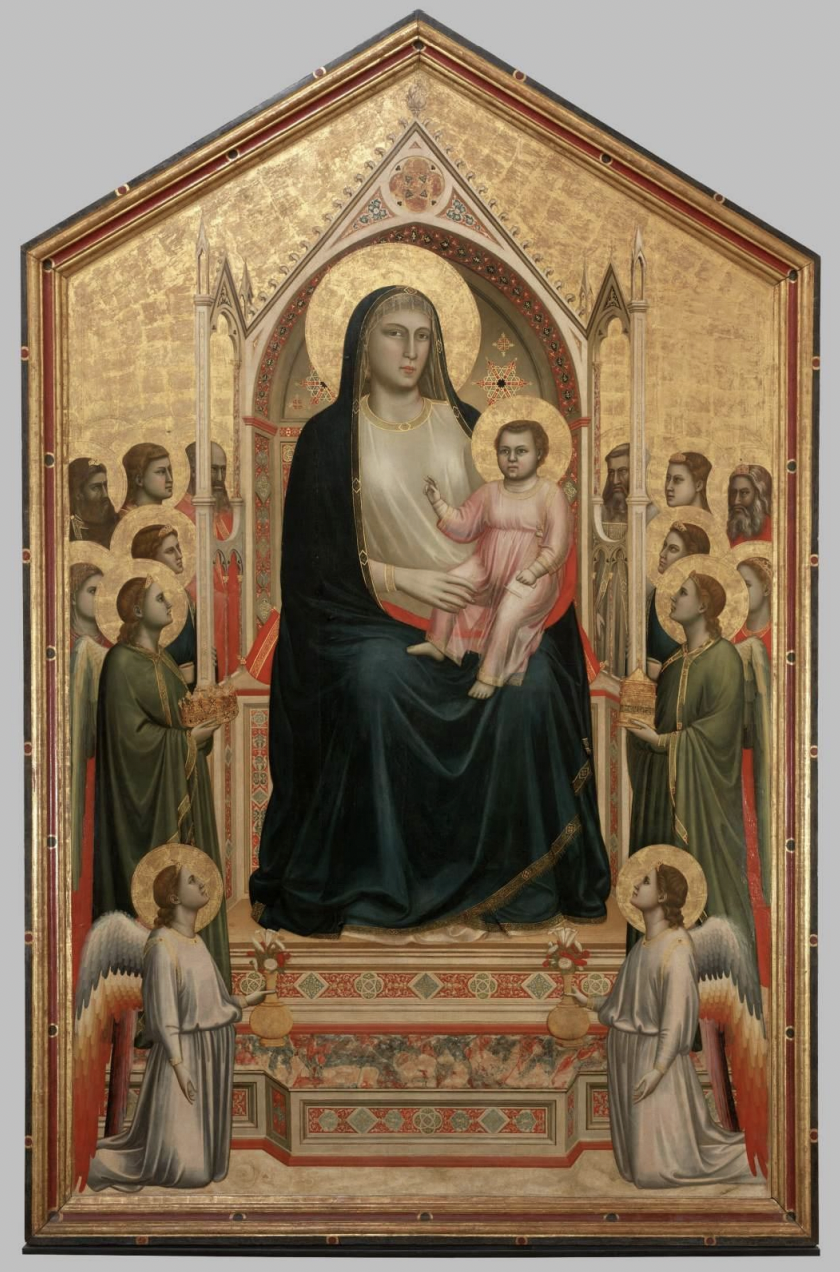
Giotto
Ognissanti madonna
1300-05
Tempura on woods, gold background
Galleria degli Uffizi, Florence
Gives impression that virgin Mary can be contained and sit in realistic way in the throne
Standing and sitting angels instead of them flying
Giotto gives impression of a true space in which we could actually walk
Not highlighting with gold (Byzantine), but creating light in a new style, seems like Mary has volume and is really breathing
Giotto was not criticized for this innovation, he was followed, every painter in Italy and beyond followed his model
“In painting, Cimabue thought he held the field, and now its Giotto they acclaim - the former only keeps a shadowed fame” – Dante
Basilica and convent of Saint Francis Assisi (1228-1280)
Church built in short time because Pope was financing and liked Assisi
The architect got inspiration from gothic architecture and mixed it with Romanesch,
Plan of the church is a latin cross
Most people couldn't read back then so art was helpful to teach them what religion said
The lives of saints, stories, etc, would be depicted on the church’s walls so everyone could follow along
“It is the bible for the poor”
The Canticle of the Creature
Poem written by Francesco di Assisi in which he praises God for having created fire, water, sun and how beautiful the world is.
The first time someone writes their appreciation for nature
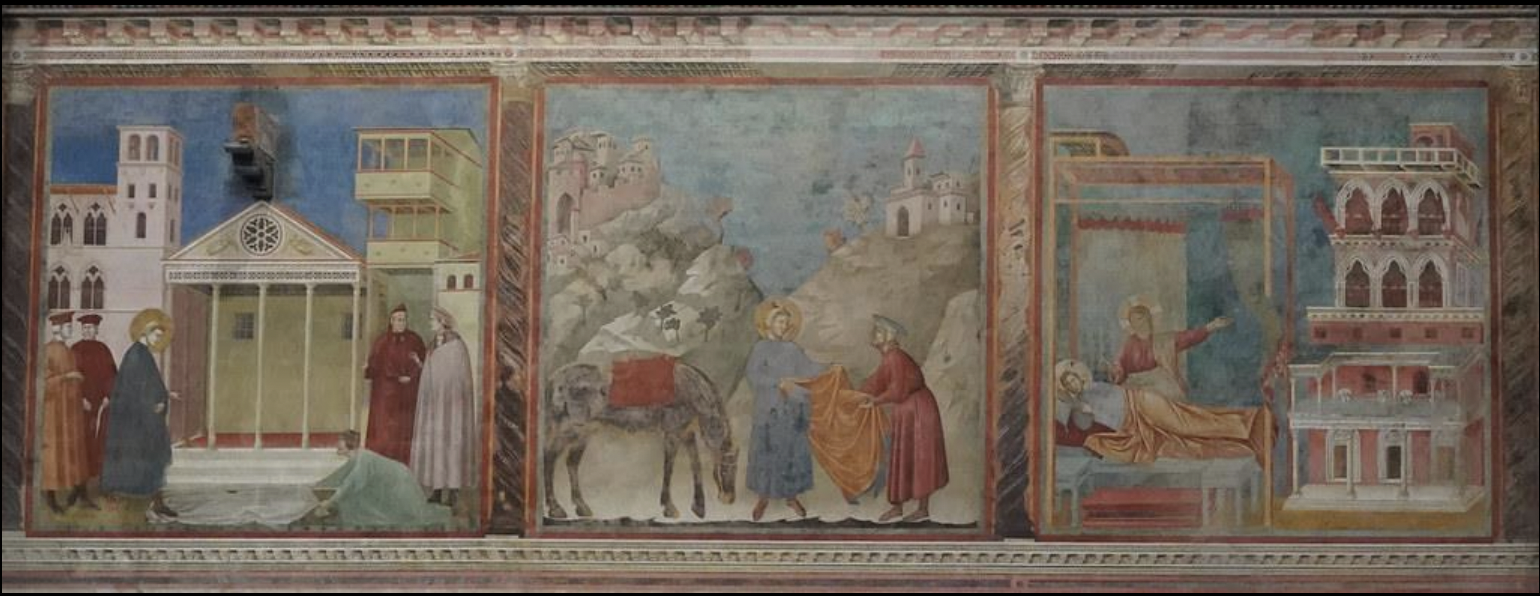
Three scenes from the Legend of Saint Francis by Giotto and his workshop
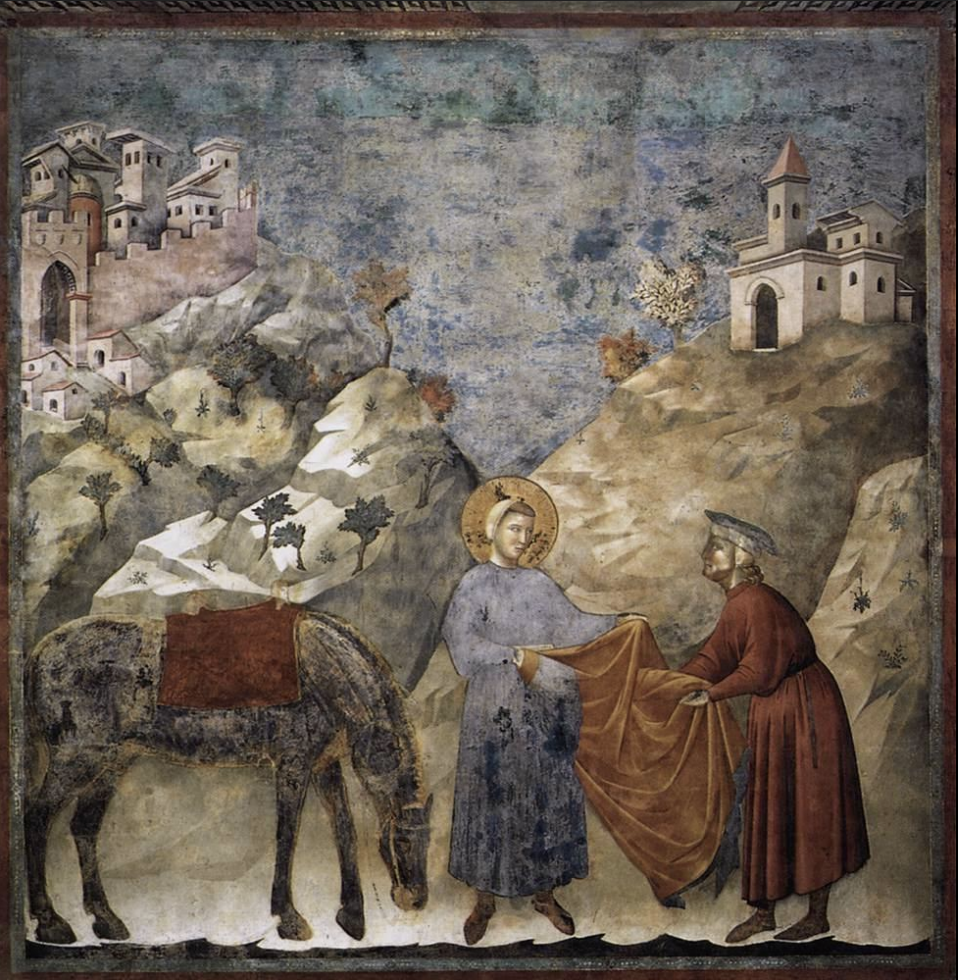
Giotto
Painted in a correct perspective to give us the impression that it is clear and immediately can be understood in a glance
The blue on the art was put on last and used to be bright but fell off
Show figures that are full of volume, bodies are real and can imagine that they can come outwards towards us
St Francis belonged to wealthy family, renounced his wealth and giving it as gifts to others
Giotto creates relationships between figures and the ambience and landscape
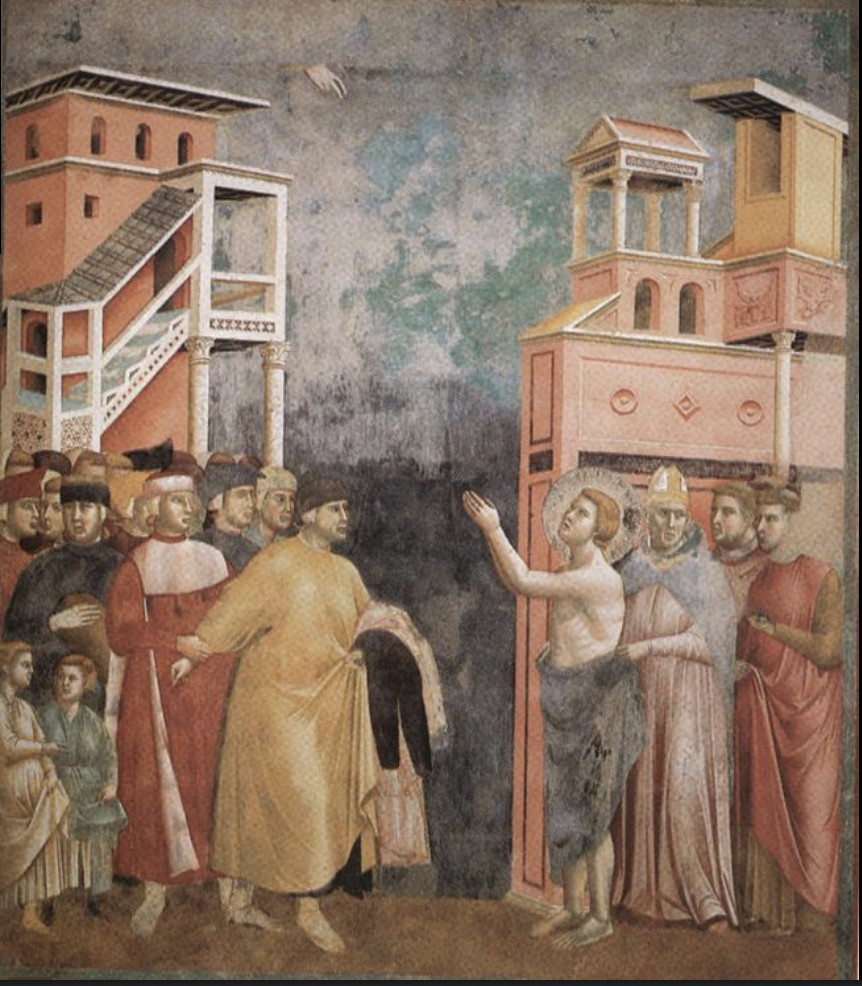
Renunciation of Worldly Goods
Giotto
Father did not accept choice, in provocative way, went into center of Assisi and stripped and bishop is covering him up with cloth
Father has taken his clothes after Assisi threw him down
Man holding the father back physically
Viewers of this would be being convinced and led to the religion
Giotto creates very strange buildings in the back, they make no sense from our point of view
The buildings work as frames for the people below
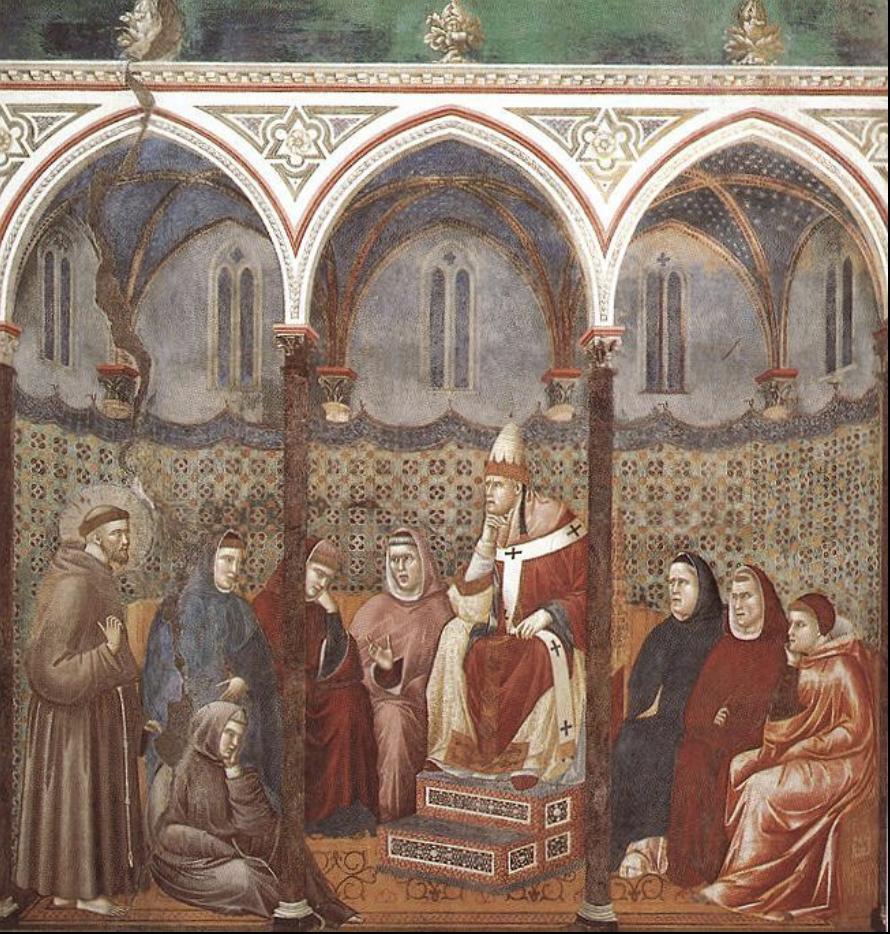
St Francis Preaching before Honorius III
Giotto
Human space, people sitting, dramatic reaction of St Francis preaching while the Pope is very interested in listening to hum
Pope’s face is the most interesting element because he is the most important in that time and he is very concentrated on what Francis is saying
Giotto created new technique, adding layers, for human skin he adds one greenish base, then adds red, then stresses all the elements of nose, mouth and around the eyes
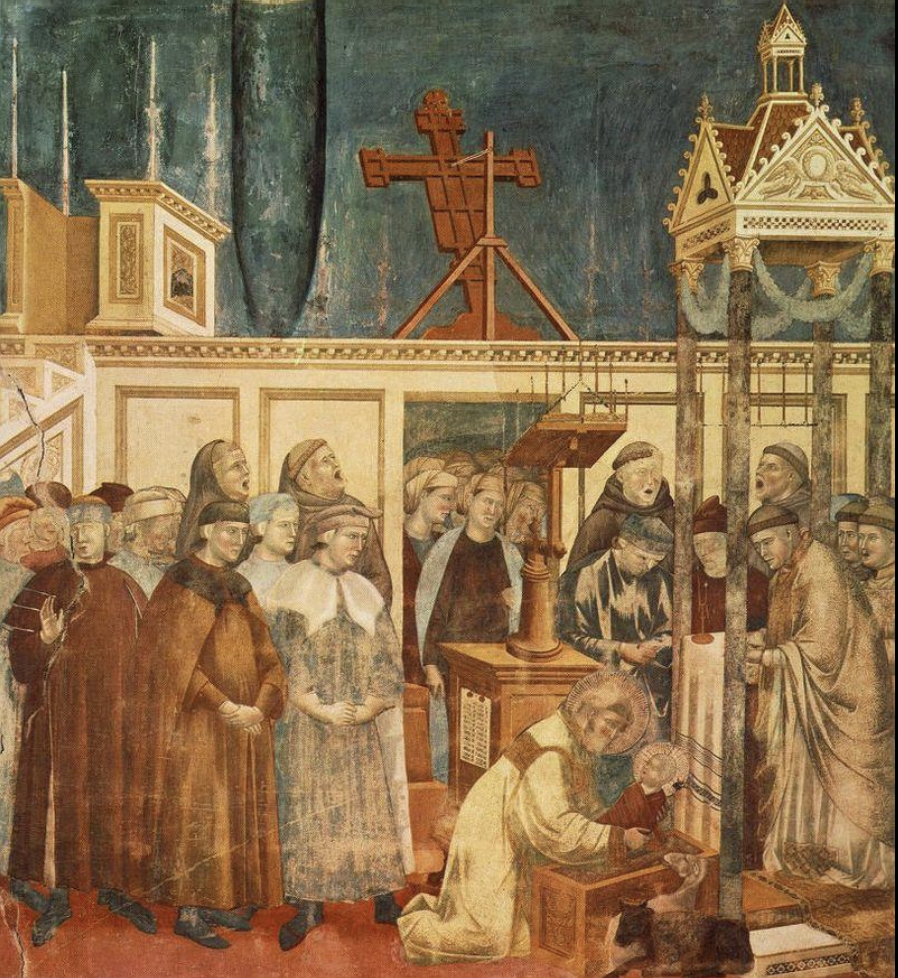
The Nativity Scene at Freccio
Giotto
Every figure is portrayed in his own way
St Francis of Assisi is preparing a Christmas crib
He and the baby have a halo on them
Friars are singing, women are looking at what's happening, boy in bed recreating scene
Cross being seen from behind
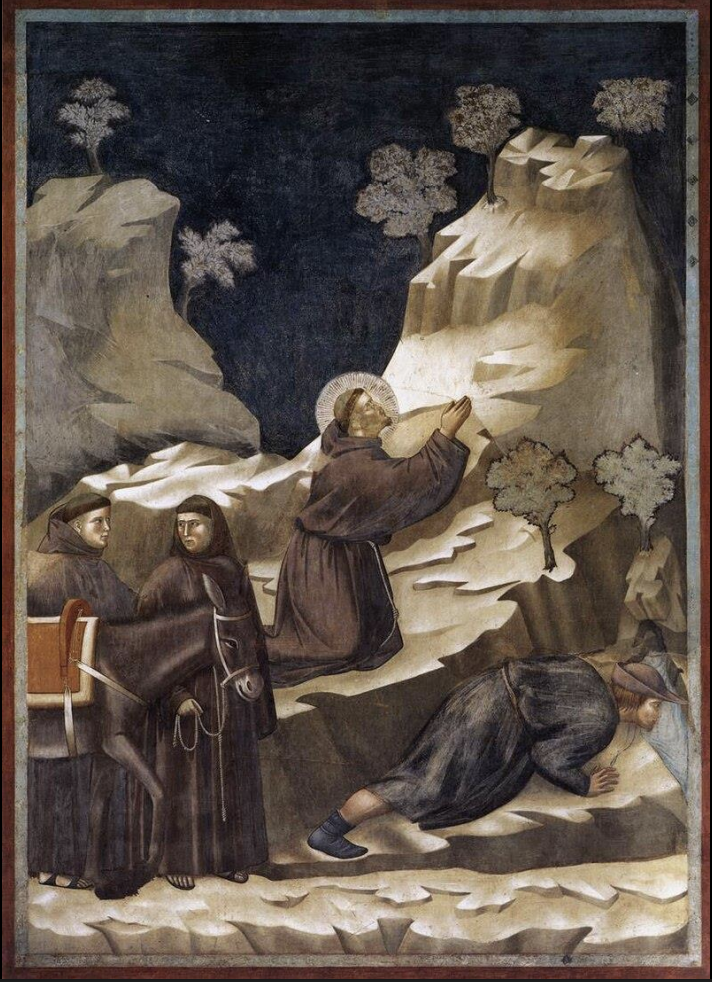
The miracle of the Spring
Giotto
Depicts one of the miraculous deeds of St Francis
One figure, the farmer is drinking from the newly sprung water source which is a manifestation of St Francis’ divine intervention
Two monks accompany them
Upwards direction
Interesting landscape, rocky
Stylized trees, proportions off
Human emotion
Symbolic landscape
Dark colors
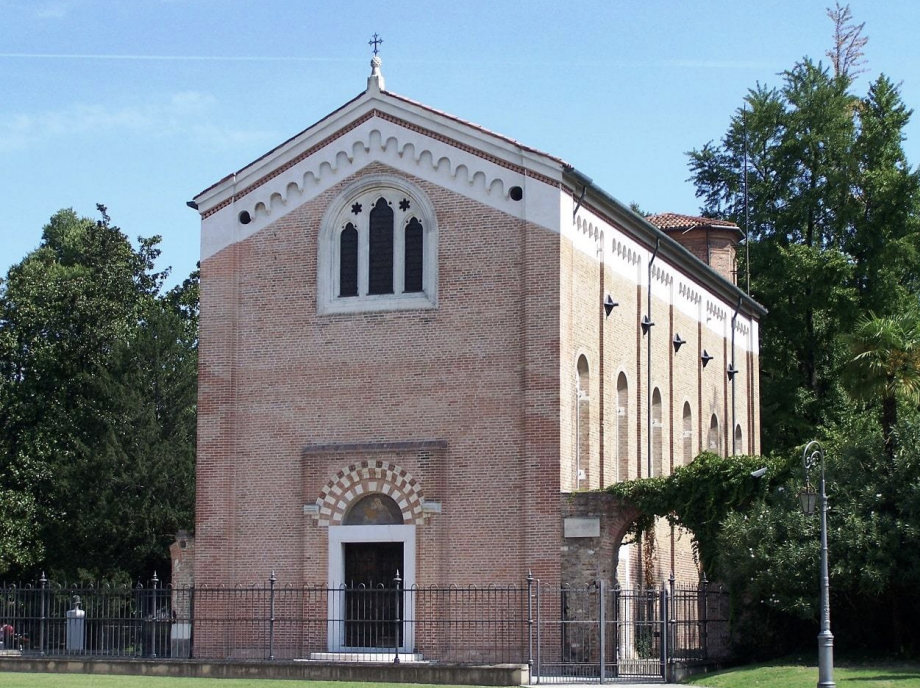
Cappella degli Scrovegni or Chapel of Arena
Ancient theatre in Padua
Giotto worked here
Cappella degli Scrovegni, 1303-05
Stories of Jaochim and Anne (the parents of the Virgin Mary)
The life of Mary and Christ
Last Judgement on the counter-facade
Representations of the vices and virtues
Scrovegni wanted to save his soul, many if they weren't good during life would try to make up for it before dying…
Giotto painted almost everything in the church
Giotto painted values as personifications, painted them as statues, values such as faith
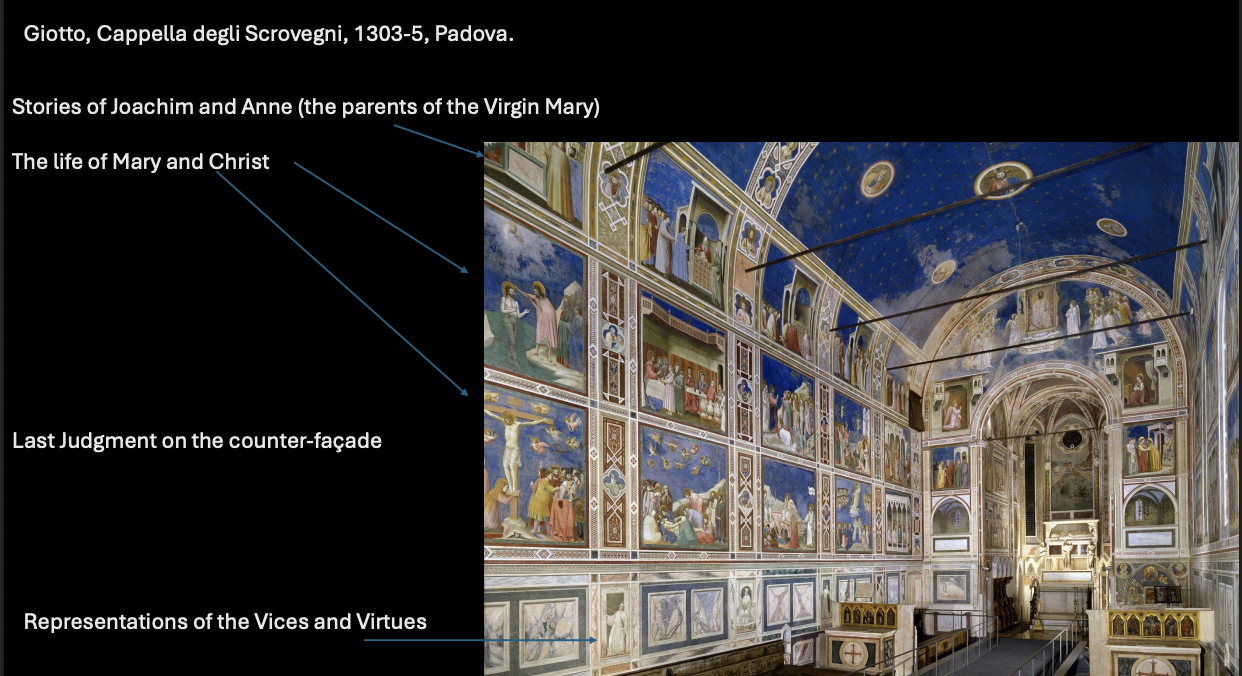

Annunciation of Saint Anne
Giotto
Is it possible to visualize what happened in religious history? Yes we can use arts to show sacred stories
Giotto shows a story of Saint Anne (virgin mary’s mother)
Anne is told by angel she will soon give birth by miraculous conception
She is very old and has no son or daughter, she is given the virgin mary by an angel
Young servant girl outside the room
Shades and volume are given for the figures
Wall near us is removed so viewer is let into the scene
The flight into Egypt
Every face expression, Mary is full of dignity and looks like queen in exile
Scene is accompanied by rocky backdrop that stressed Mary’s figure
She is holding her child in a very familiar way, good mother and child relationship
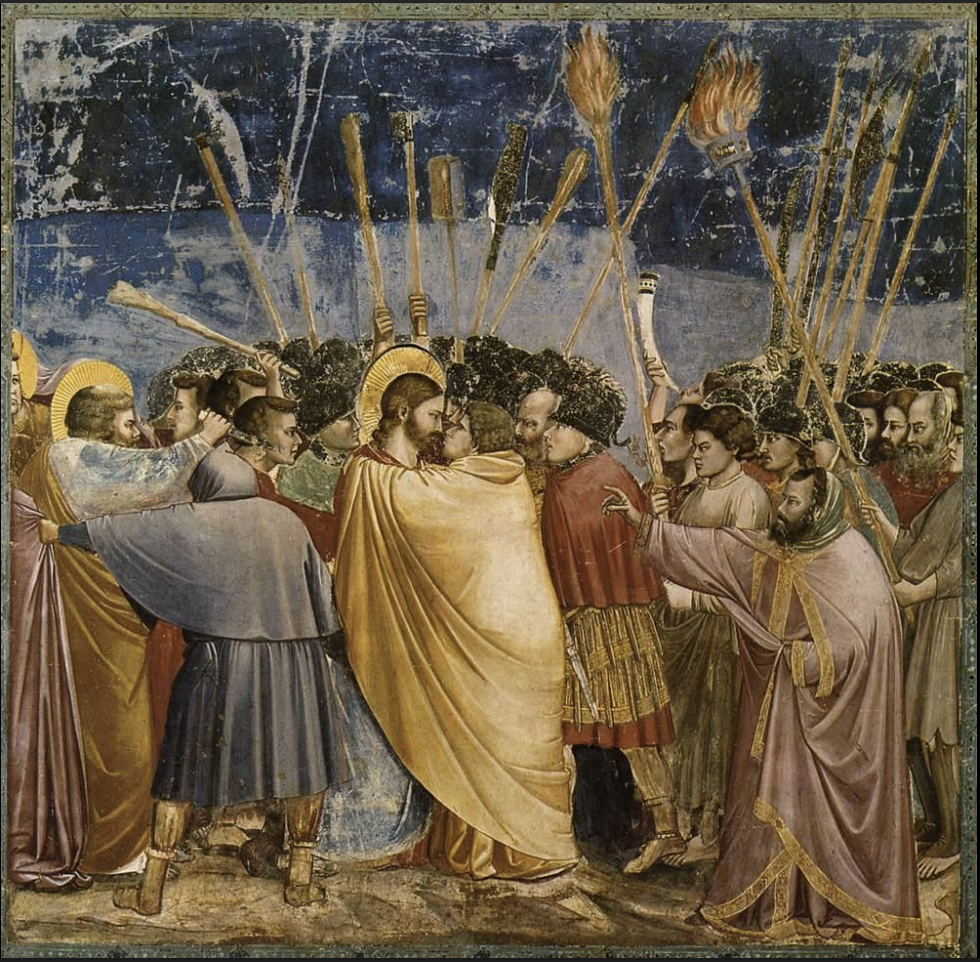
The Kiss of Judas
Giotto
Depicts the moment of betrayal when Judas identifies Jesus to the authorities
Showcases Giottos style and emotional depth
Protaganists of scene, we can see them acting
Judas face tells us he knows what he is doing and has satisfaction turning in a friend
Every figure doing something meaningful in this scene
Nowhere to escape
Judas kissing Jesus

The Lamentation over the dead christ
Jesus on his mothers lap after he has been taken off the cross
Every person is concentrated on mourning but in their own way
John has his arms outstretched, incapable of understanding what happened and greiving
Something like a revolution, showing people from behind
A scene we are able to enter so we can see what is happening
Everyone is so close and concentrated on Jesus
The people turned around are helping us enter the scene
One of Giotto’s most interesting works
The colors are really interesting because every figure has their own personality thanks to different colors, also helps volumes come to life
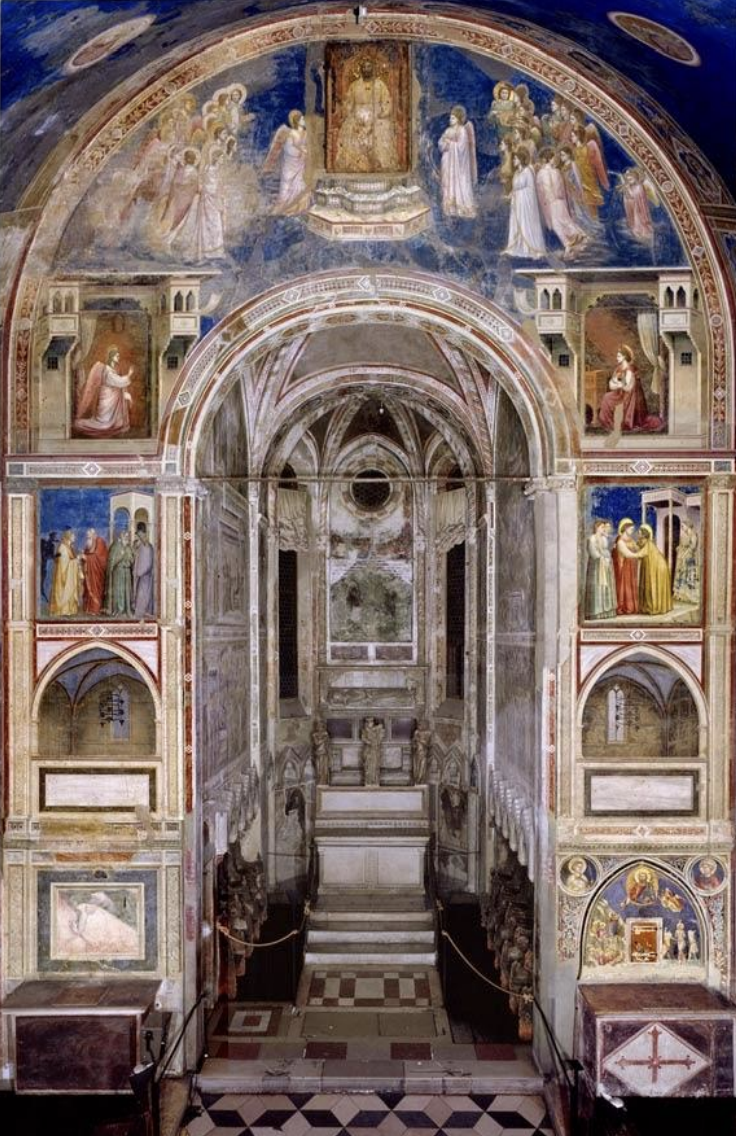
Triumphal arch of the church
Limited number inside provides a more personal expereince
Recycled in noble sense from Christian culture
For Roman people, triumphal arch is where generals after winning battles could pass through and be celebrated by the people
Christian culture has reshaped the image of arch by putting it in the main part of church by celebrating triumph of Christ
The Republic of Florence in the Early Renaissance
Giotto fame speads across Italy
Renaissance was born 1401 because its the moment in which there was competition where we see new things emerging artistically
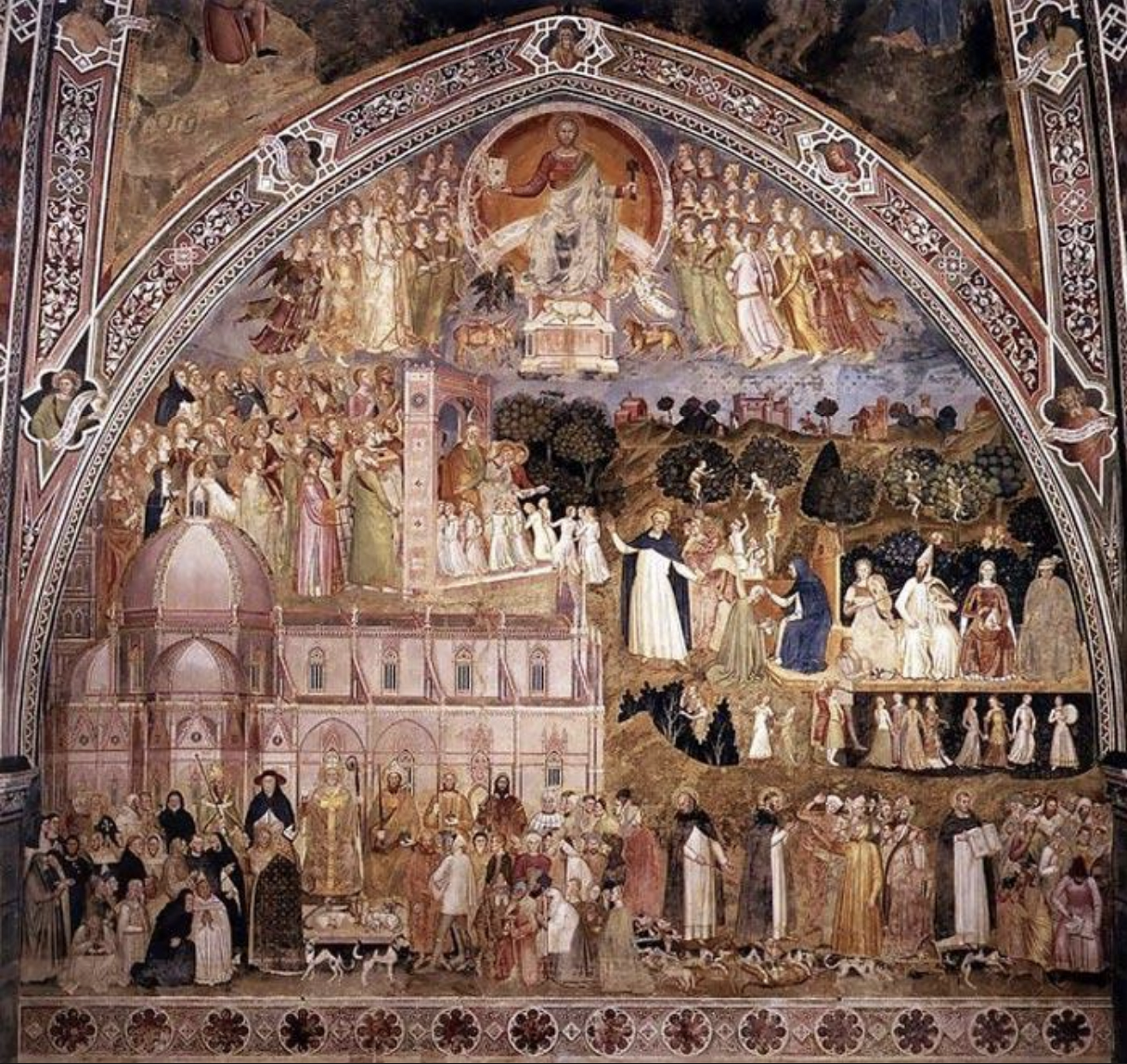
Andrea di Bonaituo
Firenze Santa Maria Novella
Philosophical arrangement of painting, not modern
Not realistic
Very colorful and shows aspects of nature
Interesting aspect
Detail of the representation of the cathedral of Santa Maria del Fiore
This detail didn’t exist when he created it
Florence when building the church, had projected such a monumental cathedral, that they had created a problem for themselves: didn’t know how to finish the church
Florence was an ambitious city, ruling class was driven
Church and city ready to do great things
Imagine NYC, culturally and economically important, many artistic things happening
Florence had everything happening there and families who had incredible fortunes
Going against aristocracy, eventually became ruling class
In 1348 was so called black death, plague, potentially half pop Florence died
In painting, Florence restarting after tragedy
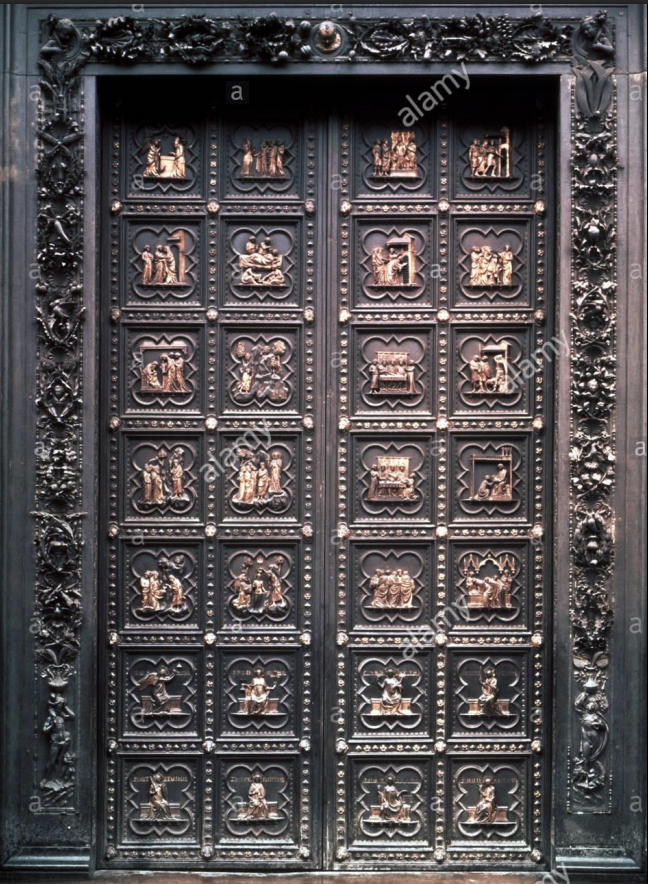
Baptistery of San Giovanni Battista
Andrea Pisano, South Door
1401 competition for the Baptistery door, commissioned by the Arte di Calimala
Other 5 have been lost, remaining have been preserved
Art called The Sacrifice of Isaac was made by Lorenzo Ghiberti and Filippo Brunelleschi
Wealthiest people would finance baptistry
Lorenzo won the competition
Probably joined winners but one dropped out because impossible to work together
Shape of the frame is unique
Created an image, diagonal line from left to right, also following the shape of figure of the main character which is the story
had to create story from old testament
Abraham forced by God to prove his incredible faitha nd God asks him to sacrifice his only son Isaac, even though he didn’t understand losing his son he still sacraficed him but decides to be sacrificed in Isaacs place
Space is complicated but also sense of harmony and also action is being created, Abraham is elegent
Can see how figure is classic torso, impression that artist studied attentively a marble that he based it off of
Drapery was also typical of Gothic culture
Figures are perffectly decorated but Isaacs body is very simplified
Looking also at person working in foreground, we can see how this is less decorative, interested in what they can say to viewer
Scene is very dramatic
Ghiberti and Brunelleschi
How these two personalities Ghiberti and Brunelleschi and rivalry was very celebrated, entire Florence was interested in what they were doing, arts started to have important role, unexpected in middle ages, since Giotto Florence developed taste in arts, that's why Renaissance was born there
In 1402, Brunelleschi goes to rome
Well educated, trained as goldsmith before he became artist
Goldsmith were well respected, worked on specific materials, etc
Good training for doing art later on
Art called The Sacrifice of Isaac was made by Lorenzo Ghiberti and Filippo Brunelleschi
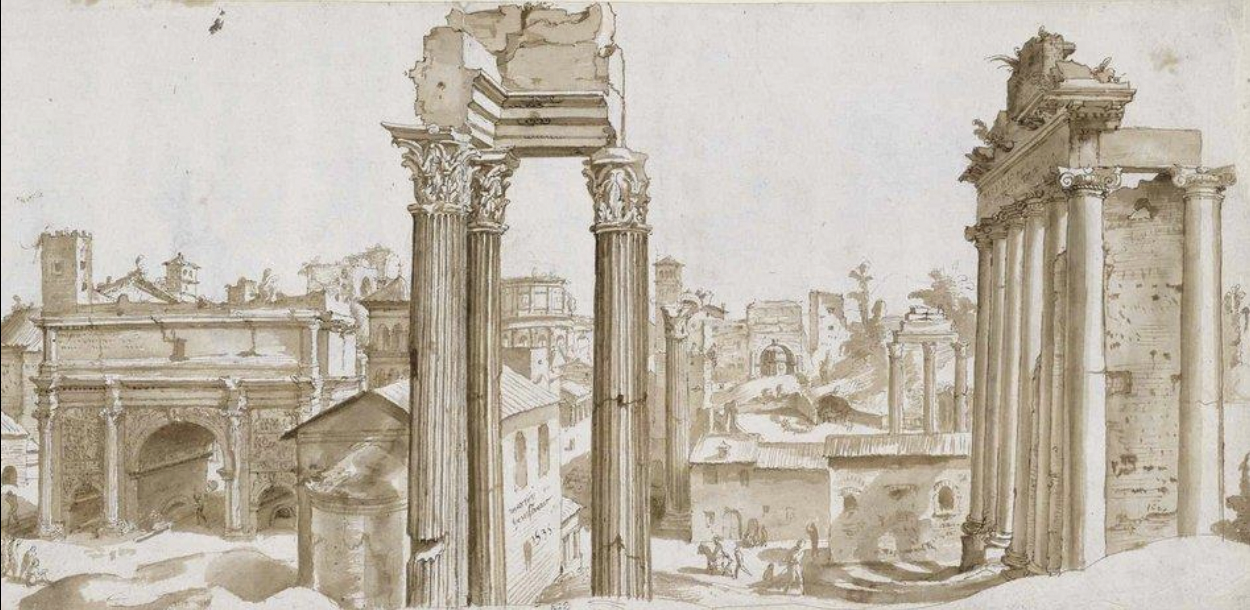
Maarten van Heemskerck
View of the Roman forum, detail of a drawing
pen and ink on paper 1532-36
Studying ancient ruins, one of the first to do this
Interesting because in following centuries many artists who will go to Rome and study
Maarten is Dutch artist
Reporter of what Rome was, left many drawings that show image of Rome in his times, interesting because he had same ambition one century later
Points in city where there were many ruins
Second drawing by same guy
View of the Palatine Hill with the remains of the imperial palaces
They were moving towards things that weren’t gothic but new style
Roma puanta fuit ipsa ruina docet — how great Rome once was, the reuins themselves show
Artists feel like they must go to Rome in this time
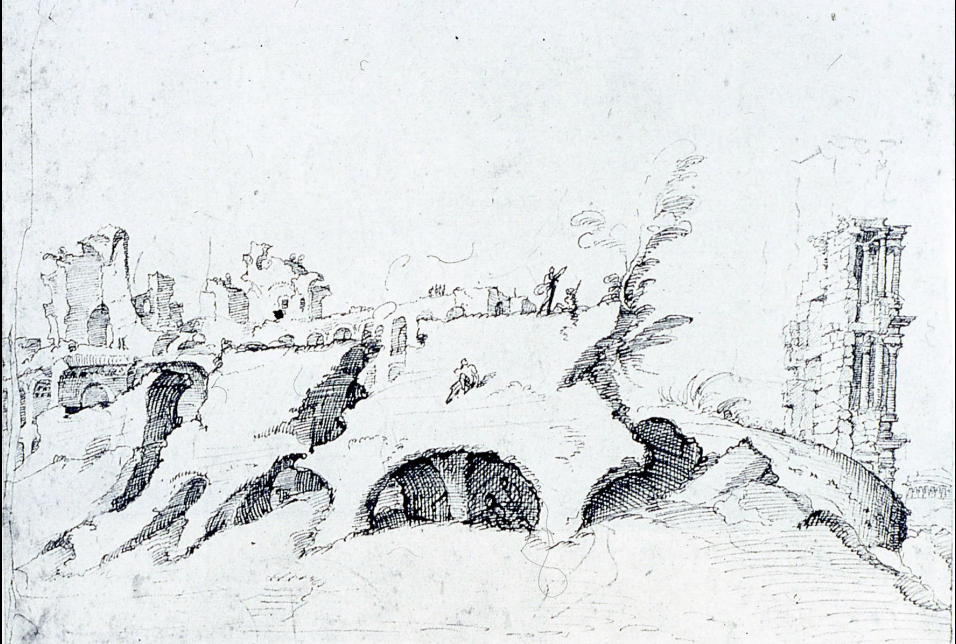
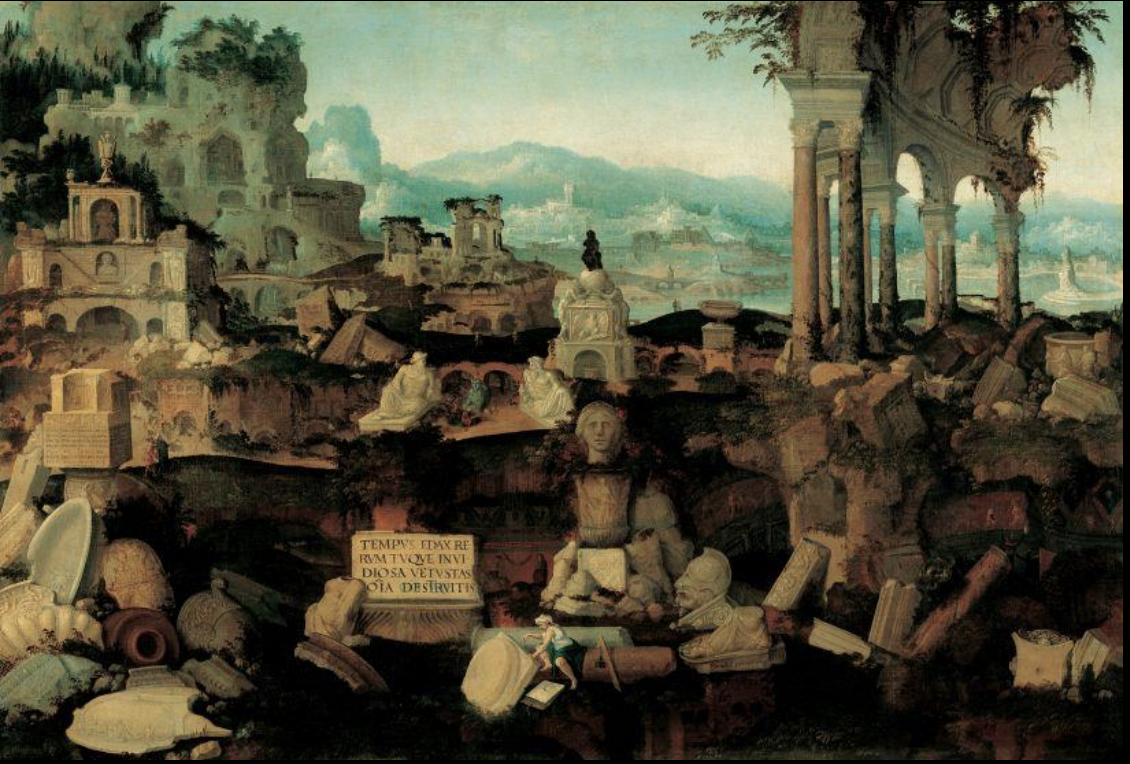
Herman Posthumus
View of Roman Ruins
Oil on canvas
In the middle literary quotation (time destroyer of all things)
So feeling of all artists is a romantic feeling, grandeur of past and immensity of architecture gives feeling of mediocrity of present
Nostalgia for past
Measuring column, drawing, in the art piece
Second part of being in Rome, studying passionately but also rigorously
scholarly knowledge, perfect survvey of what the class left, this is the artistic attitude.

Donatello
very young when he started to work as a sculptor and received commissions in autonomous way
David 1408-1409
Sculpture put in important palace because it was supposed to be in an important place, in buttresses, in front of city, nothing else but sky behind it
After finished, ended up being too small for buttress, was put in one of the first rooms of the seat of the government
Symbol of republic of Florence, since David is biblical hero who defeats enemy
Republic of Florence liked to see themselves as biblical hero
Slightly gothic sculpture
Twist of torso, elegance of head
Idealized image of a boy and idealization of hands
Same elegance in the drapery
Donatello is very young, even though he just got to Rome and started studying, still working on traditional drapery
In the narrative, the Israelites are fighting the Philistines, whose champion – Goliath – repeatedly offers to meet the Israelites' best warrior in single combat to decide the whole battle. None of the trained Israelite soldiers are brave enough to fight the giant Goliath, yet David, a shepherd boy who is too young to be a soldier, accepts the challenge. Saul, the king of Israel, offers David armour and weapons, but the boy is untrained and refuses them. Instead, he goes out with his sling and confronts Goliath before hitting the giant in the head with a stone and knocking him down. He then grabs Goliath's sword and cuts off his head, causing the Philistines to withdraw as agreed, and saving the Israelites. David's special strength comes from God, and the story illustrates the triumph of good over evil. According to Olszewski, David's triumph over Goliath has been interpreted as a "parallel of Christ's triumph" over the devil
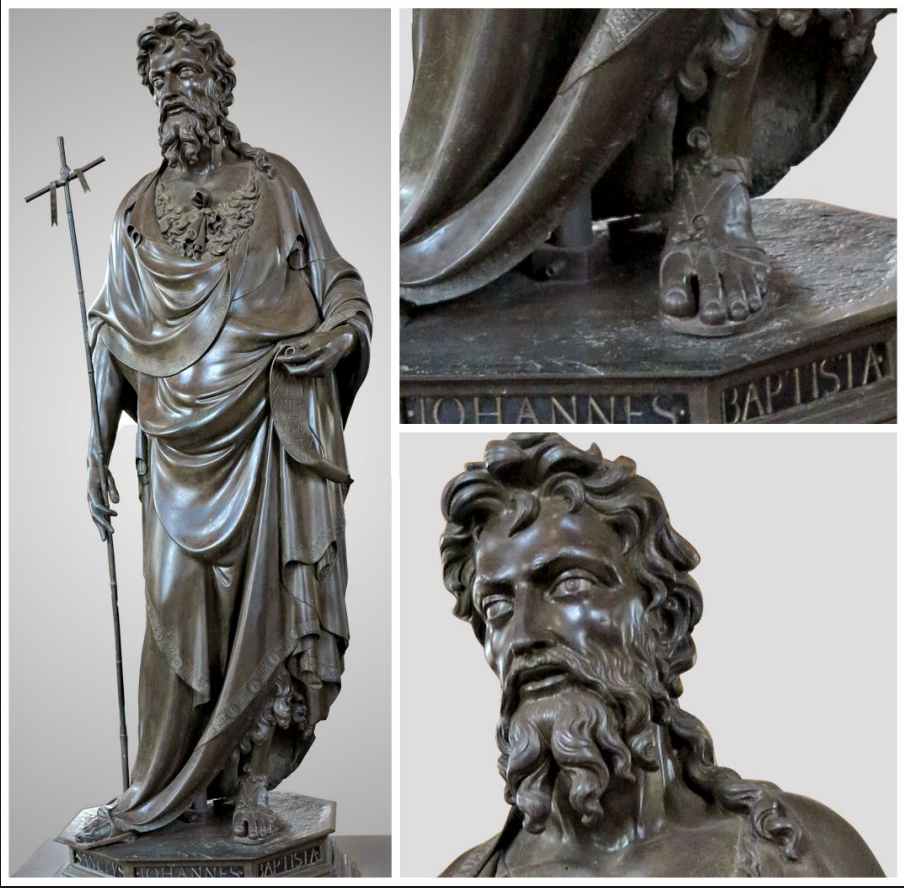
San Giovanni Battista or John the Baptist
Lorenzo Ghiberti
Bronze 1412-16
Ghiberti still immersed in gothic culture
Drapery is curated, less realistic
Bronze importance
difficult technique, something that one must work on very carefully
bronze 10x more expensive than marble
ghiberti working on bronze was precious and rare
we know donatello worked with ghiberti and learned from him
Put silver on the eyes, gives impression of lively gaze
Ancient technique that Ghiberti reproduced

Saint George
Donatello
Marble 1415-17
Commission: arte dei Corazzi e Spadai, Guild of Armourers and Swordsmiths
Full of energy, ready for battle, modern soldier
No more idealization
Donatello has met reality, seeing with a new perspective
Giving portrait of single person, celebrates everyone
Ancient culture suggested Donatello’s new art should be more realistic to celebrate and respect people through showing individuality
Modern revolution within art
Roman portrait was very technical
Predella or the lower part of an altarpiece
narrative part of sacred image
lower part showing their action or their life
St George battling the dragon and the liberation of the princess
Scene describes through marble with certain atmospheric senstivity
Details: wind being blown, elegance of princess and 3 dimensional draperies, her knee
Landscape is incredible, cloudy sky, trees being blown by the wind, building behind princess created in a linear perspective
May have collabed with Brunaleschi because there is a perfect impression of perspective
Open part of building shows hallway in which from this angle we could go inside and walk inside it
Space that does not exist but so rigorously created that it looks real
Painting effect and depth but with very limited thickness

Stiacciato
New technique created by Donatello
Sense of depth and layers
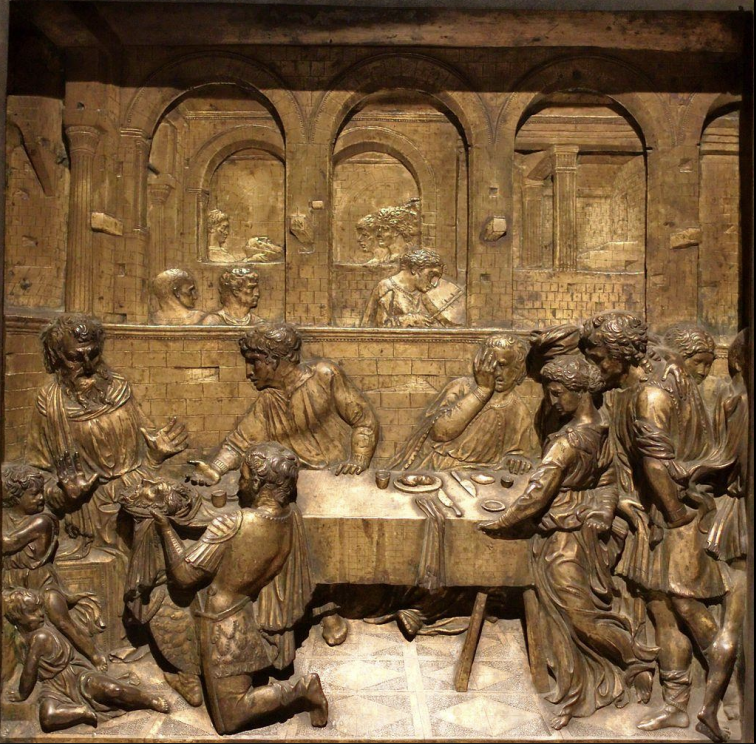
The Banquet of Herod
Donatello
Gilded Bronze
1423-27
Siena, Baptistry
Stiacciato technique allows for three different planes
Characters creating dramatic and horrible scene
There is a void in the middle
Server brings head of St John, offers it to Herad who asked for John to be beheaded but is still disgusted by the sight
Perspective in foreground gives intense drama
Second plane shows musicians
Third plane, executioner offering head of St John the baptist to us
Sophisticated technique gives opportunity to create space and depth
On the other side, Donatello suggested that perspective gives opportunity to tell a lot of other things, because different layers provide more speace
Linear perspective
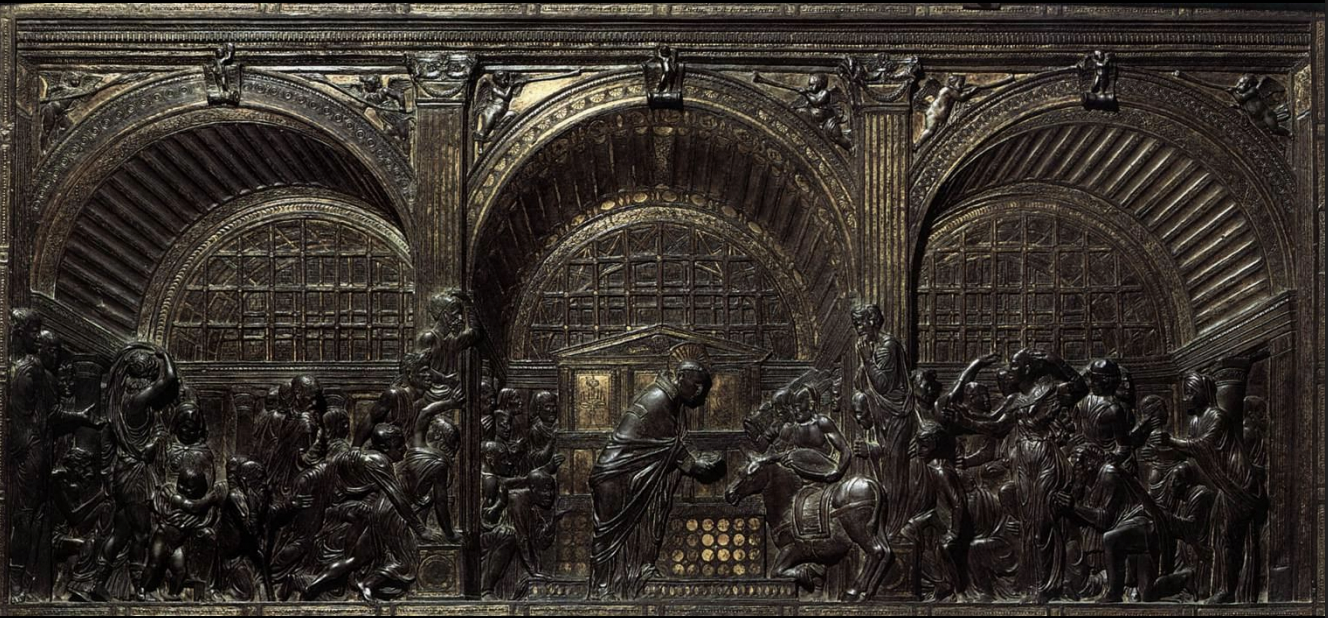
Miracle of the Ass
Donatello
Gilded Bronze 1446-49
Padua, Basilica di Sant’Antonio
Shows miracles performed by Saint Anthony of Padua
The miracle is that a non believer told the Saint that they wouldn’t believe unless the donkey came out of its stable and knelt before the Eucharist and didn’t eat the food spontaneously and we see in the scene that it does
Today many pilgrims still go, same thing happening in the 15th century being renowned for pilgrims
Called Donatello up and commissioned him for a group of statues to be framed by altar
Stiacciato example
Complicated work, middle is the miracle
Today we think it’s an odd scene
Framed by architecture, reminds us of ancient architecture in the Roman forum
How Donatello works thorugh the bronze and creates a shadowed impression
How the image of the large arches to give the impression that there’s not a wall at the end of the scene but gives unsettling space that it is so deep that we don’t know where its going
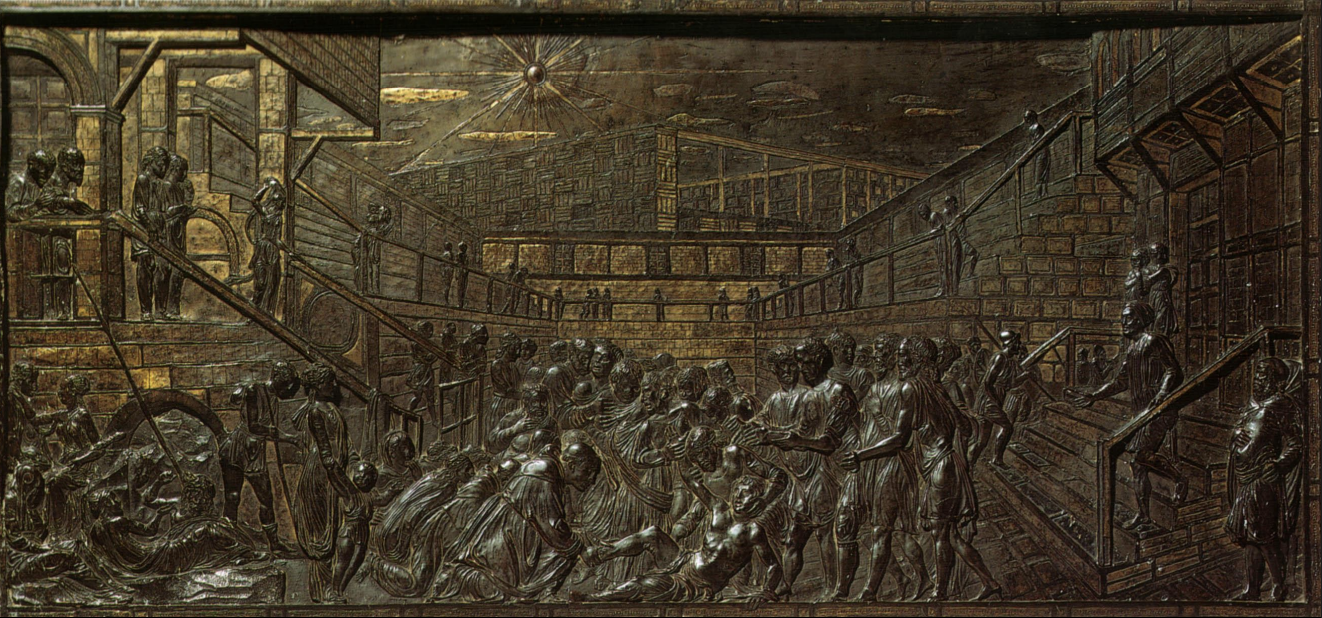
Miracle of the Repentant Son
Donatello
Gilded Bronze
1446-53
According to the stories of Saint Anthony, a young man confessed to the saint that he had kicked his mother. Anthony, to deplore his action, told him that the leg stained by such a sin deserved to be cut off. The repentant man, upon returning home, not understanding the meaning of the words, cut off his own leg, and news of his punishment spread throughout the city. Anthony immediately went to the man and, after explaining the meaning of his words in a prayer, miraculously reattached his leg.
Large number of figures in just a few cm of thickness
Looks like a very deep and abstract space
Donatello creates abstract spaces sometimes
Space is measurable in one sense but behind we cannot understand what the building is
On one side there is light and on one there is shadow
Figures perfectly portrayed in their actions
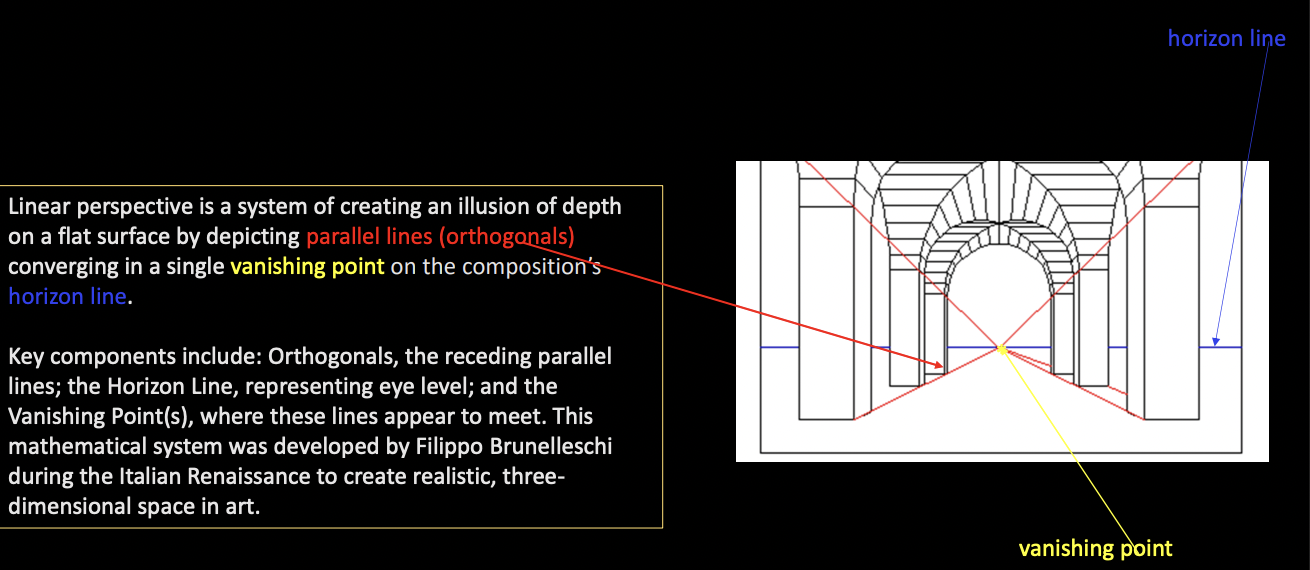
Linear perspective
A system of creating an illusion of depth on a flat surface by depicting parallel lines (orthogonals) converging in a single vanishing point on the composition’s horizontal line.
Key components include: Orthogonals, the receding parallel lines, the horizon line, representing eye level; and the vanishing point(s), where these lines appear to meet
This mathematical system was developed by Filippo Brunelleschi during the Italian Renaissance to create realistic, three dimensional space in art
Representation is based on the definition of the viewpoint, from which visual rays emanate forming the visual pyramid; the perspective image is the intersection of the visual pyramid with the plane of the picture; parallel lines converge at that point (vanishing point)
Linear perspective was a turning point because Florentine culture changed the arts across Europe, but there were still moments of resistance
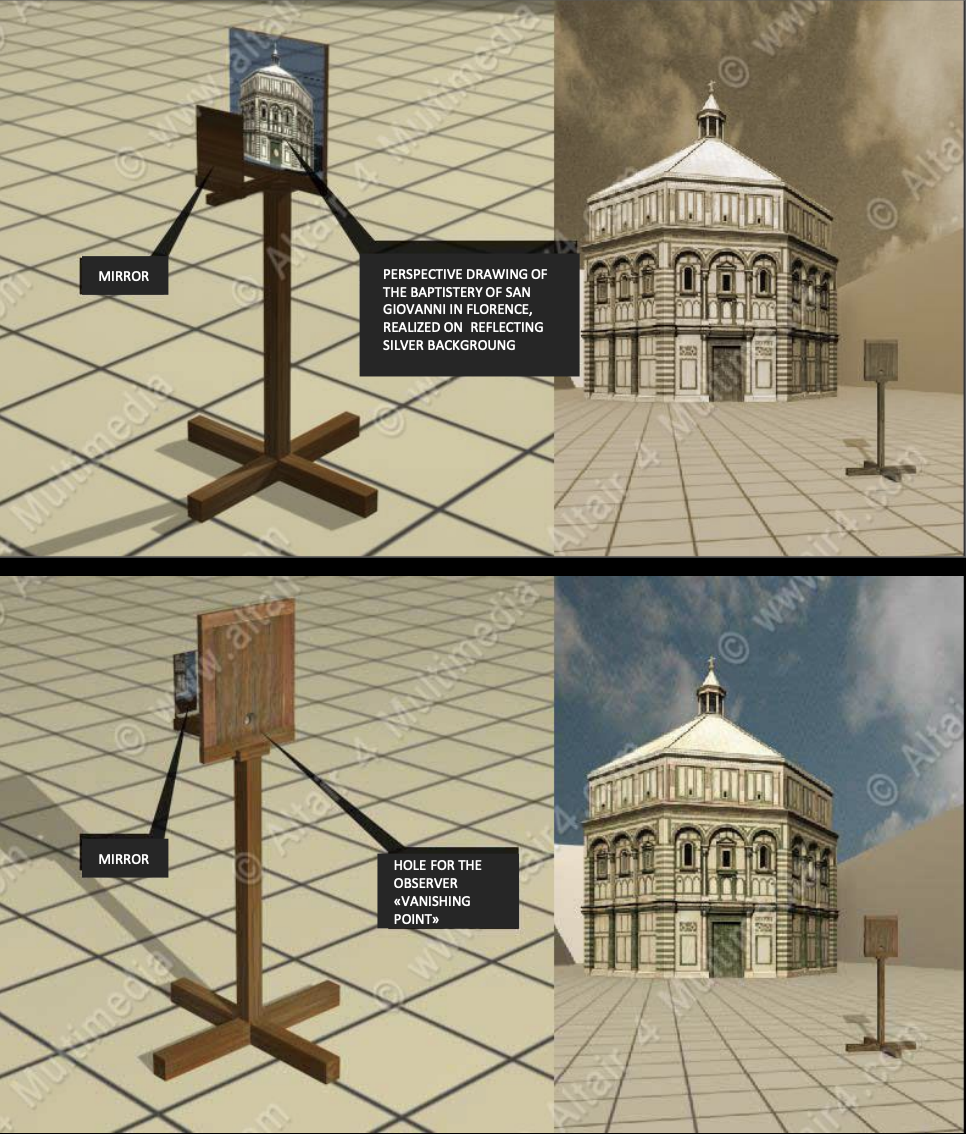
Putting people in the right position for the mirror to see a small painting
Perfect because put object in front of baptistry
Showed how good his method was because when the mirror was moved, it was possible to see the real baptistry, which matched up perfectly with the image reflected in the perspective drawing
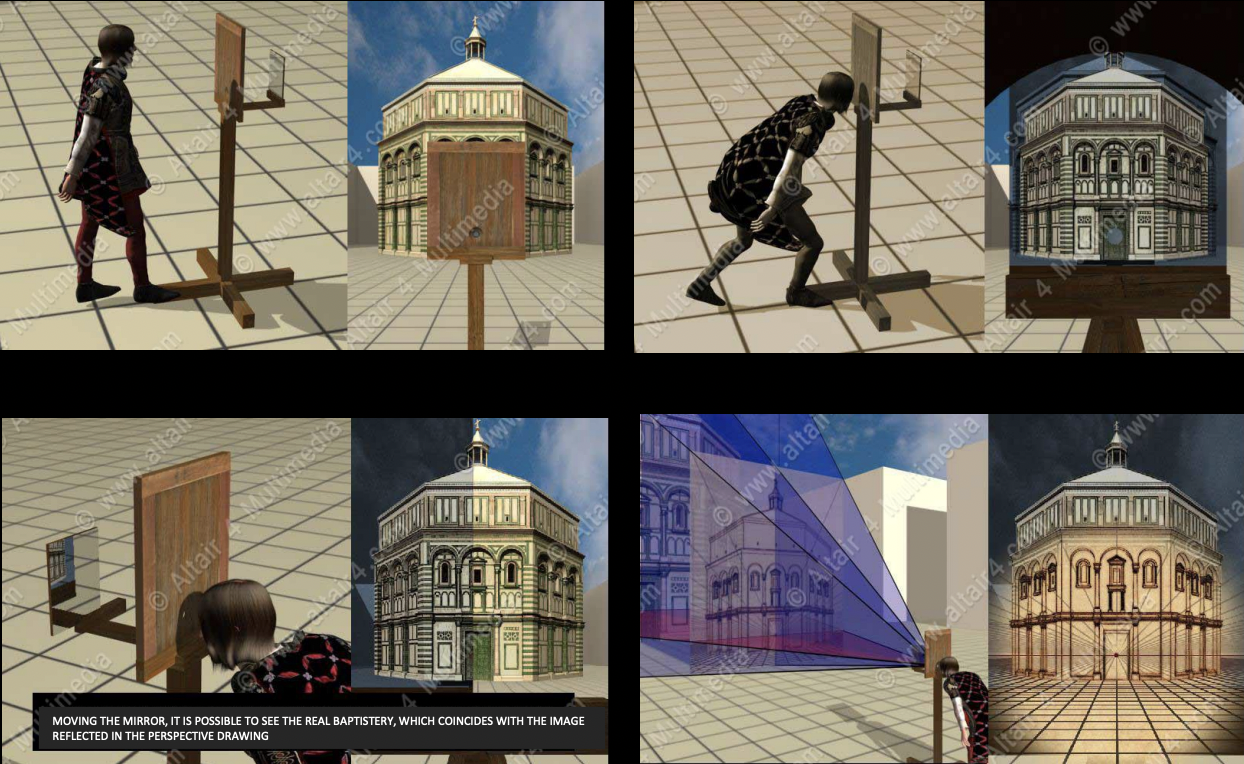
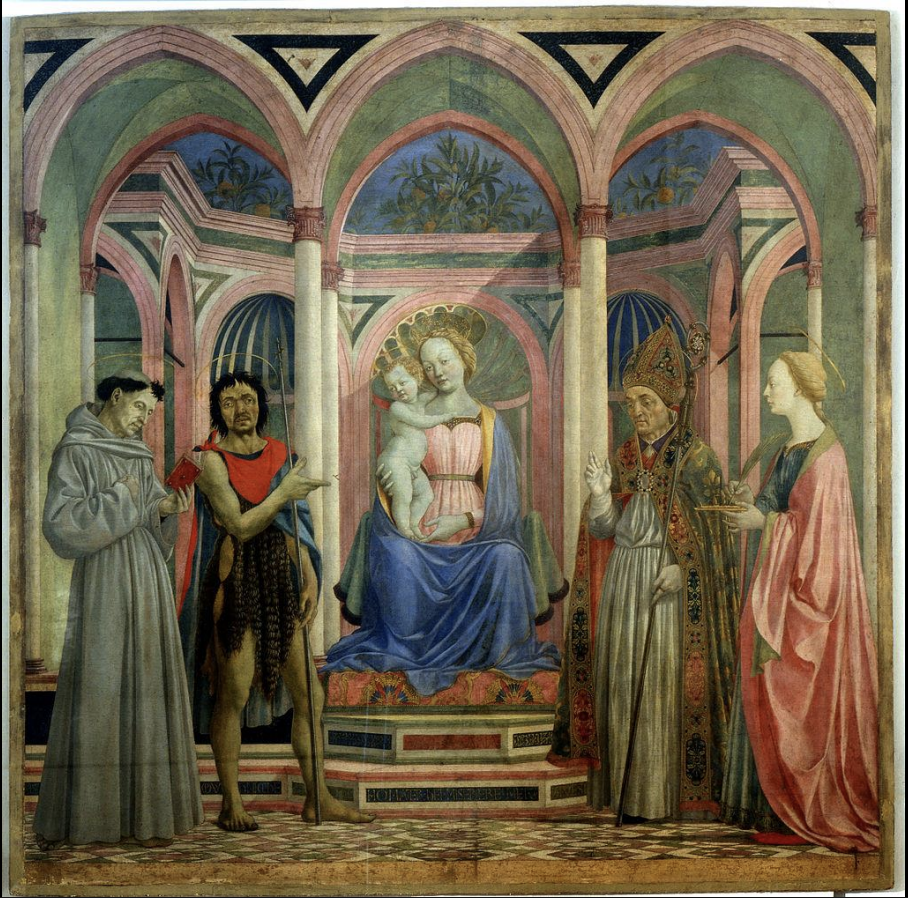
Domenico Veneziano
Pala di Santa Lucia dei Magnoli
1445-1447
tempura on wood
Firenze, Uffizi
Mary in the center, saints to the side
Interesting because of the impression it gives of space
Bright colors
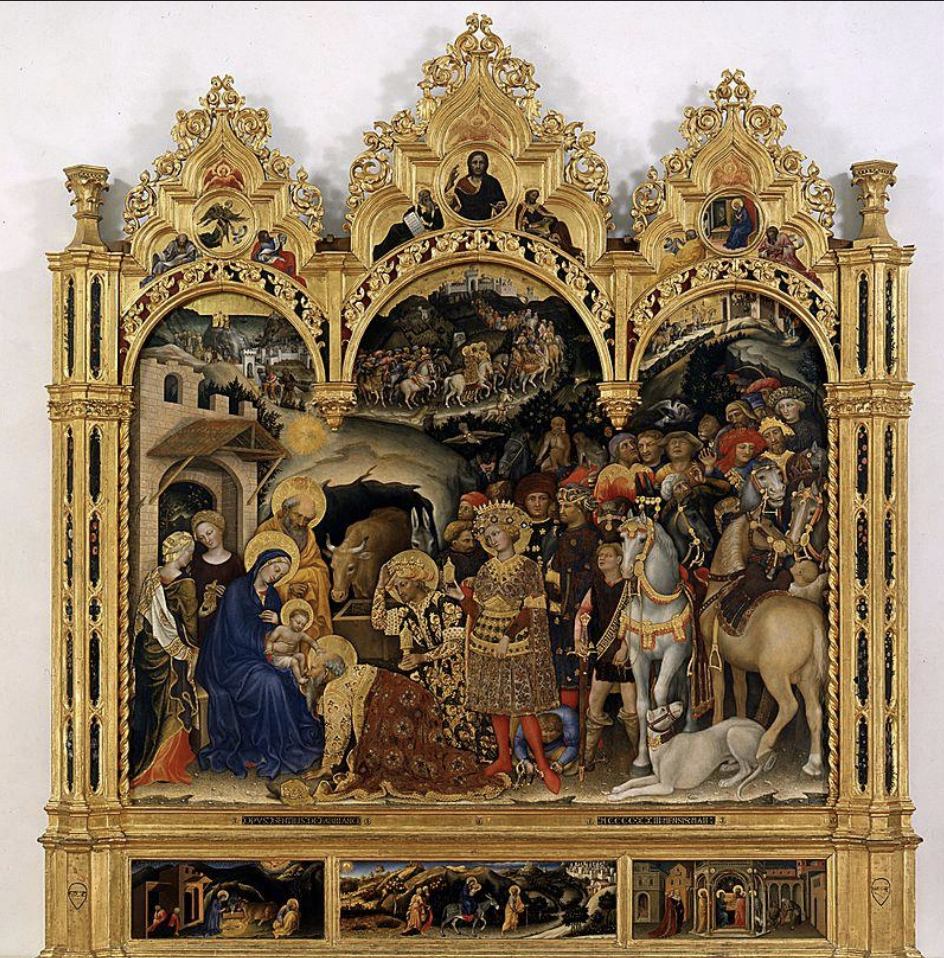
Gentile da Fabriano
Adoration of the Magni
tempura on wood
1423
Firenze, Uffizi
Ignores the linear perspective
Different way to do space
Even though the new method was successful and spread quickly, there were people, like Fabriano, who resisted or ignored or preferred the other methods
Linear perspective was a turning point because Florentine culture changed the arts across Europe, but there were still moments of resistance
The panel portrays the path of the three wise men in several scenes which start from the upper left corner (the voyage and the entrance into Bethlehem) and continue clockwise, to the larger meeting with the Virgin Mary and the newborn Jesus which occupies the lowest part of the picture
Exotic animals such as monkeys, horses, camels, and lions signify the patron's wealth and status, as well as creating an exotic setting relating to the biblical scene of the painting.[3] Arabic imitation script is evident in the artwork, elevating the work's significance in regards to its luxury and exoticism.
Mary’s robe paint color very expensive, shows she’s important
Gold and silver also used to add dimension because it raised off the surface of the painting
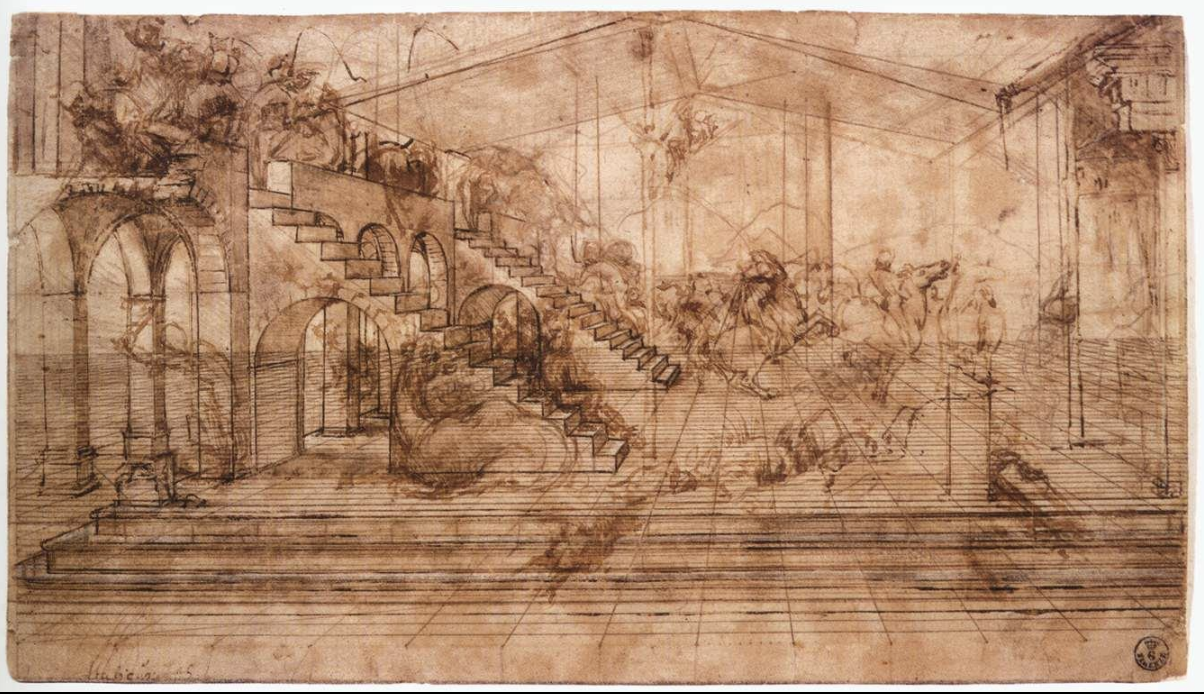
Leonardo da Vinci
Perspective study for the Adoration of the Magi, metalpoint, pen, ink, and white lead on paper
Behind the scenes
1481, Uffizi Florence
Working on architecture
Building linear perspective
Studying people, horses, etc, that can be fitted to the space
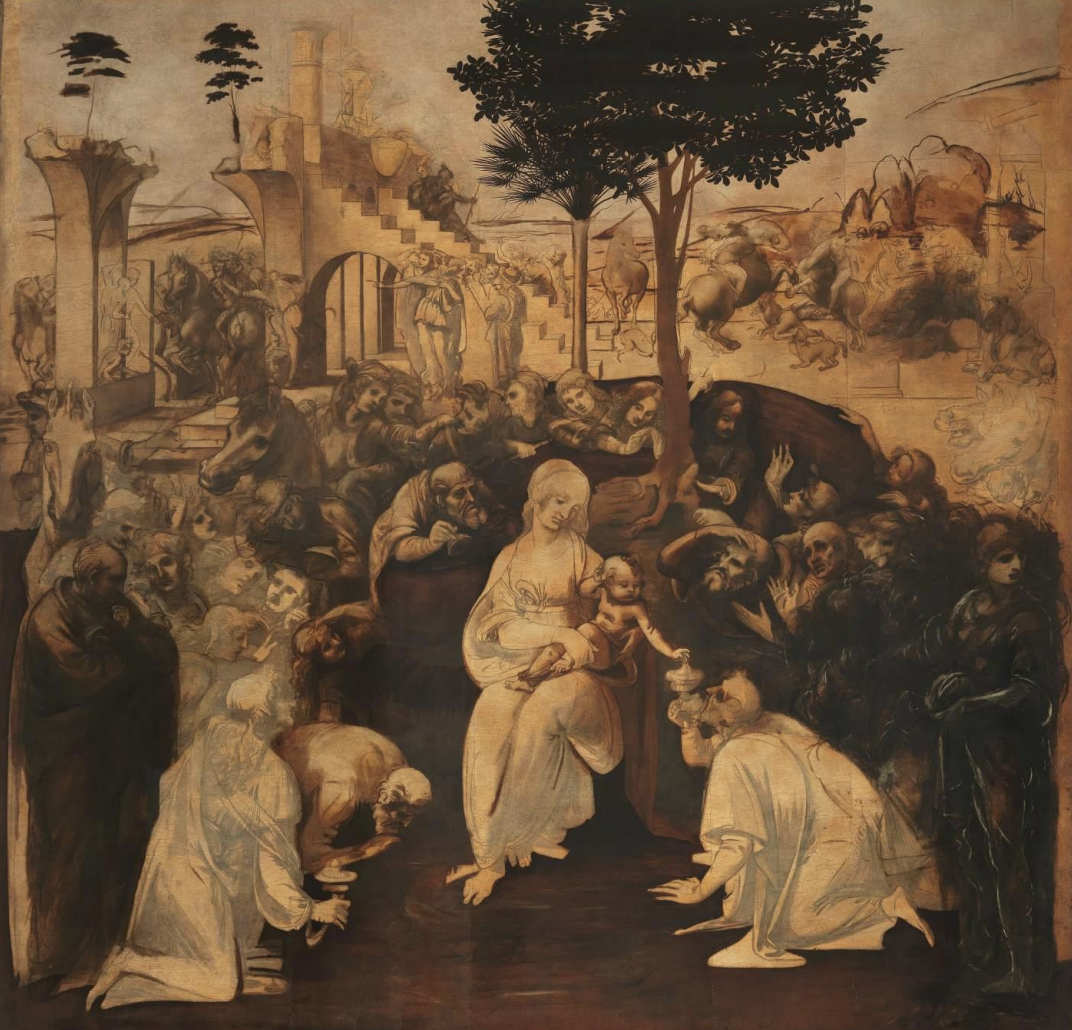
Leonardo da Vinci
Adoration of the Magi
Charcoal, watercolor, ink and oil on wood
Galleria degli Uffizi, Florence
New interpretation of the subject
3 kings followed a star to Jesus
Same subject as others painted before, he wanted to show through background that the appearance of Jesus, he symbolized
Background very relevant

Unknown painter
View of an ideal city
1470 circa
Urbino
Galleria Nazionale delle Marche
Making a perfect city for modern times
Interesting for us that the floor and composition of building, impression that we can walk within the city
Artists fascinated because space seemed so real
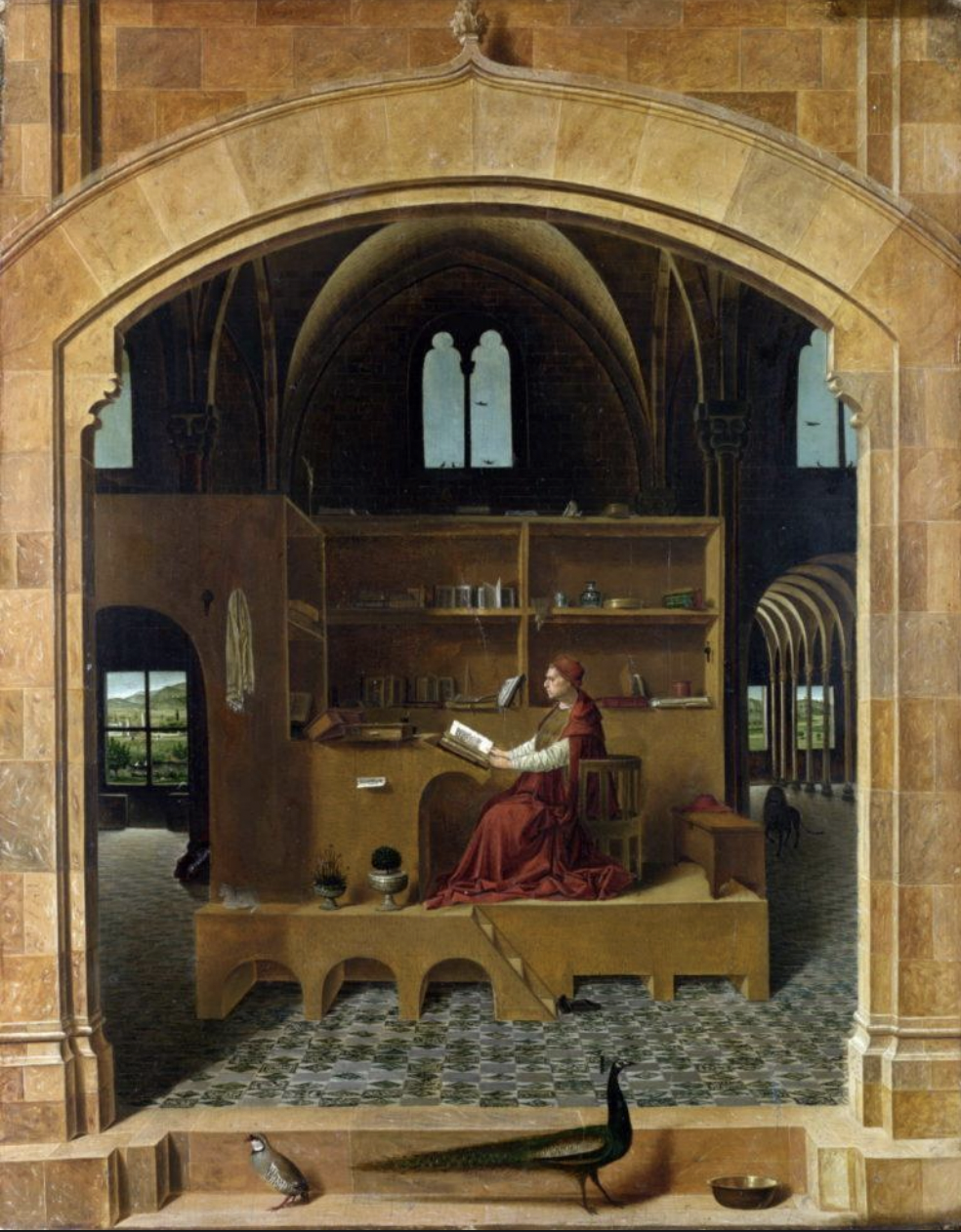
Antonello da Messina
St Jerome in his Study
C 1474
Oil on wood
National Gallery London
He was born in a territory, now Italy, but was ruled by Spain, Catalan
Knew the spanish style
Simple linear method is enough to create illusion of a true space
Light is used very well
The arch frames the space inside
Can see through the building all the way through the windows behind to fields
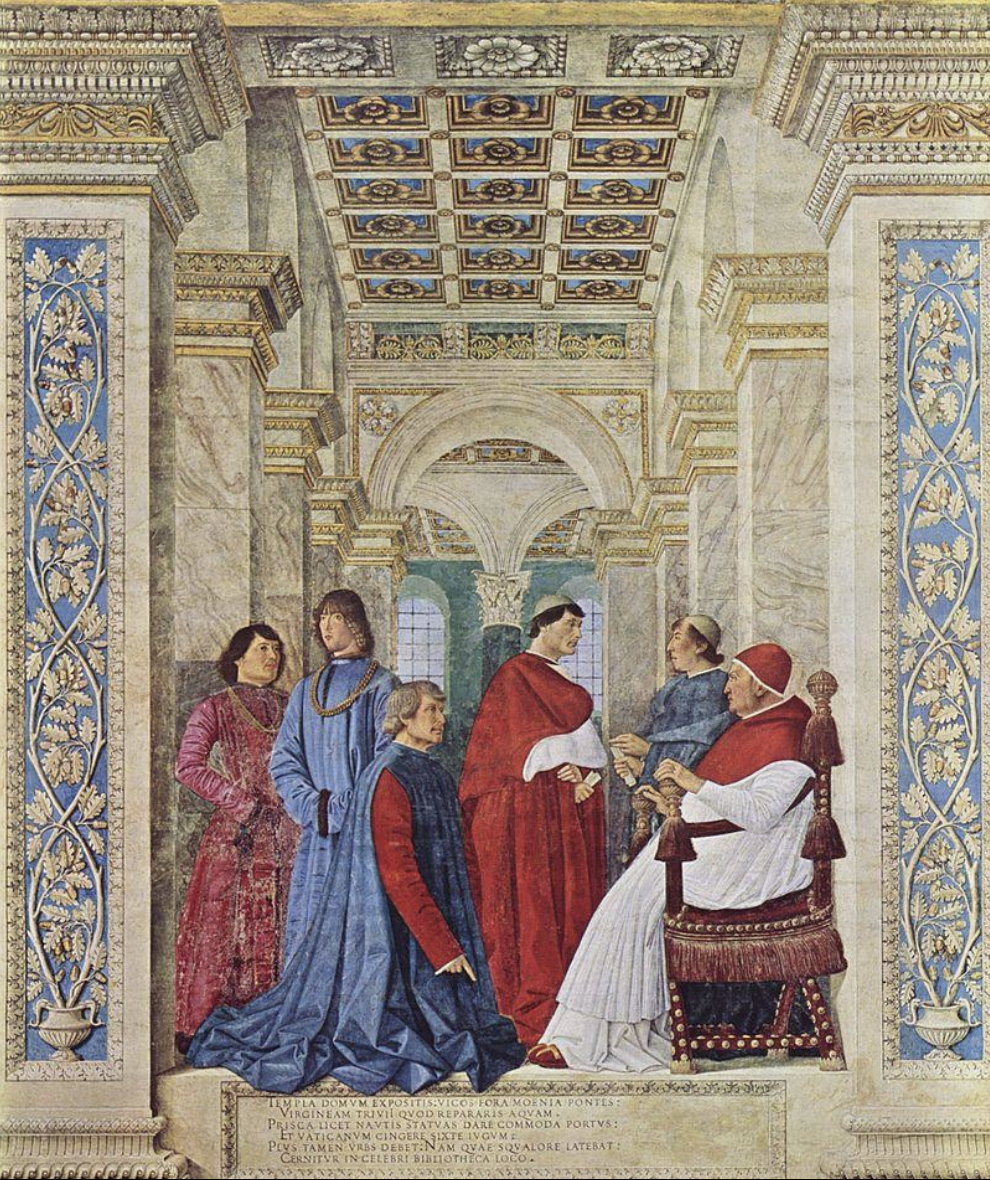
Melozzo da Forli
Pope Sixtus IV appoints Platina as perfect of the Vatican Library
Fresco 1477
Rome Vatican Palaces
Wall of Vatican library
See how people look real and in a real space
The space has been calculated well
Platina is pointing down to an inscription, written by himself, which boasts Sixtus’ deeds
Background is perspective representation of a classic architecture
The scene shows the Pope, seen slightly from below, faced by the kneeling humanist Bartolomeo Platina, together with the Pope's nephews: the two cardinals, Giuliano della Rovere, standing in front of the Pope, and Raffaele Riario behind his chair.
To the left are Girolamo Riario and Giuliano's brother Giovanni della Rovere on the left. Giuliano della Rovere was later to become Pope Julius II.
Leon Battista Alberti
Thanks to social standing, had good education, good intellect who could speak to other aristocratic people
Succeeded to transform the connotation of artists in his time
Not just people working with hands but also people who could think
Book dedicated to Brunelleschi because he helped create linear perspective
Relevant figure in the culture
Speaks of revolution of arts and sciences
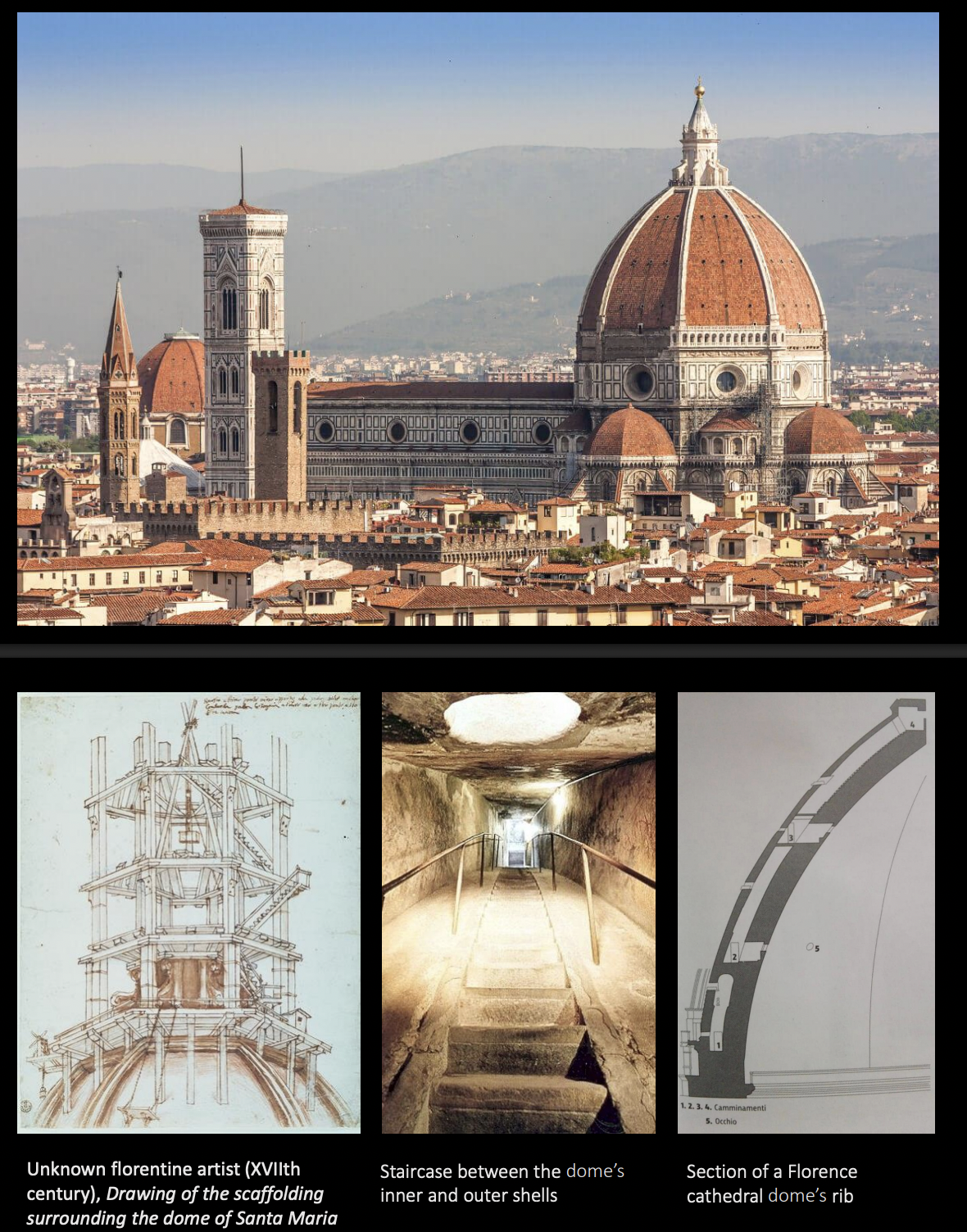
Brunelleschi built dome of the Santa Maria del Fiore, duomo in Florence 1420-1436
Succeeded because experimented with new method
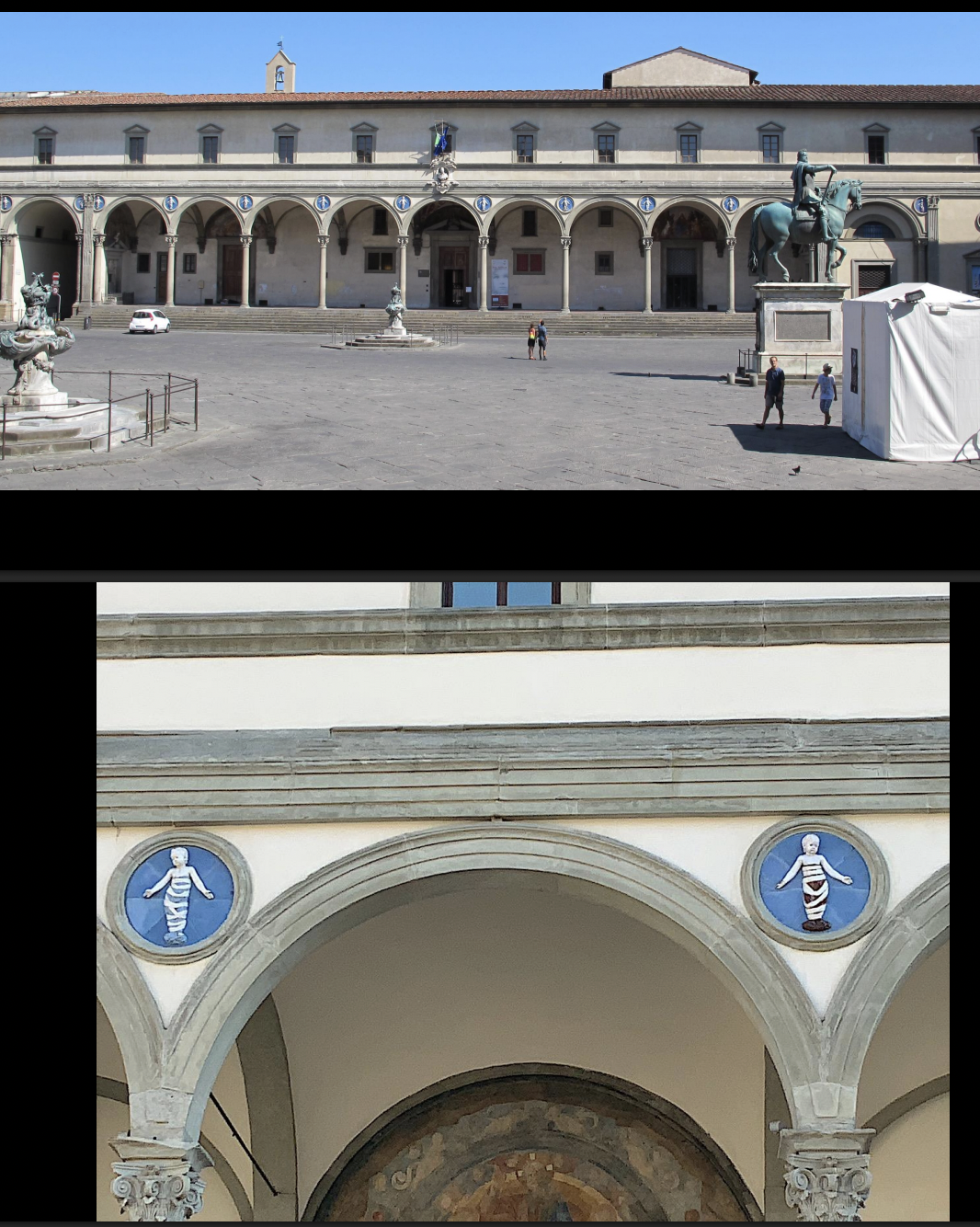
Filippo Brunellesci
Spedale degli Innocenti
1419
Facade, Florence
Important place in the middle of the city
Proposed new vision of architecture
Orphanage
Outside is white plaster, sandstone
Civic buildings had to be more simple
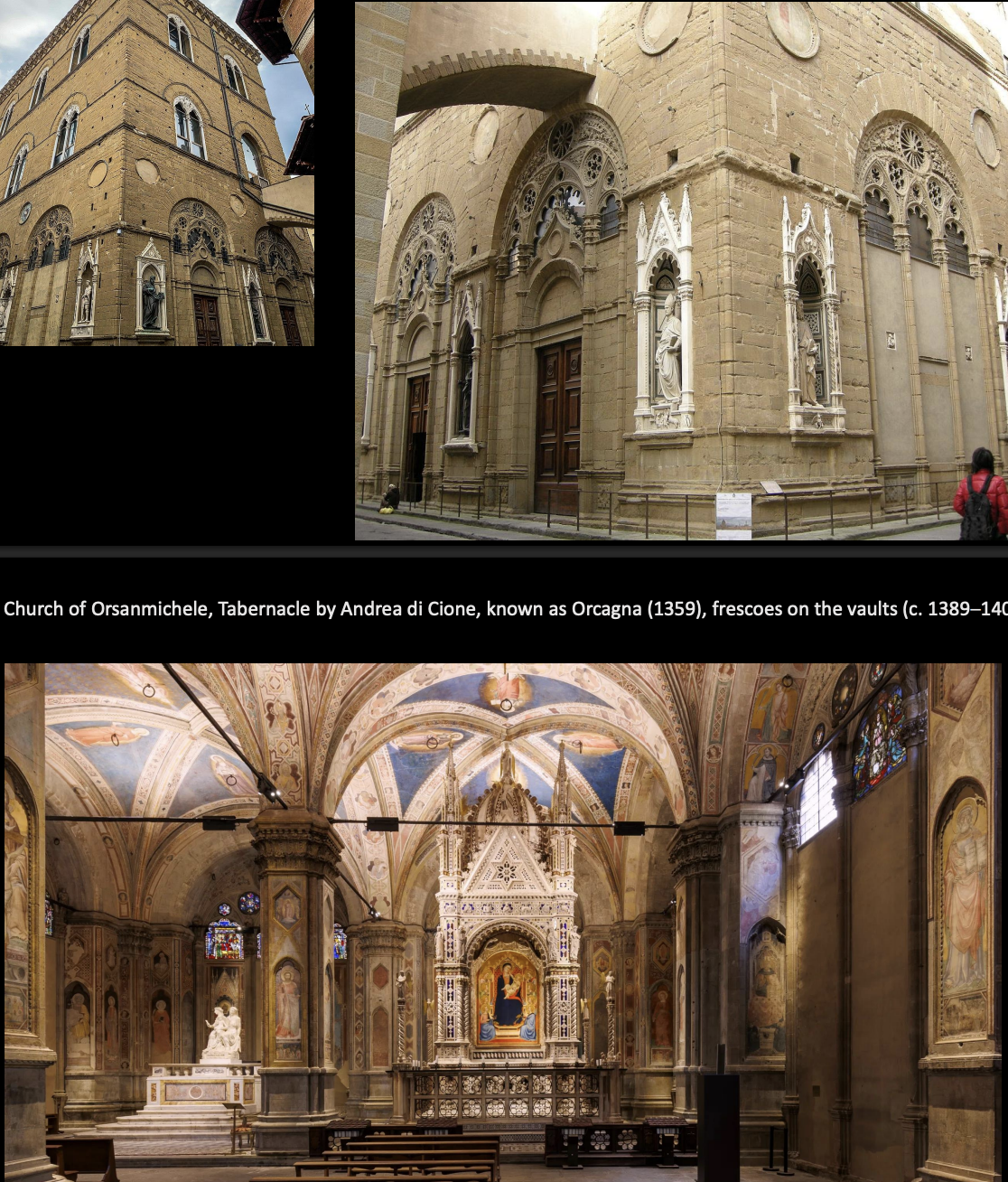
Church of orsanmichele
Avoiding gothic tradition, going for simplicity
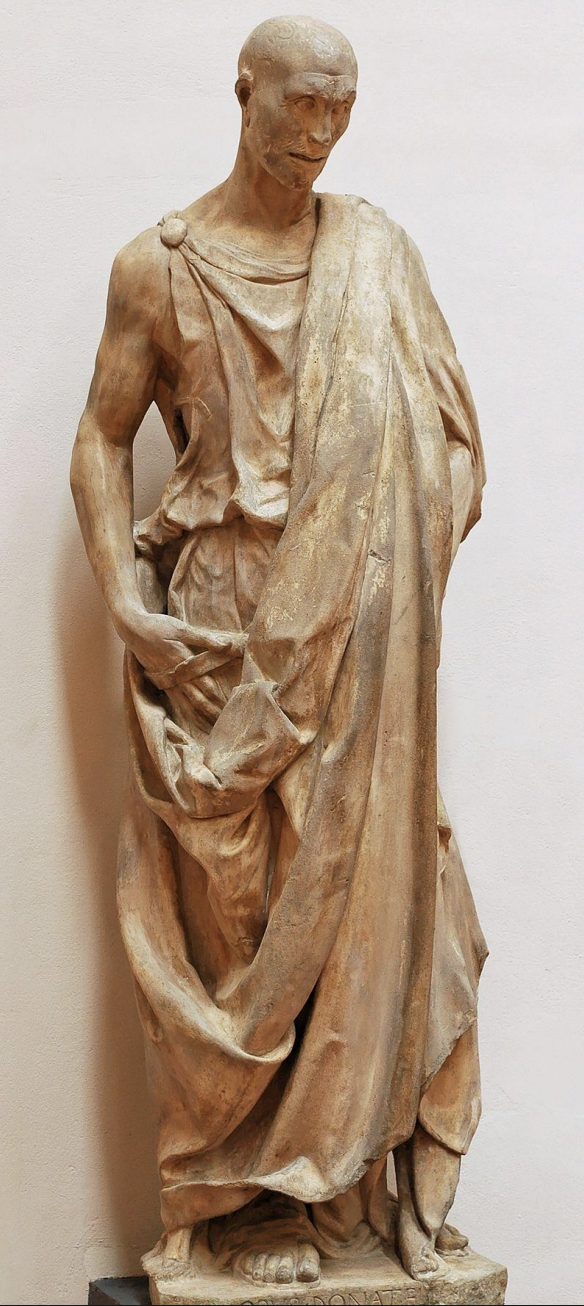
Donatello
Habakkuk (commonly called Lo Zuccone) The bald one
Marble
1423-25
Firenze
Praise humanity even though its not beautiful
Not get an idealized view of man
Human beings have their own power
Modern idea
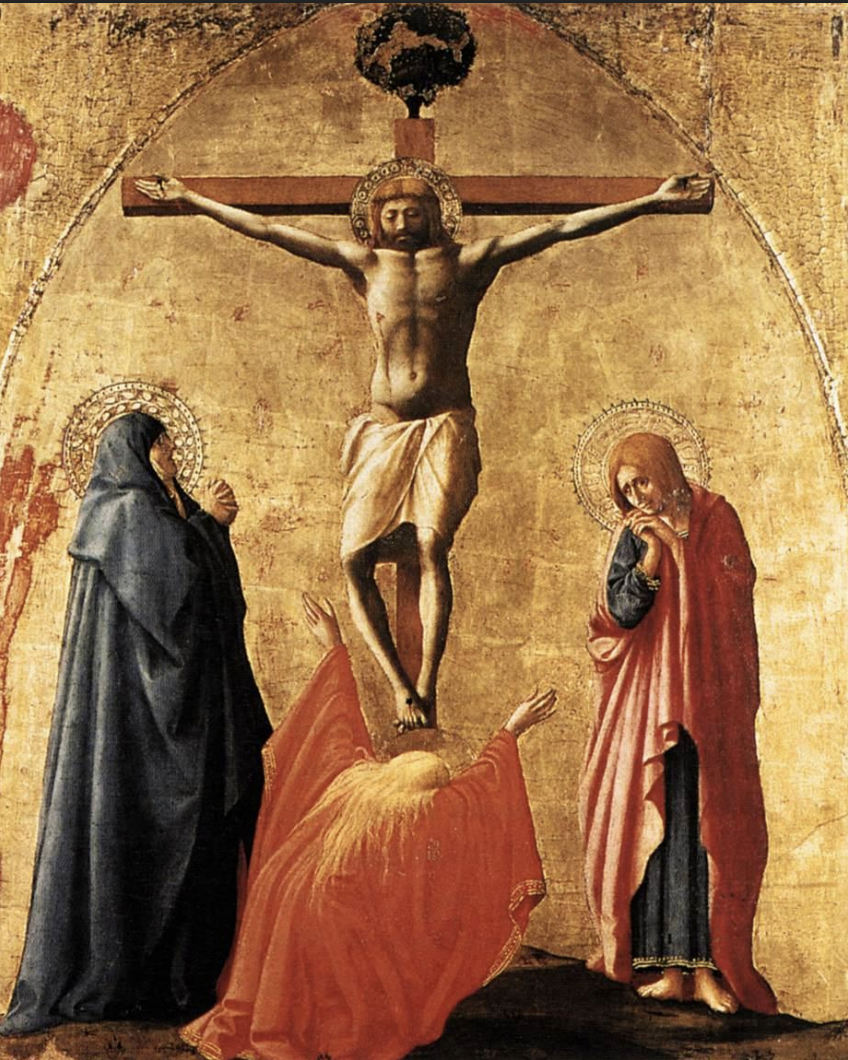
Masaccio
Crucifixion
1425
From the Polytych of Pisa
Napoli, Capodimonte
Hiding Jesus’ neck
Angle from below
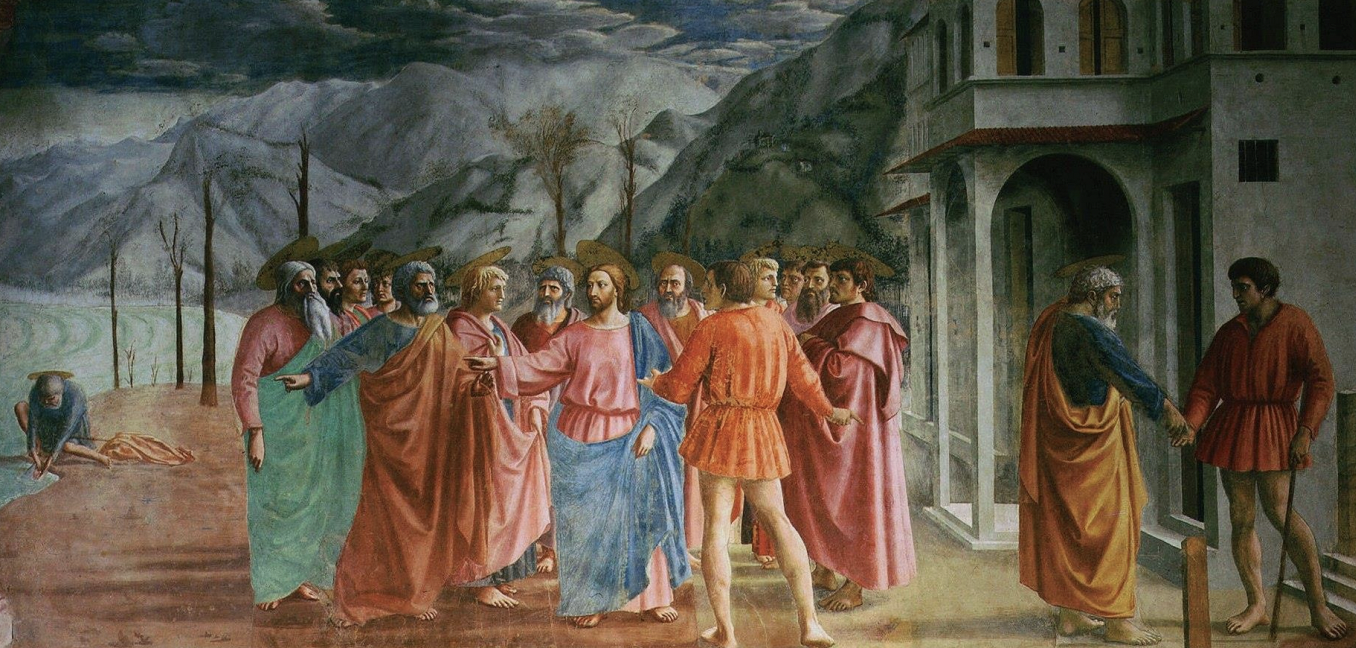
Masaccio
Payment of the tribute
1425
Florence, Santa Maria del Carmine, Brancacci Chapel
Landscape, architecture, and people
Gives impression of 3 different moments
Describes a scene in which Jesus directs Peter to find a coin in the mouth of a fish in order to pay the temple tax.
Colors are very simple
Artist is working like Giotto had done, colors are Giottos
Creating volume and characters
Young Michelangelo will watch Giotto and Masaccio
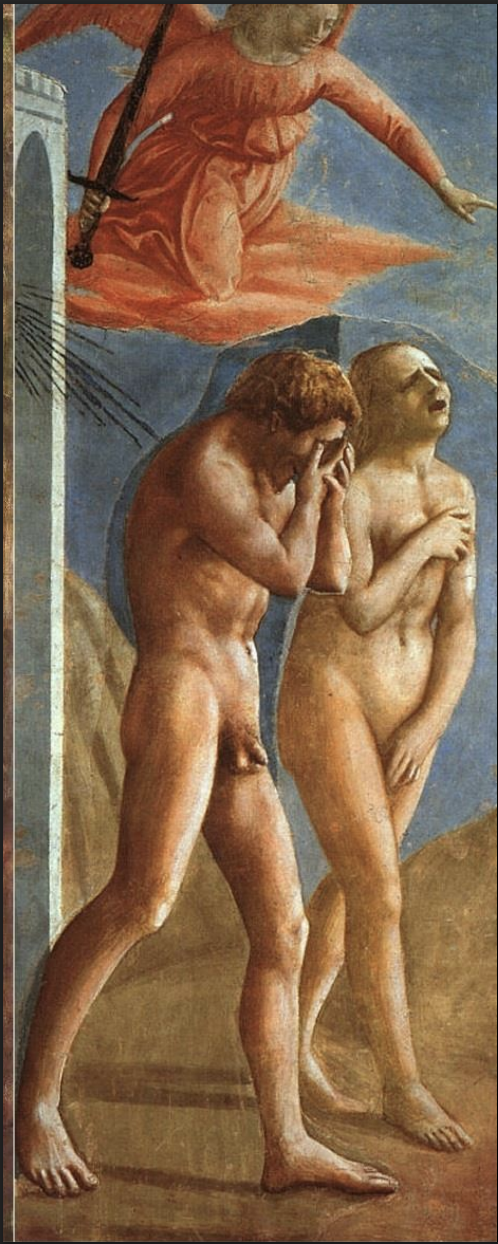
Masaccio
The Expulsion of Adam and Eve from Paradise
1424-28
Fresco
Firenze, Santa Maria del Carmine, Brancacci Chapel
Wants to show that they are naked and know it so trying to cover themselves
Covering feels less scandelous
The two are completely fallen
Masaccio is working on human feelings, one of the strongest images because the face of Eve is suffering and Adam is covering his
Giotto
Giotto di Bondone, known mononymously as Giotto, was an Italian painter and architect from Florence during the Late Middle Ages. He worked during the Gothic and Proto-Renaissance period.
Key Themes of the Early Florentine and Italian Renaissance
A renewed interest in and rediscovery of ancient art, culture, and civilization, including classical philosophy and ethics
A fascination with perspective, embraced as a revolutionary method of representing space and humanity's place within it
A new appreciation for the dignity of human beings, valued for their intrinsic worth and individuality
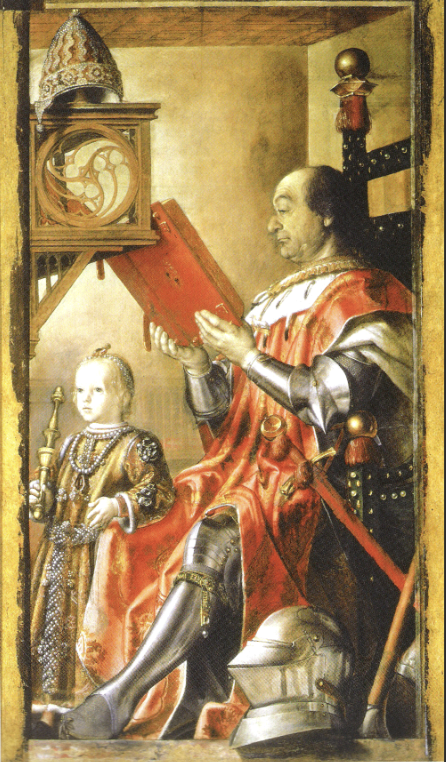
Pedro Berruguate
Portrait of Federico da Montefeltro with his son Guidobaldo
1480-81
Federico was a humanist and military leader
Son: had so many daughters and only one son, was always sick so Federico really counted on him
Boy is wearing ceremonial robe and holding scepter
They are in the studio surrounded by symbols of his power and interests
Upper corner shelf, is a headpiece full of pearls and this is shown because it comes from abroad and is expensive
Wearing armour which could have to do with showing off his military strength
On his left leg is a garter given to him by the King of England
Duke sits on a sort of throne reading a codex, expensive for its time, connects to his humanist interests
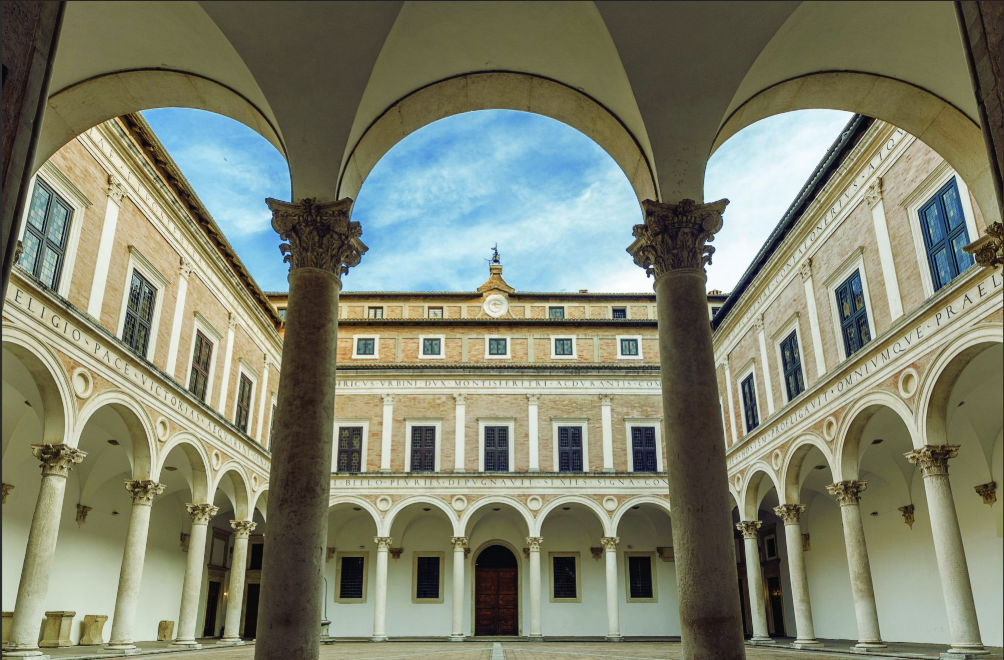
Ducal Palace
Federico da Montefeltro
Lord of Urbino and became duke later on
The exterior of the palace is unfinished
There are round towers that are military architecture protecting the sky
Medieval city gates
The Palace has simple arches and architecture
Why is everything so simple and plain?
“Federico, Duke of Urbino, Count of Montefeltro and Casteldurante….. Raised this residence from the ground up for the glory of himself and his descendants. He, who fought many times in war… victorious in every war, expanded his domain. His justice, clemency, generosity, and morality, in times of peace, equaled and honored his military victories.
Federico’s love for books and his efforts to build a great library are well documented by his librarian, Vespiano da Bisticci, who wrote the Vita di Federico da Montefeltro, the duke’s biography. Before entering Federico’s service, Vespasiano had been the librarian to Cosimo de’ Medici in Florence
Studiolo
Far away from public spaces within the palace but both a private and public space
Even though it has no window, is close to the facade
Illusion to allow more space
Wood gives viewer perspective
Federico armour
Just taken off armour and left his active and now devotes himself to religion
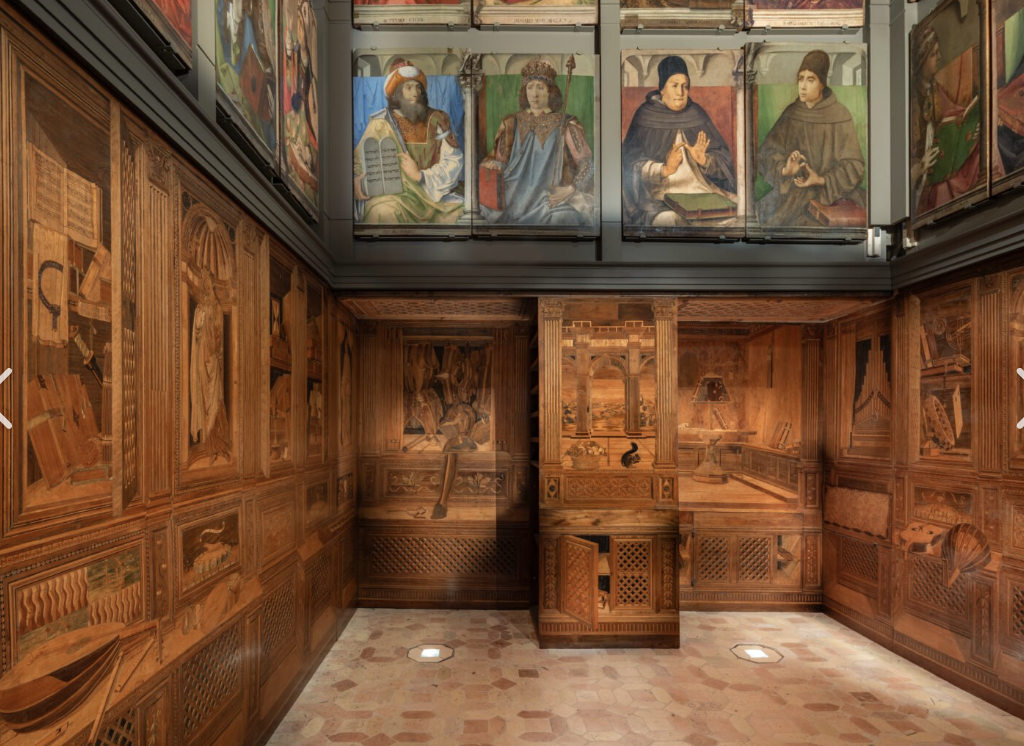
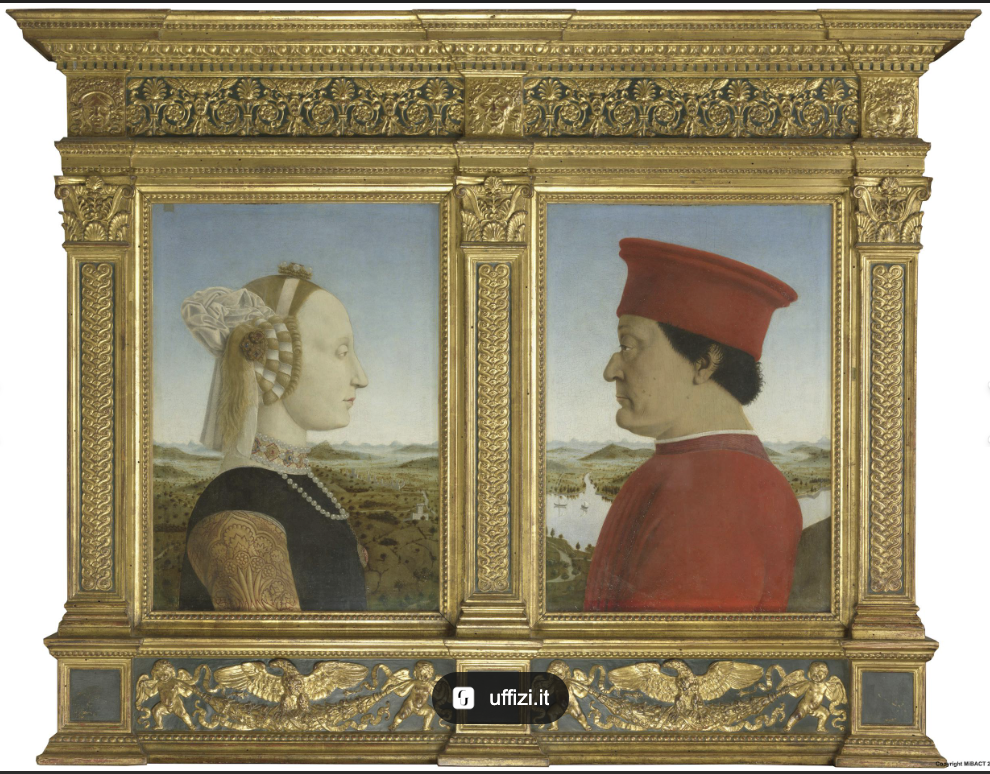
The Duke and Duchess of Urbino
Piero della Francesca
Federico da montefeltro and battista Sforza
1473-75
Oil on wood
Firenze, uffizi
Perfectly describe federico’s face
Pale skin is typical of women’s aesthetics
They are in front of part of their territory, declaration of dominion of this place
Uses style to give them opportunity to sit or stand in front of their land
Why portrait in profile?
This side profile gave them an angle that ensured a good portrayal of their features and a faithful representation of their facial details without allowing their emotions to show through (very straight face expressions)
Posture is one of confidence
New technique because oil on wood was brought to perfection by Jan van Eyck
One of the most celebrated portraits of the Italian Renaissance
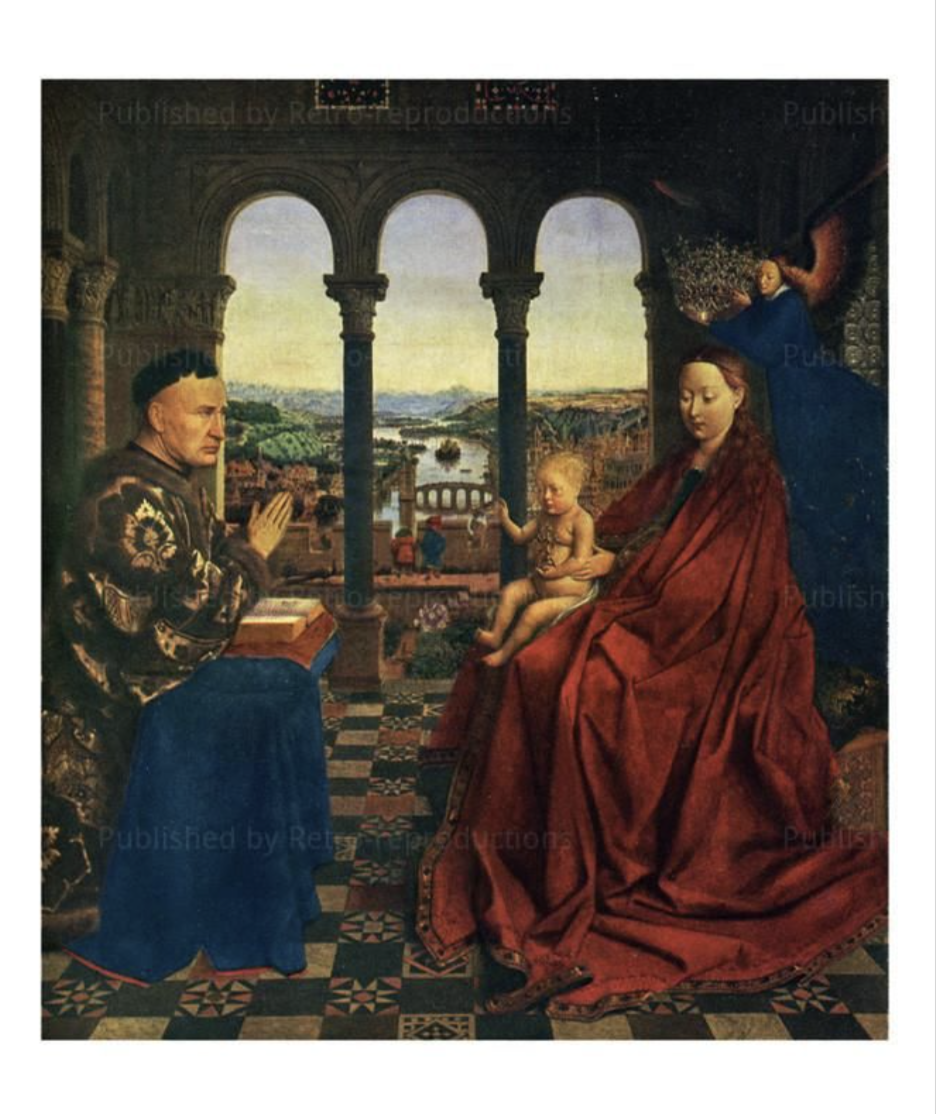
Jan van eyck
Madonna of Chancellor Rolin
Chancellor of a region in France
Oil on wood
Louvre in Paris
The scene depicts the Virgin Mary crowned by a hovering angel while she presents the infant Jesus to Rolin.
It is set within a spacious room with a rich decoration of columns and bas-reliefs.
In the background is a landscape with a city on a river, probably intended to be Rolin's hometown.
Open window onto the landscape
Good technique and style allows the indoors to be linked to the landscape beyond
Light coming from multiple directions
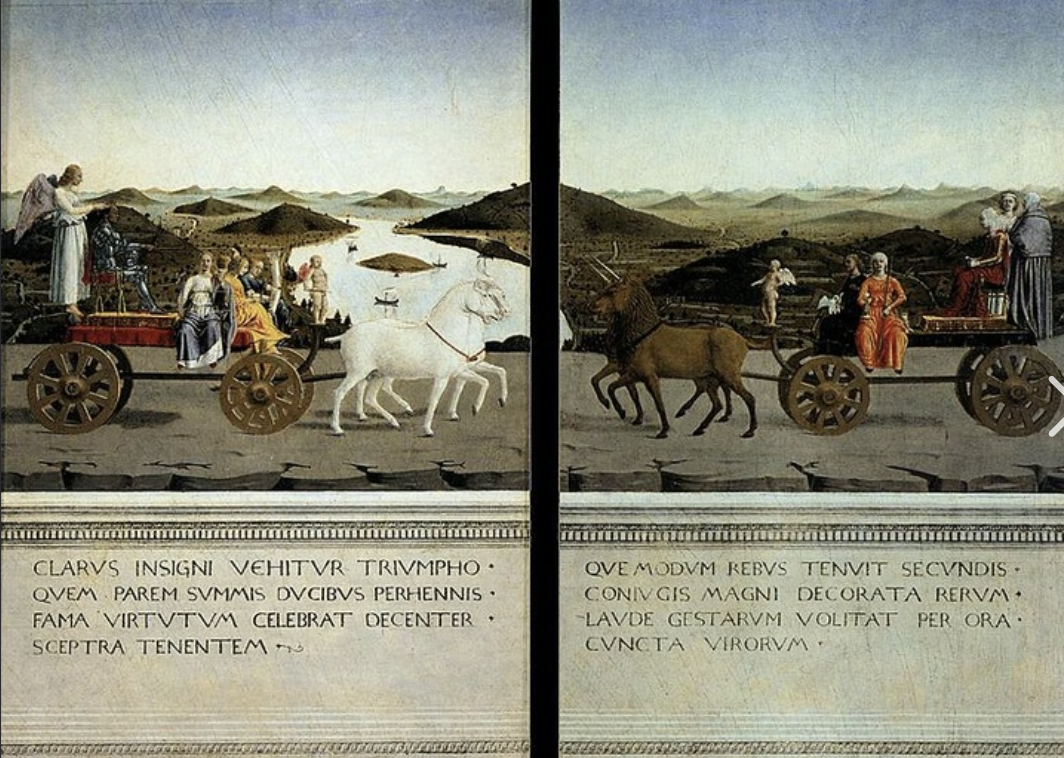
Reverse side of the portraits
Triumph of the duke and duchess
Federico led by white horses, animals led imperial chariots in ancient Rome, during triumphs of commanders
Federico is like these ancient commanders, celebrating military success
Figure putting crown on his head, figure really existed in ancient rome times, slave to continuously stay behind and hold the crown on his head
Others led by brown unicorns
Drawing is very clear and the technique for the landscape is delicate brushstrokes
There’s an attention to light, shows how he is looking at Flemish paintins and new techniques of painting with oil
Trained in the new technique and we know this because he progressed from the beginning of his career
Successful noble women
In a trial with her husband
Federico wanted to celebrate the couple
She had been a good marriage because of family and giving him many children, including one son
Arch of Titus: attic (the uppermost part of the arch)
Chariots could be on a triumphal arch
Quotation of archeological monument
Triumphal arches have chariots on top
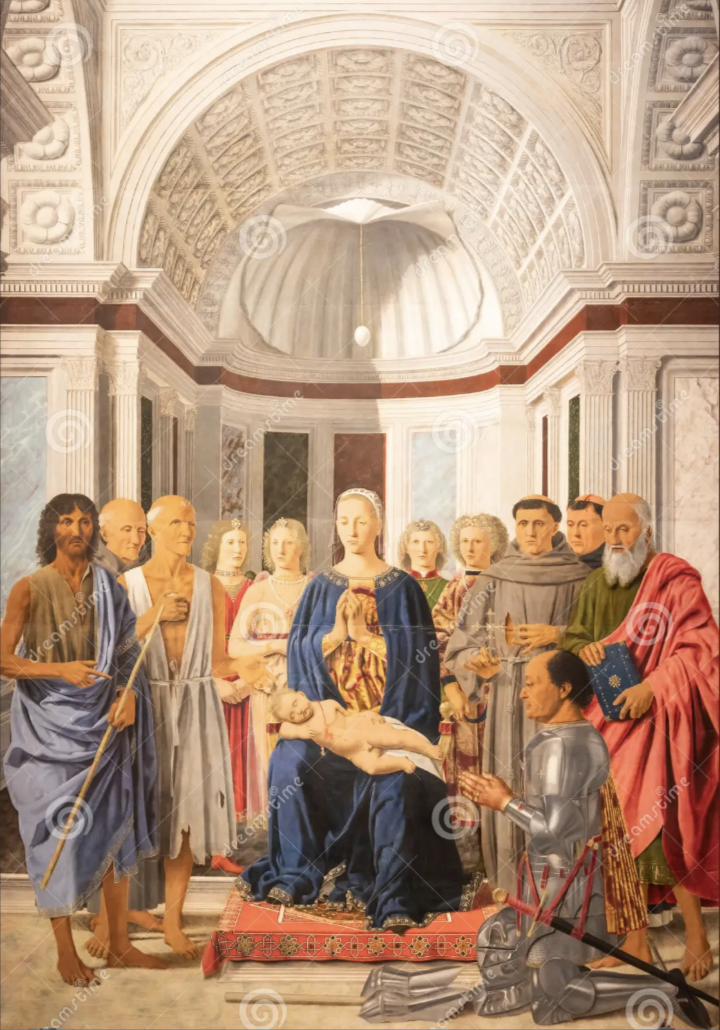
Piero della Francesca
Madonna and Child with Saints (Montefeltro Altarpiece)
1472-74
Painting for church was an achievment because it meant everyone would see your talent
Architecture is perfectly portrayed thanks to lighting and design
Likely he had in mind the design of a real basilica, the basilica of Sant’Andrea from 1470
Mary
The most important figure and in the middle
She is in a strange attitude
Mary meditating on the incredible job God has asked her to do
Baby is naked
One century later, Roman church will consider it a scandal to show Jesus naked
But now, different naked, but proof Jesus had become true child or man
Vertical, intellectual light, not quite a physical light
Although dimension and volume of light give realism
This painting was commissioned by Federico III Montefeltro, Duke of Urbino to celebrate the birth of his son Guidobaldo
The Duke is pictured kneeling to show devotion and wearing his armour
Wearing his armour could signify military strength and devotion to protect his faith which was a new concept for presenting in armour when in a holy presence.
Realistic portrait of hands and rings were painted by somebody else
Shoulders of duke, armour reflects window, helps us understand that the light is coming from a vertical direction, showing light is in our place
In the center hanging by a thread from the shell is an eg
Suggests the mystery of incarnation
First element: Sleeping boy, mary praying on him
Second element of silent preaching
Ostrich egg is enclosed within the shell
Meaning of ostrich egg is perfection
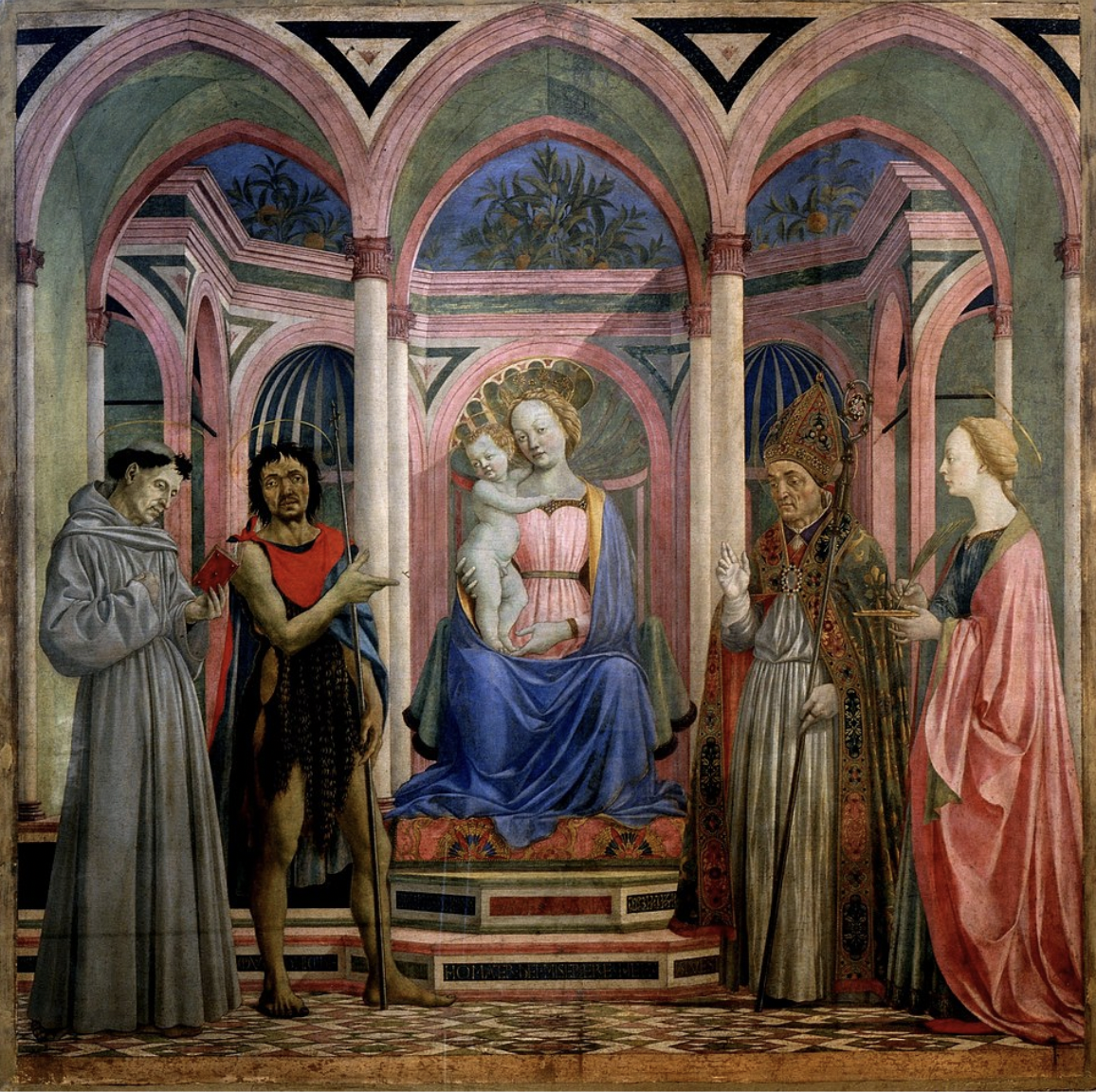
Domenico Veneziano
Santa Lucia de’ Magnoli Altarpiece
Uffizi Gallery
The first true painting of the Virgin and Child with saints on a unified scale and sharing the same space
Created a unified space
The base of the throne and floor have a geometric perspective which was an innovation introduced in early Italian Renaissance.
Saints are portrayed on the side
Modern for it’s time
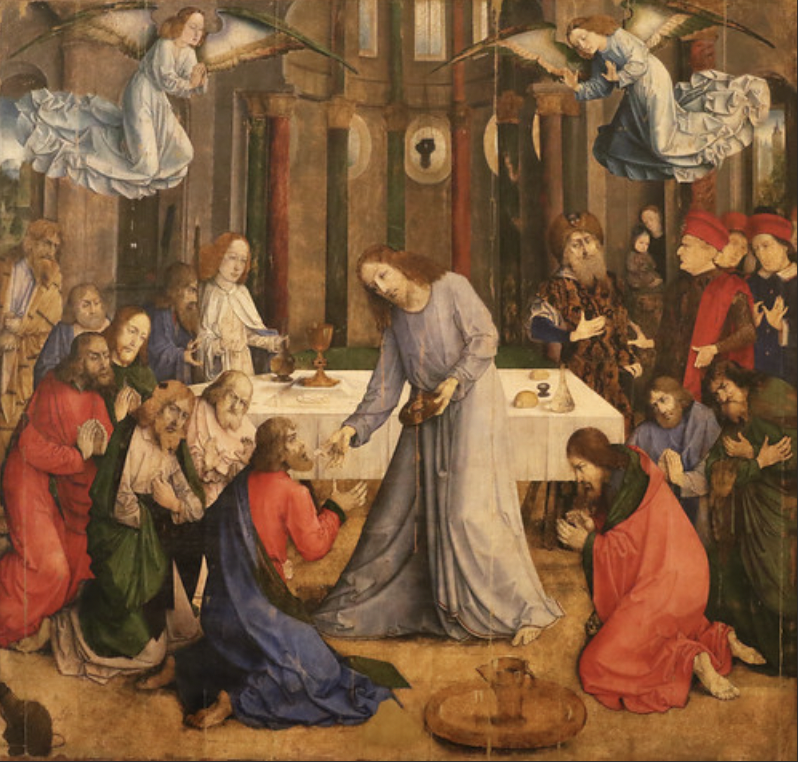
Joos van Wassenhove
Justus of Ghent, known in Italy as Guisto di Gand
Communion of the Apostles
Corpus Domini Altarpiece
1473-74
Tempera on wood
Same commissioner Federico, loved the different interpretations of style
Even the figures have no proper anatomy or how the body is supposed to move
Bodies more decorative than realistic
Strong colors, but faded over time
Drapery, typical of Flemish and German painting, was fascinating for Italian people
They love the new painting coming from Florence
Figure flying is interesting and attractive for people
Two small and beautiful landscapes
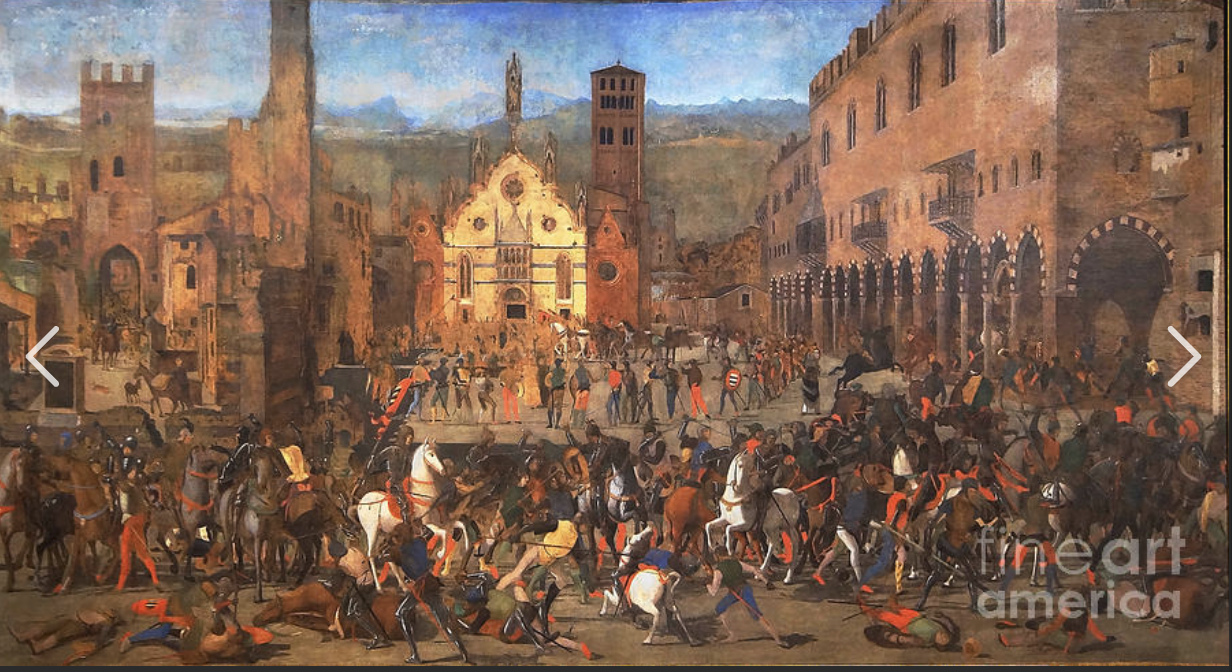
Domenico Morone
The Expulsion of the Bonacolsi
oil on canvas
1494
Commission from the Marquis of Mantua, Francesco II Gonzaga
Recalls this event and moments of drama with vivid details and historical accuracy
Thought to be a painting dedicated to the glories of the Gonzaga family
The work is thought to be about the victorious battle that Ludovico Gonzaga won for the possession of Mantua
Bonacolsi family were in charge until a member of the Gonzaga family killed their captain and took over as captain of the city
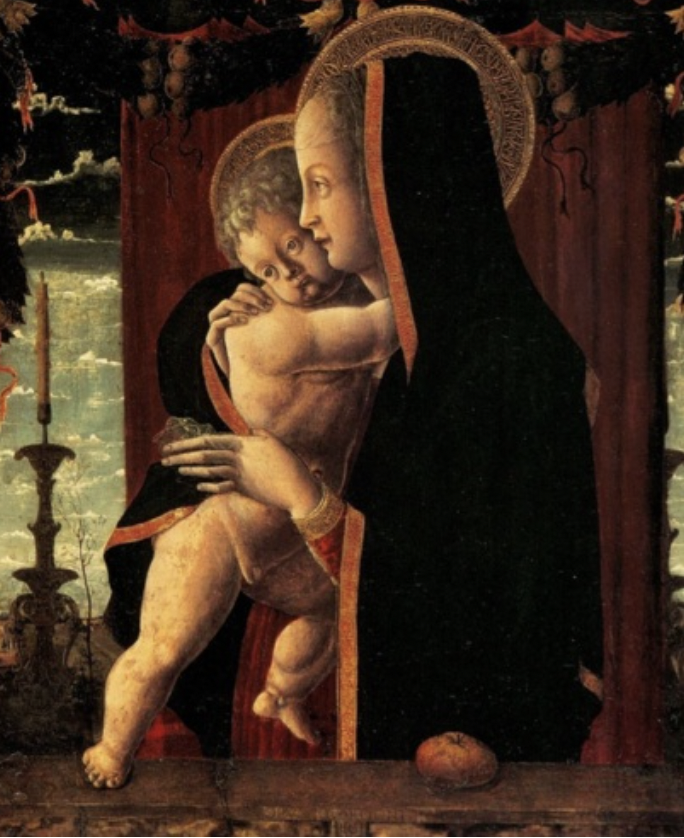
Francesco Squarcione
Madonna with Child, 1455
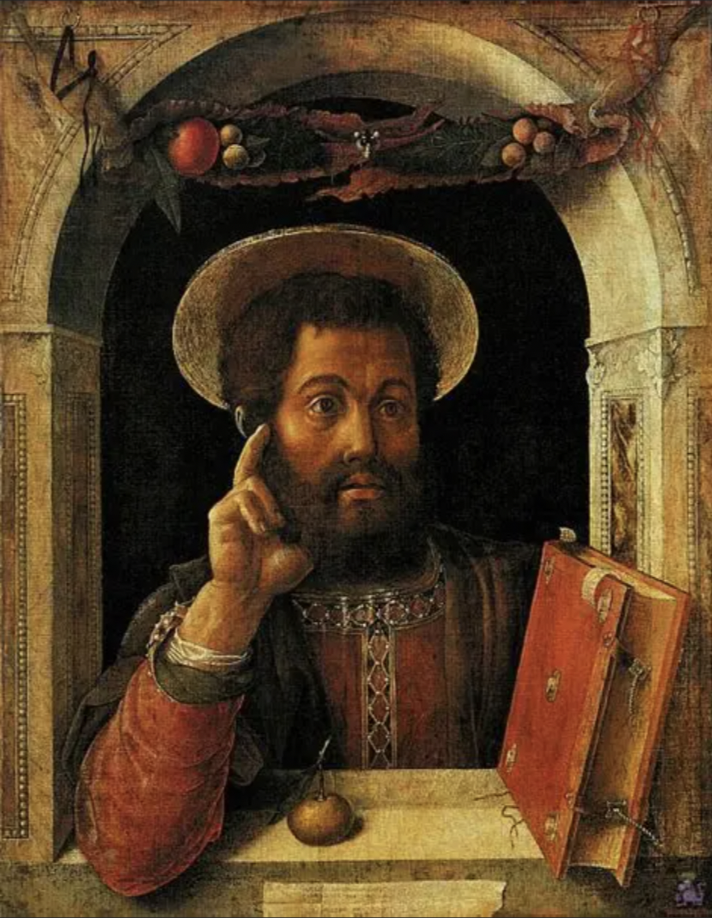
Andrea Mantegna
St Mark, 1448
Mantegna was age 17 the year of this painting, and it was the year he regained his independence after six years in the studio of Francesco Squarcione
Mantegna filed a lawsuit against his former master Squarcione for not paying him for works he had produced under his own name
Attention to light and space
Love for fruit and greenery that are a staple of his paintings
Gospel book to the side
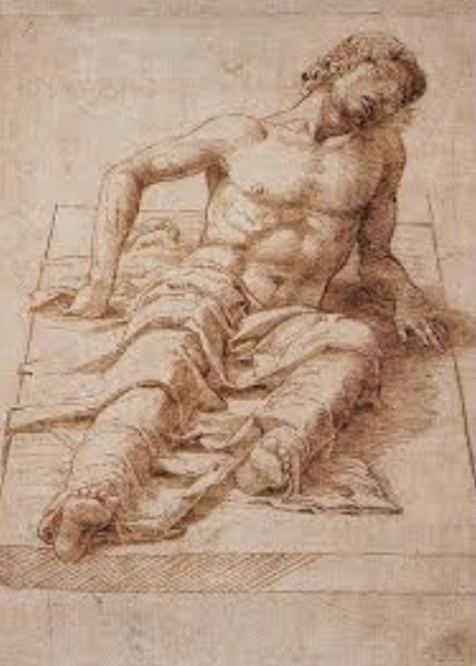
Andrea Mantegna
A Man lying on a stone slab
Pen and brown ink
Gives the impression that someone really is laying in front of us
Copy of Dying Gual, A roman copy from a Greek bronze statue
Chose a high point of view
From technical pov, contour of body, firm lines, but also volume is suggested by strong lines on torso and drapery shows legs
This pose was appreciated
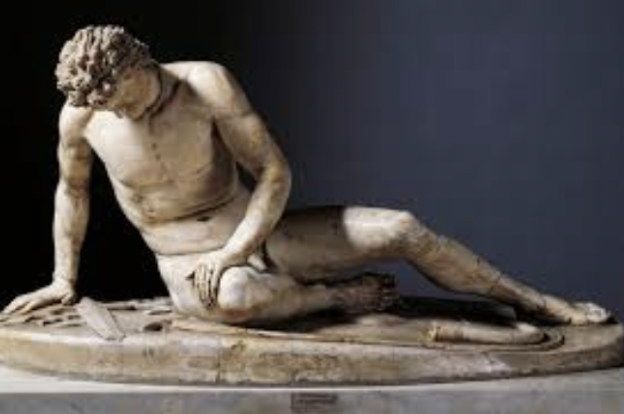
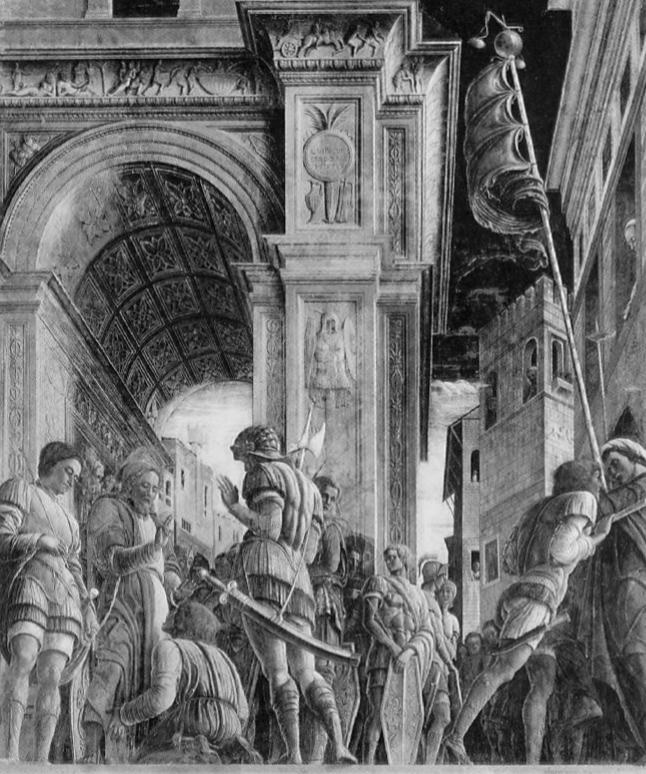
Andrea mantegna
St James led to his Martyrdom
Pen and brown ink
One of the first fresco he painted
Was close to viewers eyes
He chose to create scene taken from point of view that is from the bottom looking up
Difficult practicing this type of perspective
Why this perspective?
Showing off his skills
Sketch of it before
He developed the idea of depicting scene from below over time
Characters mostly stayed the same
Taking a risk by representing the scene from a different point of view
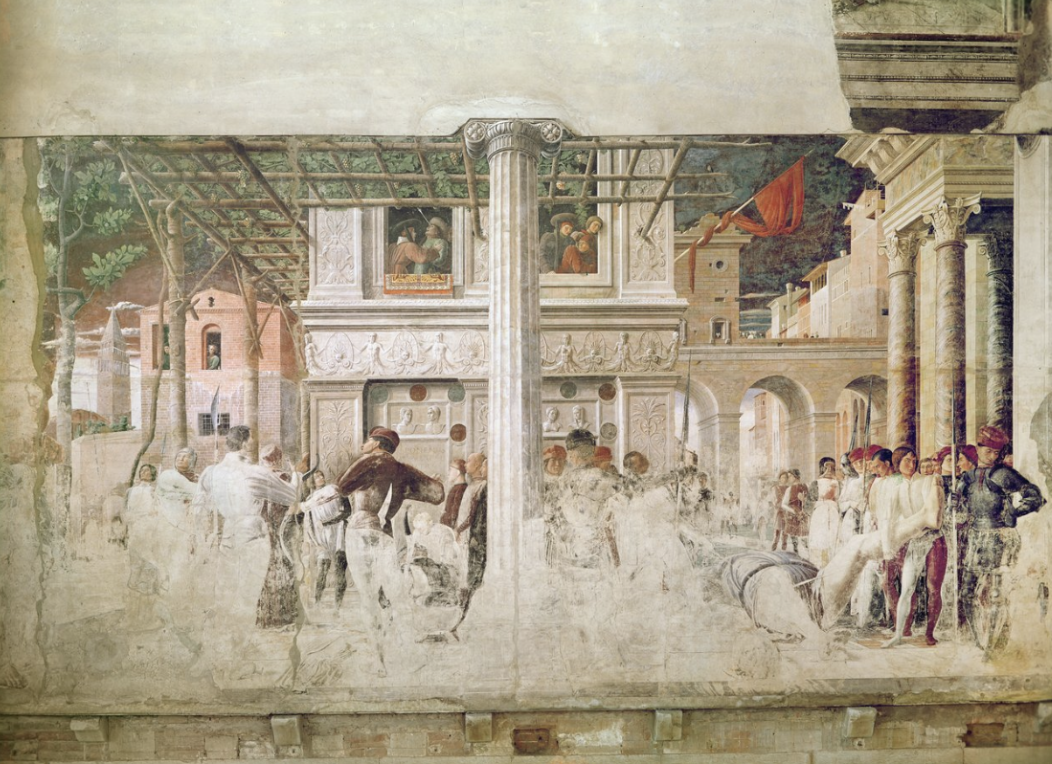
Mantegna
Scenes from the Life of St Christopher: The Martyrdom and the transport of his body
Marble columns, obsession with antiquity evident in this painting
Way Mantegna shapes his groups
As if we are entering from the back of the group
Let’s the audience feel involved by entering the space
People on the outside are watching others struggle to transport the body
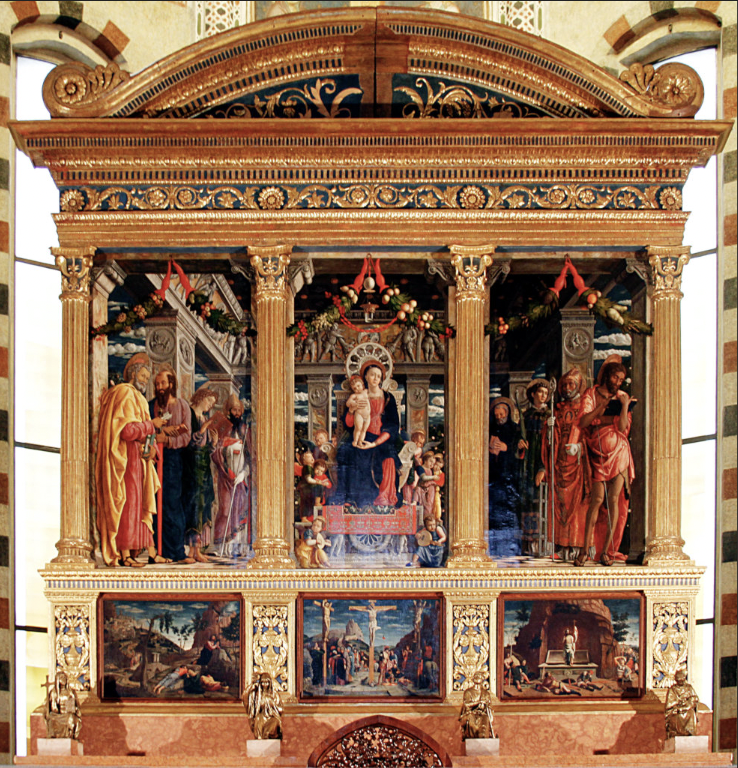
San Zeno Altarpiece
Mantegna
Made to depict a heavenly realm
Unified space and all saints are breathing the same air
Since he had opportunity, he projected the gilded wooden frame as it is a sort of portico
Greenery and fruits present again as this is his signature
Imitation of material is realistic
Visual truth increased importance
Can see a saint covered by a column, shows the true space
Theological space but also physical space where they are really standing and the pillar is able to obstruct our view
Bright colors
Madonna and Child are sitting in the middle on a marble throne surrounded by eight saints
These saints are arranged according to the patron’s preferences
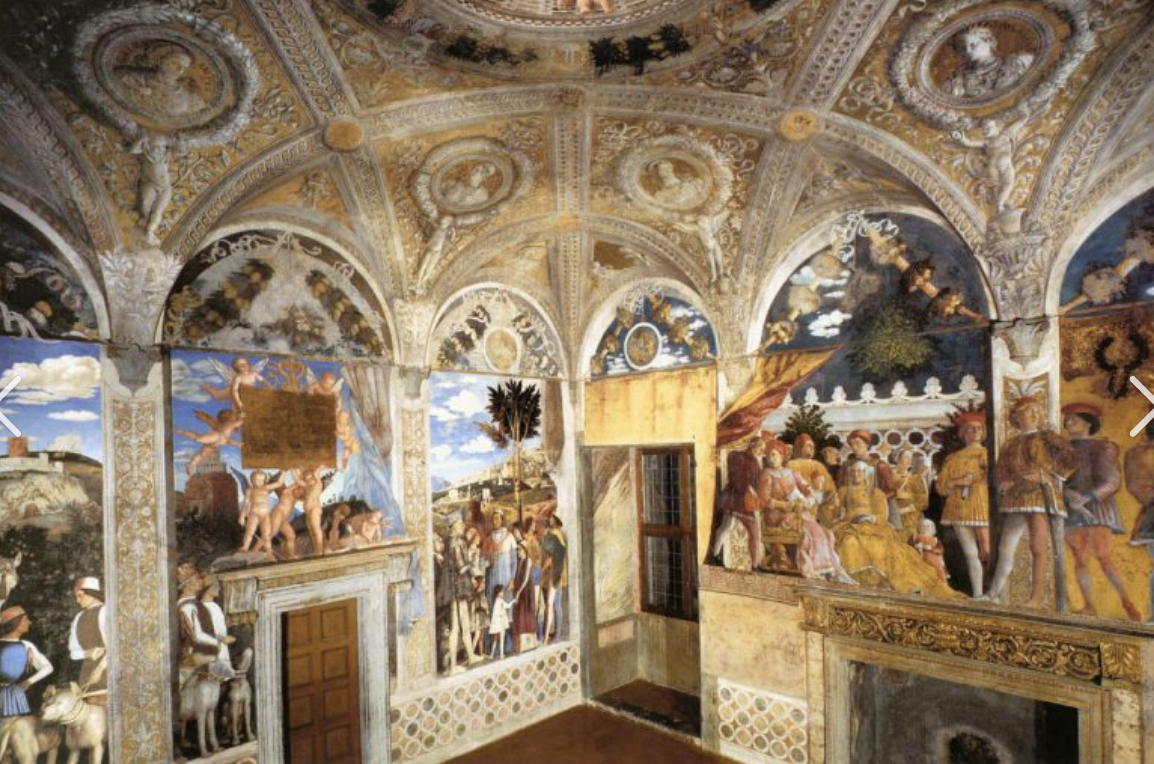
Andrea Mantegna
Bridal Chamber
Bedchambers semi public space
Glory of artist could in some sense be the glory of his patron
mantegna considered as someone who could give him political advantages in a sense, for his own objectives
The space is transformed by a new technique and ability to shape reality on the walls?
How does decoration work? He opens up the walls in a sense because he paints pillars that creates space on the other side with landscapes
Each arch has elements of greenery
Few elements that are not actually painted, the whole room transformed into a painting

West Wall
Andrea Mantegna Bridal Chamber
Landscape with people
Only men or boys because it is a public scene and the public rooms were mostly male rooms at that time
Likely that the reason why this fresco is devoted to meeting has to do with the important moment for Gonzaga family
Meeting between cardinal Francesco and his father Ludovico II
Everyone is recognizable
Francesco first cardinal of the family
Becoming cardinal important because it was a relevant political role, granted access to policy in Rome where high diplomatic issues were discussed. Wealthy appointments because every cardinal had avenues to make money, every subject was asked to pay taxes to the cardinal, and church
Second son had to go for a religious role
Francesco and Ludovico are meeting again after he went to Rome, Mantegna doesn’t want to show emotion or happiness between father and son
Very ritual between them
Nobody is involved in motion,
Idealized quotation of Rome
Rome was hill city, and you can recognize the walls of the city and other roman monuments
Idealized landscape, gives meaning to scene
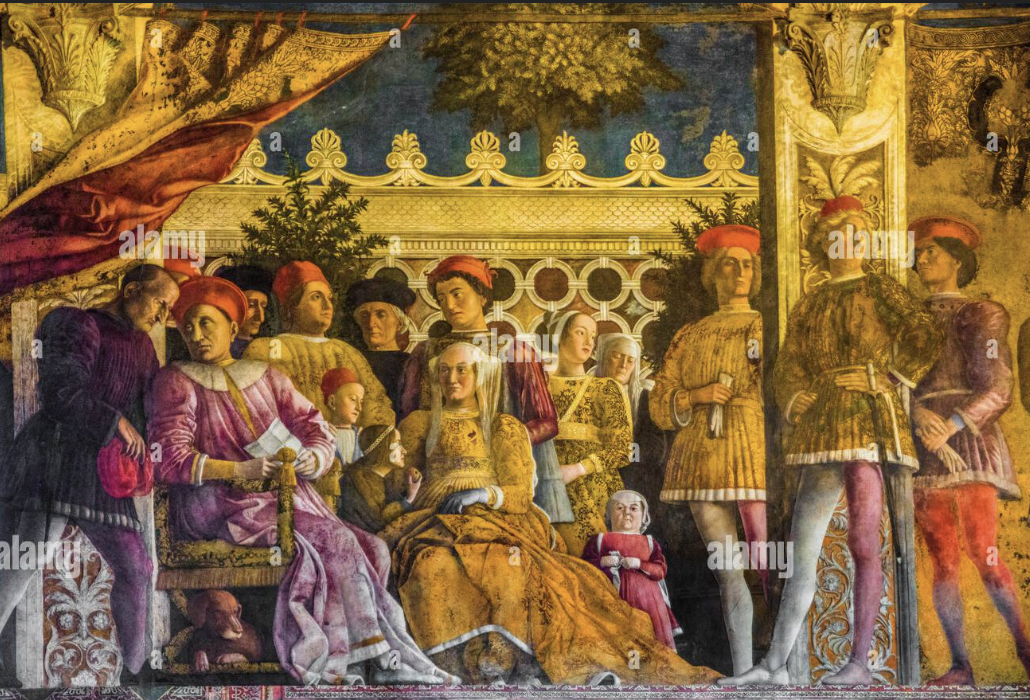
The Court Scene
Andrea Mantegna Bridal Chamber
Snapshot of court of the gonzaga
Stair which starts in the base and goes to upper area where court is gathered, sitting or standing, we don’t know what’s happening in this picture
We can guess it is an election of Ludovico’s second son Federico as a cardinal of the Roman church
Because Ludovico is holding a letter that gives news and he is talking to his secretary
Ludovico’s wife, has many children with him
Everyone is recognizable in this portrait
Meaning? Convince people that this was a lively court full of luxurious habits and things, enjoying their life
Sitting in a sort of garden
Marble boulder, typical renaissance decoration
Court of Gonzaga, with marquis Ludovico II and his wife Barbara of Brandenburg
Barbara is important to Ludovico because her social standing was higher than his so it was a good wedding for him, why she’s distant in a way
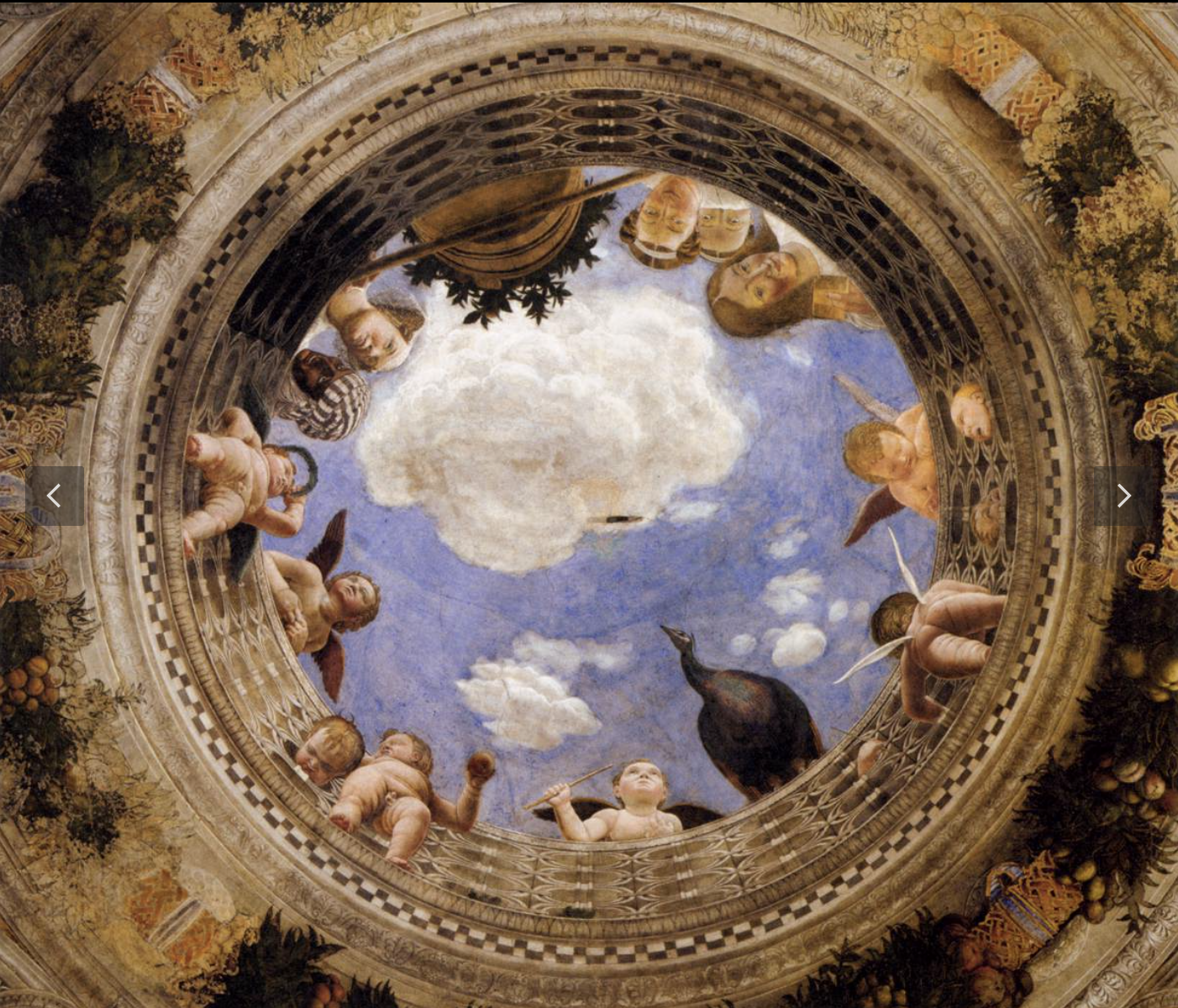
The oculus
Ducal palace
Well known even today
Mantegna had worked hard to improve perspective over time, this is the height of his achievement
Mantegna acheiving perfect light for this fictional space
Women leaning over the railing area
Vase put on the edge
Open above us when we look up
Everything talks about politics even though we don’t know which moment is represented
First to perfect his perspective of the bottom up
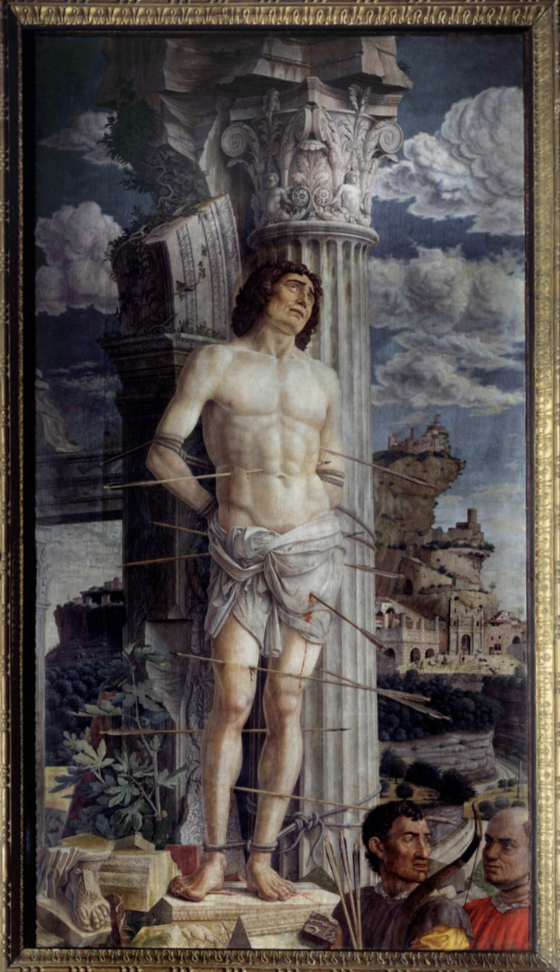
Mantegna
The Martyrdom of St Sebastian
Shows how Mantegna works on religious things
He is not very involved in the religious side
Soldier pierced with arrows while bound by rope
Mantegna shows us how rope is binding his body, remarkable because he wanted to show perfect accurate male body
Study of human anatomy and body structure
More important or at the same level of religious meaning
Also remarkable how St Sebastian is leaning against the pillar, in one sense we understand symbolic meaning of ruins
Ruins of ancient monuments, pagen religion overwhelmed and ending because of Christian religion
Mantegna is more interested in the beautiful ruins and beloved antiquity
He clearly studied the architectural elements of the ruins
Presence of two people that just came from killing St Sebastian
Strange because their faces have a non idealized expression
Since they are bad guys, Mantegna insists on sharp realism

Mantegna
The sacrifice of Isaac
1500 around
Small paintings created on a light canvas
Wealthy people have chapels or rooms decorated with ancient relics which were difficult to purchase because not many to find, so some patrons commissioned sculptures in ancient styles
No marble in the area, so had to spend a lot of money to get marble from quarries, so Mantegna created a third kind, painted instead of using the precious materials
In absence of marble and real ancient relics, good paintings worth it
Imitates the appearance of a sculpture
This technique, with attention to detail and the dramatic poses of the figures creates a grandness and emotional intensity

Mantegna
Sophonisba
Queen of rival of Rome
Sculpted style from Mantegna, seems to carve forms
She is drinking poison that her husband gave to her because she was captured in Rome and will be a slave there, would rather kill herself
Mantegna keeps on dedicating to ancient culture in different ways
Triumphs of caesar
Mantegna
1485-1506
Series of nine large paintings by Mantegna in the Italian Renaissance
They were made for the Gonzaga Ducal Palace, Mantua
Representation of Roman triumph
Used to be ten but now there are 9, tenth was lost
We know the composition of tenth because of witness
Gonzaga family had to create a 30 metre long corridor for it
Don't know who was the commissioner, just know it was Mantegna who painted it
Painted during Francesco’s era
The scenes actually described in very specific and exact way an ancient triumph
All images come from archeological relics, ancient sources, historians
Evident Mantegna was looking at historical truth and helped by other people
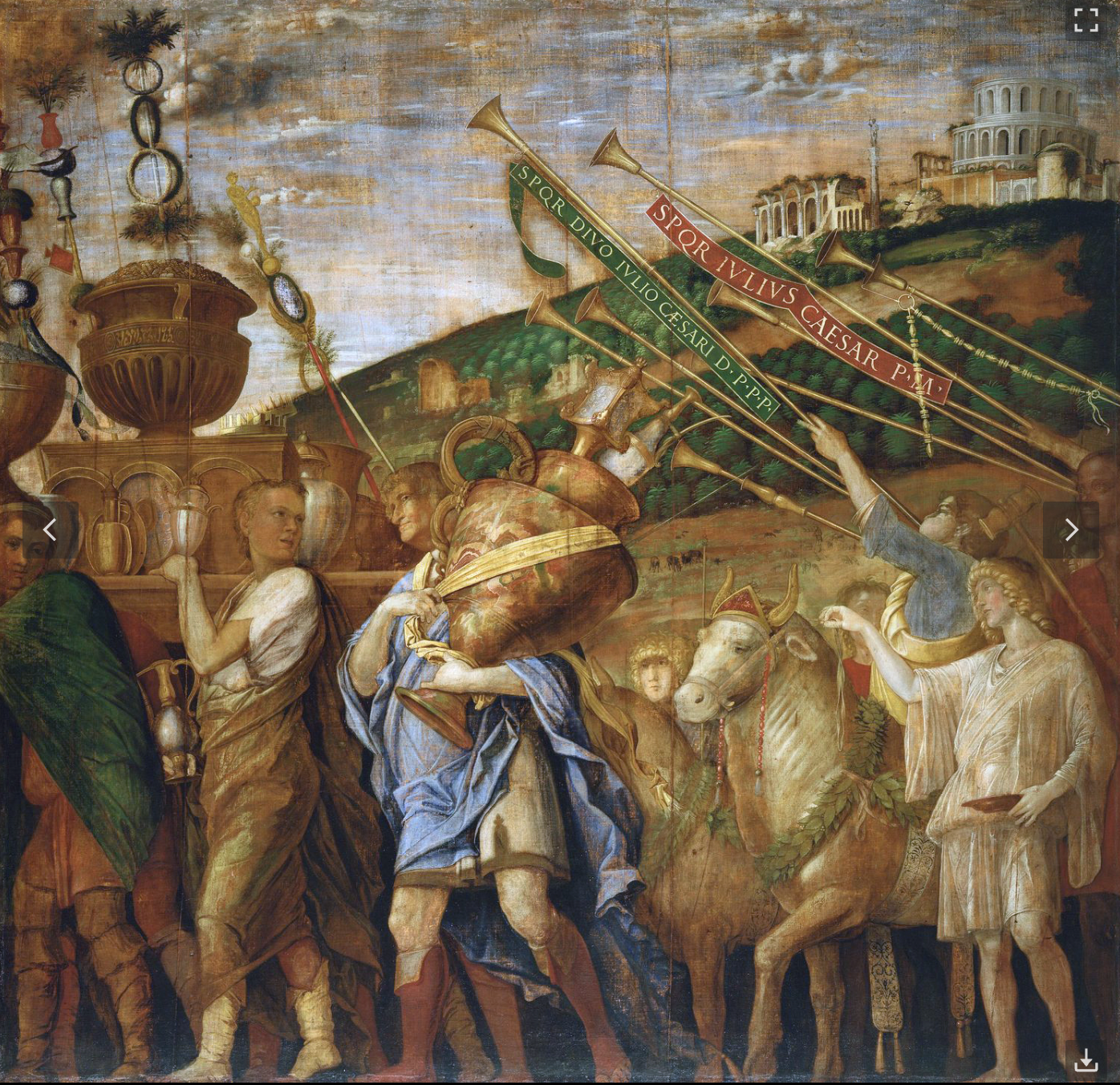
Fourth canvas of Triumphs of Cesar
Bearers of vases, sacrificial bulls, and trumpeters
Celebrate someone who won battle or war in Rome
Where people were killed, because at least 5 thousand victims had t obe part of the achievement to be celebrated by a triumph in Rome
Triumph was dedicated to very few people, rare
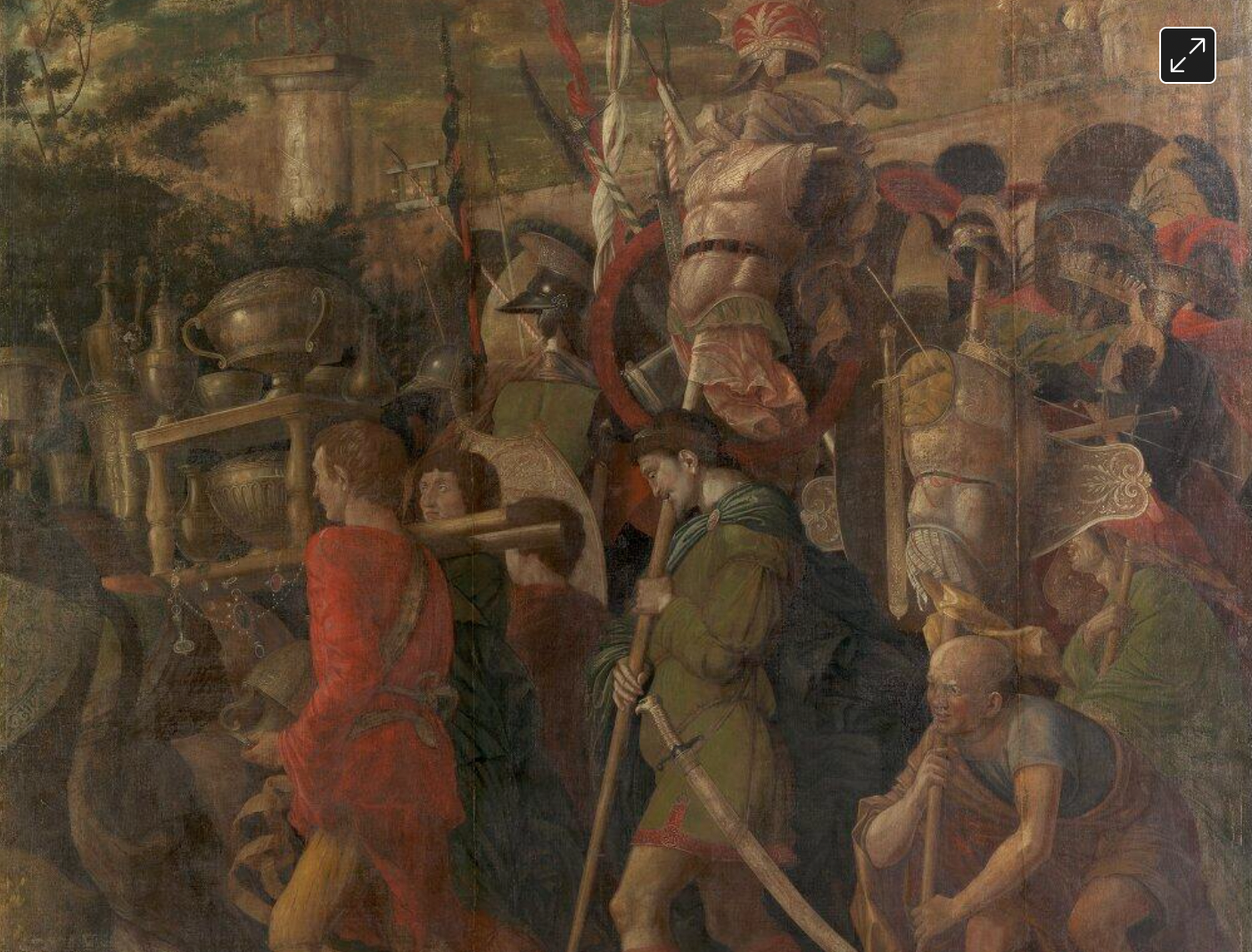
Sixth canvas of Triumphs of Cesar
Procession continues with men bearing the spoils of victory, some almost buckling under the heavy weight
A bare footed bald man crouches down to rest his pole on the ground, his face is red from exhaustian
A group of figures in the upper right corner watch the parade from the top of the aqueduct
On the left is a triumphal column, topped by a gilt statue of a mounted general
Seems as though the people are passing in front of us
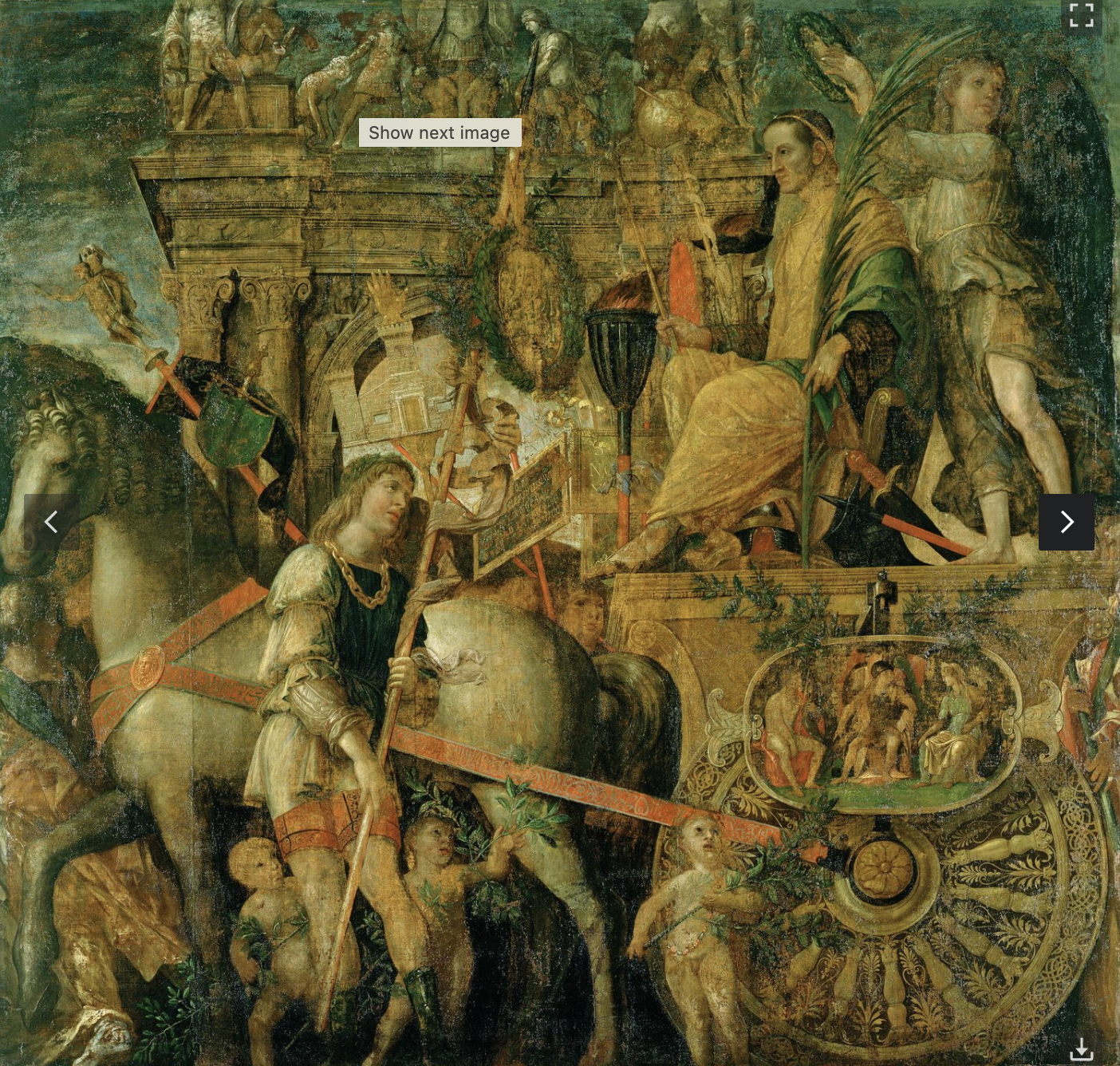
Ninth canvas of Triumphs of Cesar
Julius Caesar on the triumphal chariot
Ducal palace
Mantegna
At the end of the procession
Protagonist in the last canvas
No possibility to understand who commissioned this
No reference to the Gonzaga family, politics, current events
Completely archaeological and historical reconstruction
Victory at his shoulders, don't forget you are only a man
Humbling their leader
Andrea del Verrocchio and Leonardo da Vinci
Father allowed Da Vinci to learn under Verrocchio
Trained as a painter then a sculpture
Generous master because when leonardo, after 3 years apprenticeship, he was an independent artist and could work by himself
He worked by himself but kept on working under commercial umbrella of Verrocchio’s workshop
Helped with working conditions, finding work, etc
Successful man who was kind to other people
Verrocchio considered someone who could offer a gift to a king far from florence
Leonardo da Vinci
Father allowed him to learn under Verrocchio in his workshop
3 years apprenticeship, he was an independent artist and could work by himself
He worked by himself but kept on working under commercial umbrella of Verrocchio’s workshop
Helped with working conditions, finding work, etc
First trained in drawing
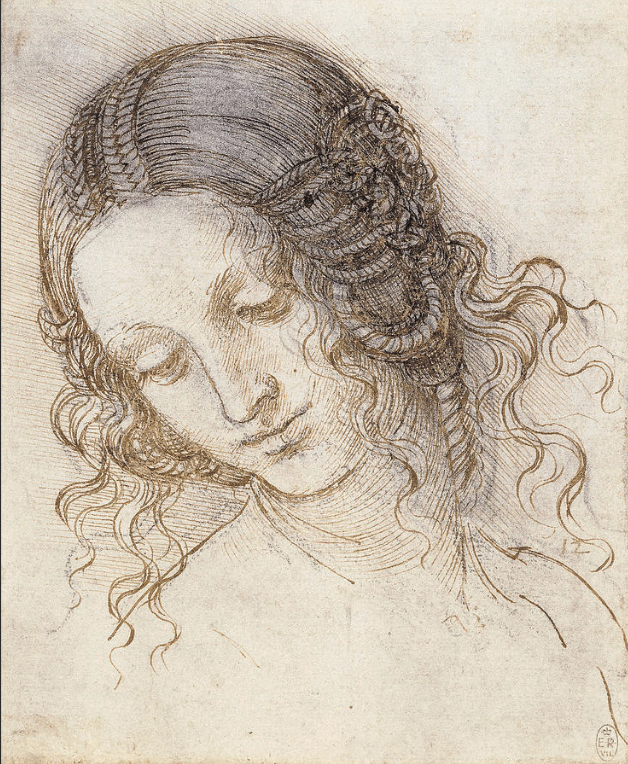
Leonardo da Vinci
Study of a woman’s head
Metal point, pen and brown ink, highlighted with white gouache
Drawing looked down upon but in Florence drawing basis for everything, meant studying things, becoming expert in all techniques, and becoming master in all types of art
Highly meticulous
Technique was metal point which is very difficult because when you work with metalpoint there are subtle lines and any mistakes made are impossible to get rid of
Hair is perfectly rendered around her
Style which is slight and detailed
Particular of hair, jewels, mouth, nose, and subtle shadows of her face
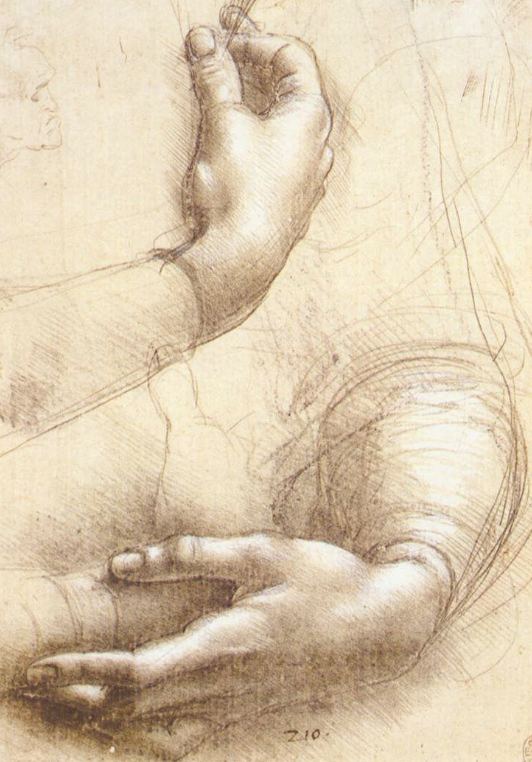
Study of a woman’s hands
Leonardo da Vinci
Charcoal, metalpoint, white heightening on prepared paper
Hatching on her hands to give much more density to the volume in order to keep her impression of three dimensional hands
Hands have some resemblance to the girl in the lady with the bouquet, could be preparatory for the sculpture or could be drawing it with inspiration from the sculpture
Reaching great result with realism